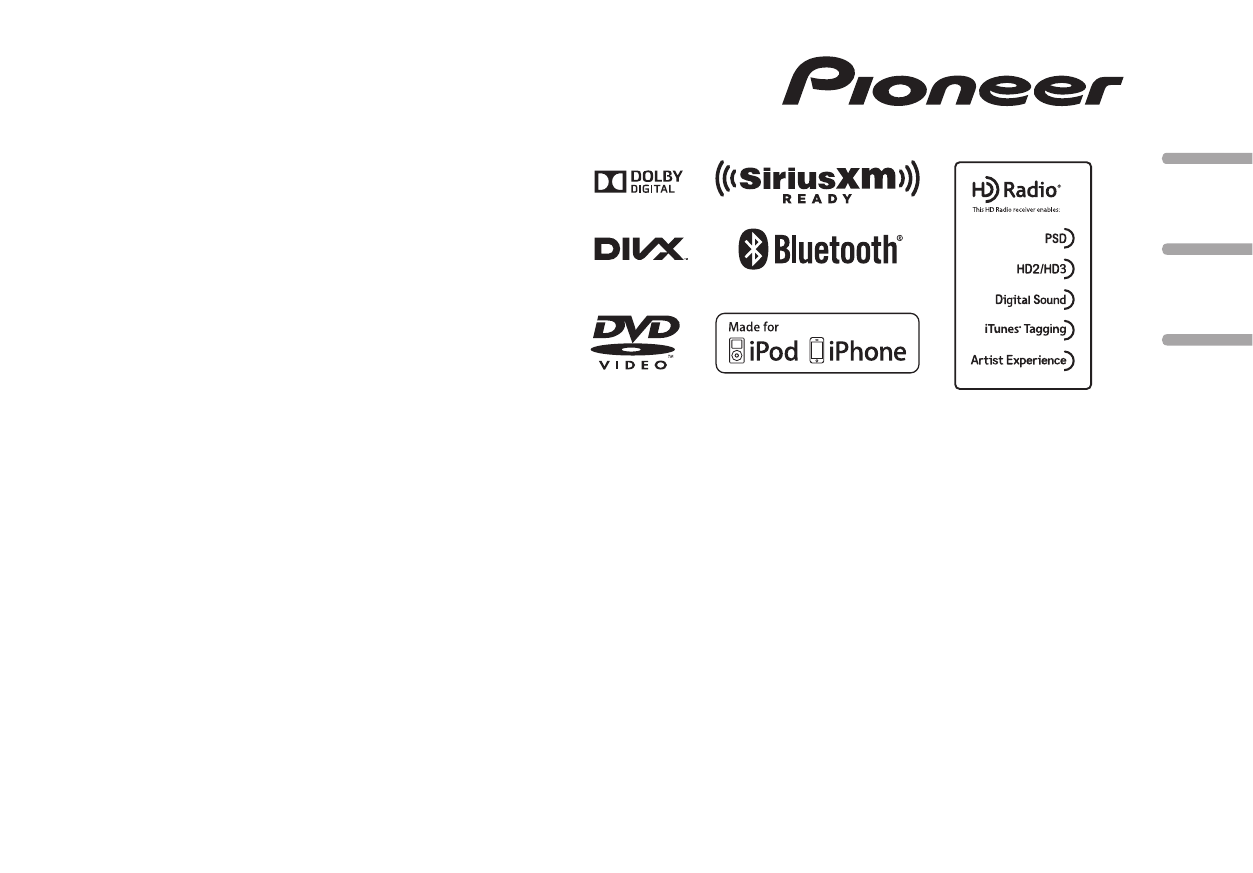Pioneer K058 DVD AV RECEIVER User Manual Short Term Confidential
Pioneer Corporation DVD AV RECEIVER Short Term Confidential
Pioneer >
Contents
- 1. [Short Term Confidential]User Manual
- 2. [Short Term Confidential]User Manual_FR
[Short Term Confidential]User Manual
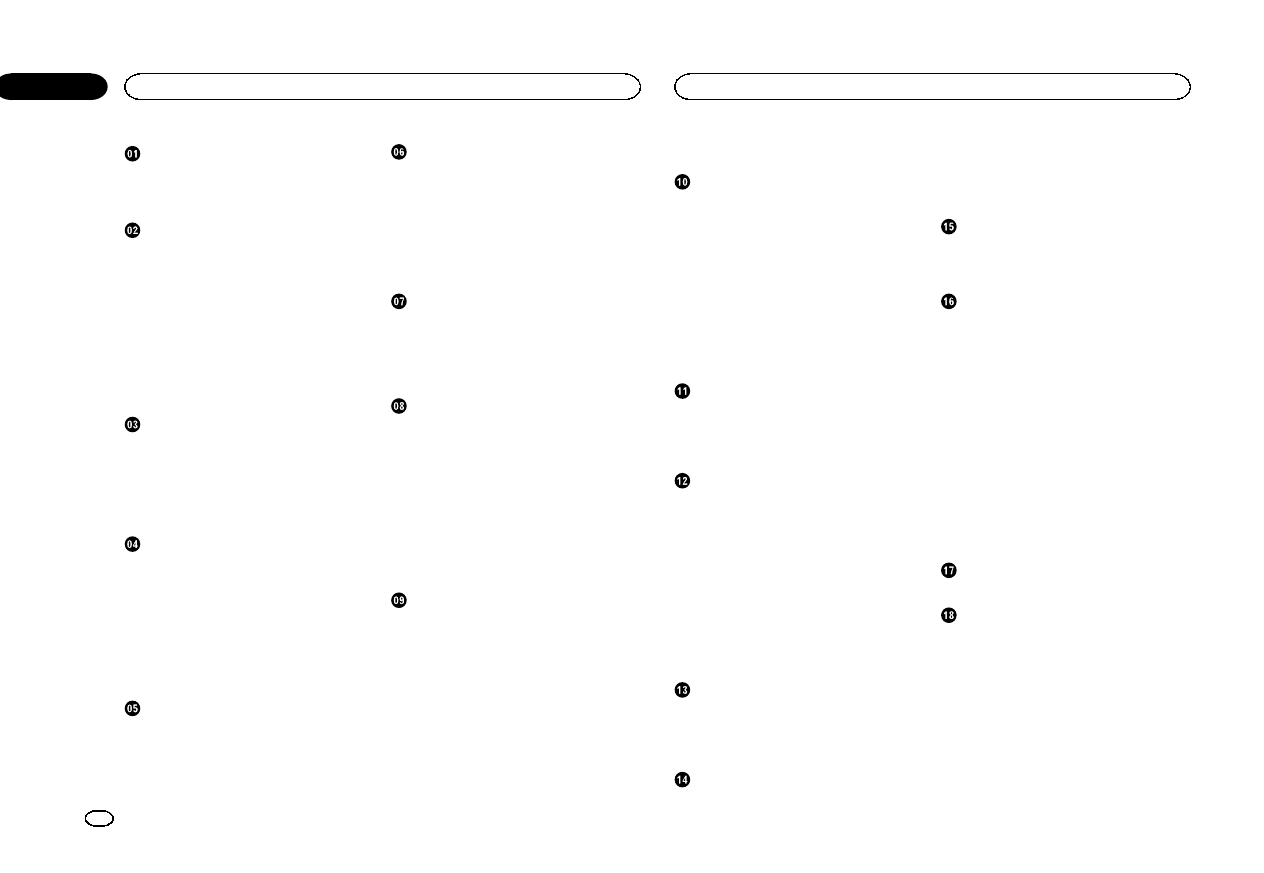
Precautions
IMPORTANT SAFEGUARDS 4
To ensure safe driving 4
To avoid battery exhaustion 4
Before you start
Information to User 5
The Safety of Your Ears is in Your
Hands 5
About this unit 5
DVD video disc region numbers 6
About this manual 6
After-sales service for Pioneer
products 6
Visit our website 6
Use and care of the remote control 6
Demo mode 6
What’s what
Head unit 7
Home display 7
Turning the source ON/OFF 8
Selecting a source 8
Adjusting the volume 8
Remote control 8
Common operations
Common operations for menu settings/
lists 9
Operating the scroll icon and the scrubber
bar 9
Activating the touch panel keys 10
Using the rear view 10
Using the rear monitor 10
Using sound retriever 10
Changing the wide-screen mode 10
Basic operations
Adjusting the angle of the LCD panel and
ejecting media 11
Setting the clock 11
HD Radioätuner
About HDRadioästations 11
HDRadio tuner operations 11
Storing and recalling stations 12
Storing the strongest stations 12
Tuning in to strong signals 12
Using iTunes tagging 12
Switching the seek mode 12
Switching the reception mode 12
Tuner
Tuner operations 13
Storing and recalling stations 13
Storing the strongest stations 13
Tuning in to strong signals 13
Using iTunes tagging 13
SiriusXM tuner
Introducing SiriusXM tuner
operations 14
Storing and recalling stations 14
Selecting a channel from the SiriusXM
channel list display 14
Switching the list display 15
Selecting a SiriusXM channel directly 15
Using iTunes tagging 15
Setting Parental Control 15
Setting SiriusXM Tune Startä16
Scan play 16
Disc (CD/DVD)
Introducing movie operations 16
Sound playback operations 17
Switching the media file type 18
Operating the DVD menu 18
Random play (shuffle) 18
Repeating playback 18
Searching for the part you want to
play 18
Selecting audio output 19
PBC playback 19
Selecting tracks from the track title
list 19
Selecting files from the file name list 19
Playing DivXâVOD content 19
iPod
Moving images operations 20
Sound playback operations 20
Using this unit’s iPod function from your
iPod 20
Shuffle play 21
Repeating playback 21
Playing videos from your iPod 21
Browsing for a video/music on the
iPod 21
Changing audiobook speed 22
Displaying lists related to the song currently
playing (link search) 22
Advanced App Mode
Advanced App Mode operation 22
Starting procedure 22
Setting the Keyboard 23
Setting the App sound mixing 23
USB
Moving images operations 23
Sound playback operations 24
Music browse mode 24
Still image playback operations 24
Switching the media file type 25
Random play (shuffle) 25
Repeating playback 25
Selecting files from the file name list 25
Displaying lists related to the song currently
playing (link search) 25
Playing DivXâVOD content 25
Capture an image in JPEG files 25
Bluetooth Audio
Sound playback operations 26
Setting up for Bluetooth audio 26
Random play (shuffle) 26
Repeating playback 26
Using MIXTRAX
MIXTRAX operation 27
MIXTRAX EZ operation 27
Starting MIXTRAX EZ operation 27
Setting MIXTRAX mode 27
Setting the effect 27
Using Pandoraâinternet radio
Pandora operations 28
Selecting and playing Pandoraâstations/
shuffle 29
Bluetooth telephone
Bluetooth telephone operations 29
Calling a number in the phone book 30
Selecting a number by alphabet search
mode 30
Inverting names in phone book 31
Using the missed, received and dialed call
lists 31
Setting automatic answering 31
Adjusting the other party’s listening
volume 31
Switching the ring tone 31
Using the preset dial lists 31
Making a call by entering phone
number 31
Setting the private mode 31
Voice control 32
Settings
Menu operations 32
Audio adjustments
Using fader/balance adjustment 33
Using balance adjustment 33
Using the equalizer 33
Using the auto-equalizer 33
Using sonic center control 33
Adjusting loudness 34
Using subwoofer output 34
Boosting the bass 34
Using the high pass filter 34
Adjusting source levels 34
Contents
2
Contents
En
<CRD4703-A/N>2

Setting up the video player
Setting the subtitle language 35
Setting the audio language 35
Setting the menu language 35
Setting the multi-angle DVD display 35
Setting the aspect ratio 35
Setting the slideshow interval 35
Setting parental lock 36
Setting the DivX subtitle file 36
Displaying the DivXâVOD registration
code 36
Automatic playback of DVDs 37
System settings
Switching the auxiliary setting 37
Setting AV input 37
Setting the RGB Input 37
Setting the App sound mixing 37
Setting MIXTRAX mode 37
Changing the picture adjustment 37
Selecting the system language 38
Setting SiriusXM Tune Startä38
Setting Demo Mode 38
Switching sound muting/attenuation 38
Setting the rear output and subwoofer
controller 38
Using the keyboard 38
Setting the ever scroll 39
Setting the Pandora connect mode 39
Setting the Bluetooth audio 39
Clearing Bluetooth memory 39
Updating Bluetooth connection
software 39
Displaying the Bluetooth system
version 39
Setting the rear view camera (back up
camera) 39
Auto EQ (auto-equalizing) 40
Setting the video signal 41
Favorite menu
Using the Favorite menu 41
Bluetooth connection menu
Bluetooth connection menu
operations 42
Theme menu
Selecting the illumination color 43
Selecting the OSD (on-screen display)
color 43
Selecting the background display 43
Other functions
Adjusting the response positions of the
touch panels (Touch Panel
Calibration) 43
Using an AUX source 43
Resetting the microprocessor 44
Connection
Connecting the power cord 46
When connecting to separately sold power
amp 47
When connecting the external video
component and the display 47
When connecting with a rear view
camera 48
Optional SiriusXM Tuner connection 48
Installation
Installation using the screw holes on the
side of the unit 49
Installing the microphone 50
Additional information
Troubleshooting 51
Error messages 53
Understanding auto EQ error
messages 56
Understanding messages 56
Indicator list 57
Handling guidelines 58
Compressed audio compatibility
(USB) 59
Compressed audio compatibility (disc,
USB) 59
iPod compatibility 60
Sequence of audio files 61
Using the display correctly 61
Bluetooth profiles 61
License, Warranty Disclaimer & Limitation of
Liability 62
Language code chart for DVD 64
Specifications 65
English
Contents
3
Contents
En
<CRD4703-A/N>3
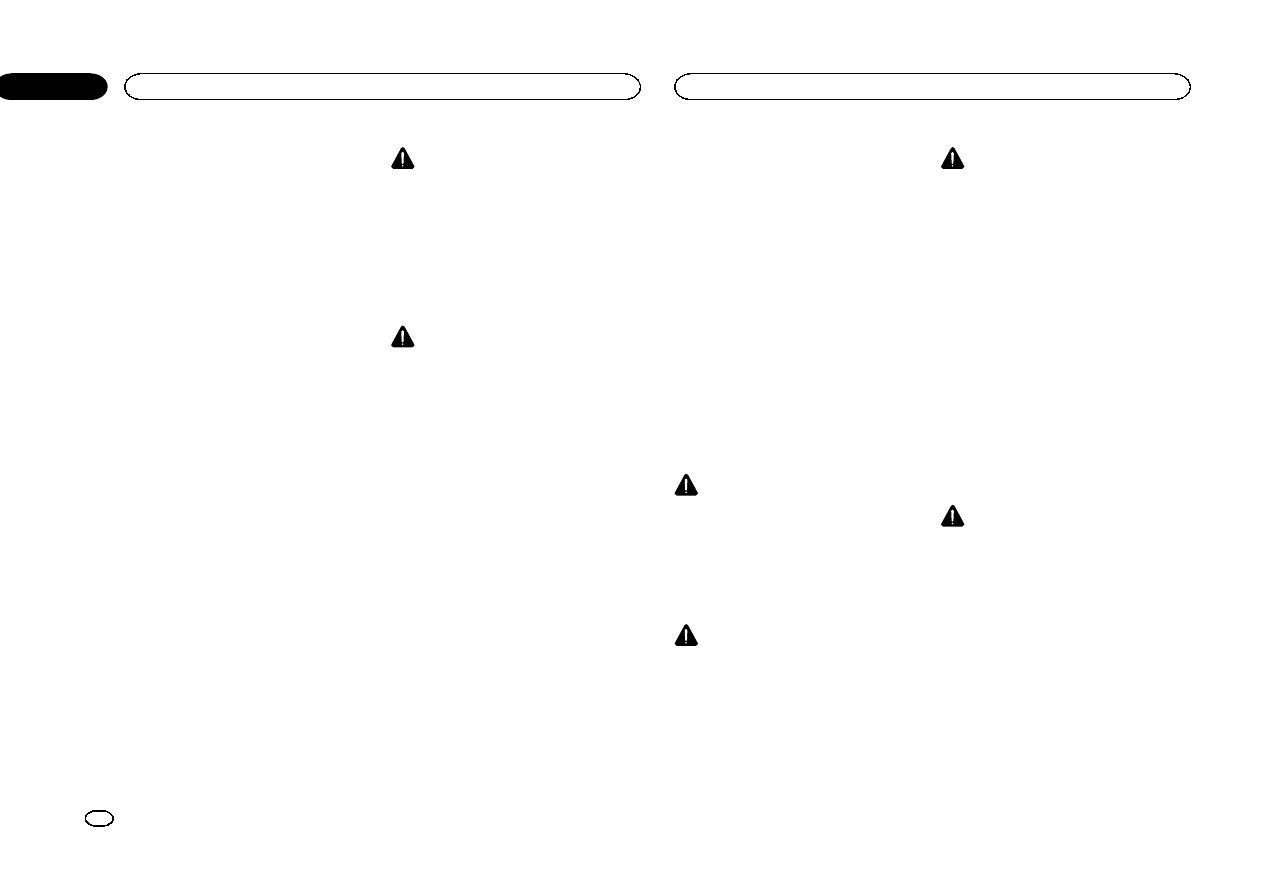
Thank you for purchasing this PIONEER
product.
To ensure proper use, please read through this
manual before using this product. It is especially
important that you read and observe WARN-
INGs and CAUTIONs in this manual. Please
keep the manual in a safe and accessible place for
future reference.
IMPORTANT SAFEGUARDS
Please read all of these instructions regarding
your display and retain them for future refer-
ence.
1Do not install the display where it may
(i) obstruct the driver’s vision, (ii) impair
the performance of any of the vehicle’s
operating systems or safety features, in-
cluding air bags, hazard lamp buttons or
(iii) impair the driver’s ability to safely
operate the vehicle.
2Do not operate this display if doing so in
any way will divert your attention from
the safe operation of your vehicle. Al-
ways observe safe driving rules and fol-
low all existing traffic regulations. If you
experience difficulty in operating the
system or reading the display, park your
vehicle in a safe location and make nec-
essary adjustments.
3Please remember to wear your seat belt
at all times while operating your vehicle.
If you are ever in an accident, your inju-
ries can be considerably more severe if
your seat belt is not properly buckled.
4Never use headphones while driving.
5To promote safety, certain functions are
disabled unless the parking brake is on,
and the vehicle is not in motion.
6Never set the volume of your display so
high that you cannot hear outside traffic
and emergency vehicles.
WARNING
Do not attempt to install or service your dis-
play by yourself. Installation or servicing of
the display by persons without training and
experience in electronic equipment and au-
tomotive accessories may be dangerous
and could expose you to the risk of electric
shock or other hazards.
To ensure safe driving
WARNING
!LIGHT GREEN LEAD AT POWER CONNEC-
TOR IS DESIGNED TO DETECT PARKED
STATUS AND MUST BE CONNECTED TO
THE POWER SUPPLY SIDE OF THE PARK-
ING BRAKE SWITCH. IMPROPER CON-
NECTION OR USE OF THIS LEAD MAY
VIOLATE APPLICABLE LAW AND MAY RE-
SULT IN SERIOUS INJURY OR DAMAGE.
!To avoid the risk of damage and injury and the
potential violation of applicable laws, this unit is
not for use with a video screen that is visible to
the driver.
!To avoid the risk of accident and the potential vio-
lation of applicable laws, no viewing of front seat
video should ever occur while the vehicle is
being driven.
!In some countries or states the viewing of images
on a display inside a vehicle even by persons
other than the driver may be illegal. Where such
regulations apply, they must be obeyed and this
unit’s video features should not be used.
When you attempt to watch a video image while
driving, the warning “Viewing of front seat
video source while driving is strictly prohib-
ited.”will appear on the front display.
To watch a video image on the front display, park
your vehicle in a safe place and apply the park-
ing brake.
Parking brake interlock
Certain functions (Video viewing and certain
touch panel keys) offered by this unit could be
dangerous and/or unlawful if used while driving.
To prevent such functions from being used while
the vehicle is in motion, there is an interlock sys-
tem that senses when the parking brake is set. If
you attempt to use the functions described
above while driving, they will become disabled
until you stop the vehicle in a safe place, and (1)
apply the parking brake, (2) release the parking
brake, and then (3) apply the parking brake
again. Please keep the brake pedal pushed
down before releasing the parking brake.
When using a display connected
to rear monitor output
The rear monitor output on this unit (V OUT)is
used to connect a rear display that allows pas-
sengers in the rear seats to watch videos.
WARNING
NEVER install the rear display in a location
where the driver can watch videos while driving.
When using the rear view camera
With an optional rear view camera, this unit can
be used as an aid to keep an eye on trailers, or
when backing into a tight parking spot.
WARNING
!SCREEN IMAGE MAY APPEAR RE-
VERSED.
!USE INPUT ONLY FOR REVERSE OR
MIRROR IMAGE REAR VIEW CAMERA.
OTHER USE MAY RESULT IN INJURY
OR DAMAGE.
CAUTION
!The rear view camera function is to be used
as an aid to keep an eye on trailers, or while
backing up. Do not use for entertainment
purposes.
!Please note that the edges of the rear view
camera images may differ slightly according
to whether full screen images are displayed
when backing up, and whether the images
are used for checking the rear when the ve-
hicle is moving forward.
To avoid battery exhaustion
Keep the vehicle engine running when using
this unit to avoid draining the battery power.
!When no power is supplied to this unit, such
as when the vehicle battery is being re-
placed, the microcomputer of this unit re-
turns to its initial condition. We recommend
that you transcribe the audio adjustment
data.
WARNING
Do not use with vehicles that do not feature an
ACC position.
Precautions
4
Section
Precautions
En
01
<CRD4703-A/N>4
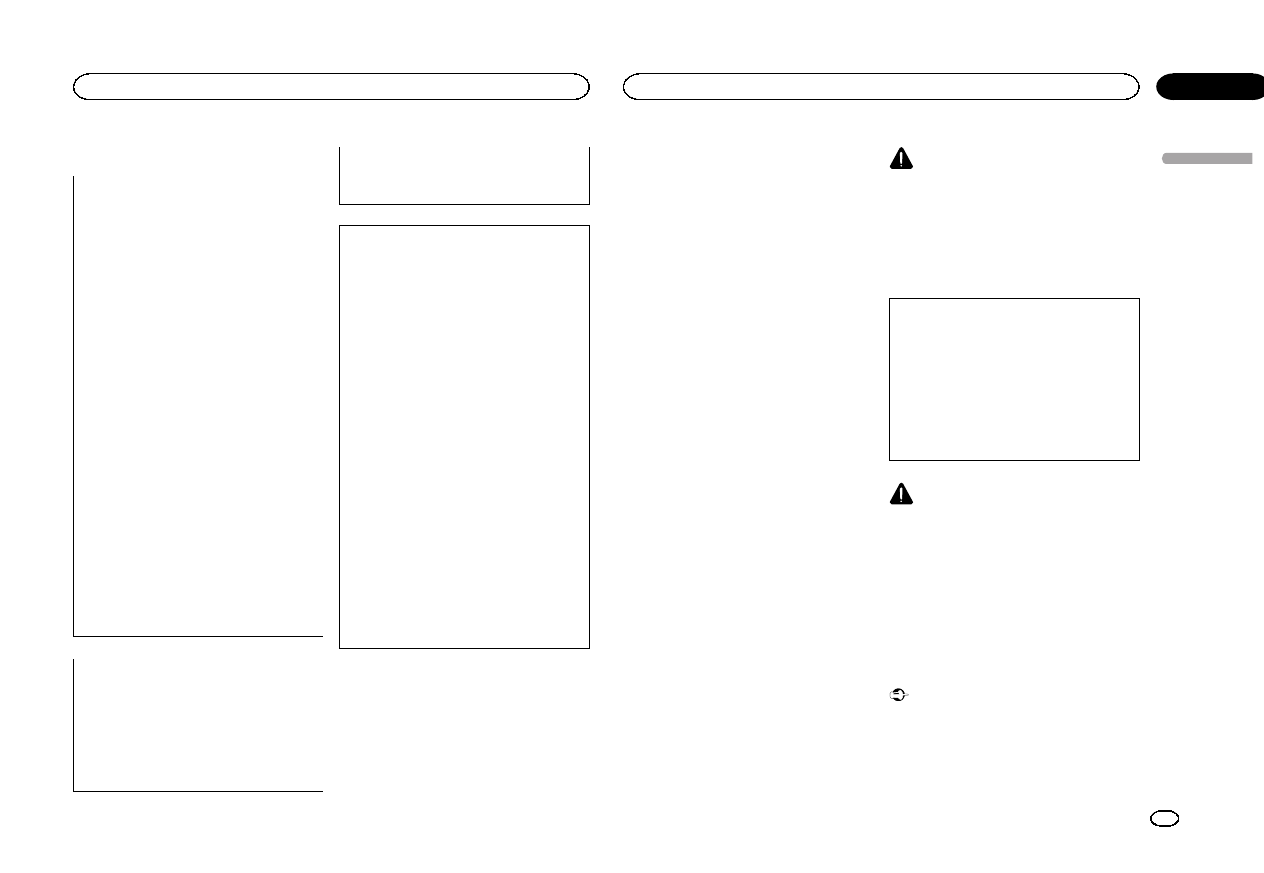
Information to User
FCC ID: AJDK058
MODEL NO.: AVH-X5500BHS, AVH-X4500BT,
AVH-X3500BHS, AVH-X2500BT
IC: 775E-K058
This device complies with Part 15 of FCC
Rules and Industry Canada licence-exempt
RSS standard(s). Operation is subject to the
following two conditions: (1) this device may
not cause interference, and (2) this device
must accept any interference, including inter-
ference that may cause undesired operation
of this device.
This transmitter must not be co-located or op-
erated in conjunction with any other antenna
or transmitter.
The antenna for Bluetooth cannot be removed
(or replaced) by user.
This equipment complies with FCC/IC radia-
tion exposure limits set forth for an uncon-
trolled environment and meets the FCC radio
frequency (RF) Exposure Guidelines in Sup-
plement C to OET65 and RSS-102 of the IC
radio frequency (RF) Exposure rules. This
equipment has very low levels of RF energy
that it deemed to comply without maximum
permissive exposure evaluation (MPE). But it
is desirable that it should be installed and op-
erated keeping the radiator at least 20 cm or
more away from person’s body (excluding ex-
tremities: hands, wrists, feet and ankles).
MODEL NO.: AVH-X1500DVD
This device complies with Part 15 of the FCC
Rules. Operation is subject to the following
two conditions:
(1) this device may not cause harmful interfer-
ence, and (2) this device must accept any in-
terference received, including interference
that may cause undesired operation.
Alteration or modifications carried out with-
out appropriate authorization may invalidate
the user’s right to operate the equipment.
Note
This equipment has been tested and found
to comply with the limits for a Class B digital
device, pursuant to Part 15 of the FCC Rules.
These limits are designed to provide reason-
able protection against harmful interference
in a residential installation. This equipment
generates, uses and can radiate radio fre-
quency energy and, if not installed and used
in accordance with the instructions, may
cause harmful interference to radio commu-
nications. However, there is no guarantee
that interference will not occur in a particu-
lar installation. If this equipment does cause
harmful interference to radio or television re-
ception, which can be determined by turning
the equipment off and on, the user is encour-
aged to try to correct the interference by one
or more of the following measures:
- Reorient or relocate the receiving antenna.
- Increase the separation between the equip-
ment and receiver.
- Connect the equipment into an outlet on a
circuit different from that to which the re-
ceiver is connected.
- Consult the dealer or an experienced radio/
TV technician for help.
The Safety of Your Ears is in
Your Hands
Get the most out of your equipment by playing it
at a safe level—a level that lets the sound come
through clearly without annoying blaring or dis-
tortion and, most importantly, without affecting
your sensitive hearing. Sound can be deceiving.
Over time, your hearing “comfort level”adapts to
higher volumes of sound, so what sounds “nor-
mal”can actually be loud and harmful to your
hearing. Guard against this by setting your
equipment at a safe level BEFORE your hearing
adapts.
ESTABLISH A SAFE LEVEL:
!Set your volume control at a low setting.
!Slowly increase the sound until you can hear
it comfortably and clearly, without distortion.
!Once you have established a comfortable
sound level, set the dial and leave it there.
BE SURE TO OBSERVE THE
FOLLOWING GUIDELINES:
!Do not turn up the volume so high that you
can’t hear what’s around you.
!Use caution or temporarily discontinue use
in potentially hazardous situations.
!Do not use headphones while operating a
motorized vehicle; the use of headphones
may create a traffic hazard and is illegal in
many areas.
About this unit
The tuner frequencies on this unit are allocated
for use in North America. Use in other areas
may result in poor reception.
WARNING
Handling the cord on this product or cords asso-
ciated with accessories sold with the product
may expose you to chemicals listed on proposi-
tion 65 known to the State of California and
other governmental entities to cause cancer and
birth defect or other reproductive harm. Wash
hands after handling.
CAUTION:
USE OF CONTROL OR ADJUSTMENT OR
PERFORMANCE OF PROCEDURES
OTHER THAN THOSE SPECIFIED HEREIN
MAY RESULT IN HAZARDOUS RADIATION
EXPOSURE.
CAUTION:
THE USE OF OPTICAL INSTRUMENTS
WITH THIS PRODUCT WILL INCREASE
EYE HAZARD.
CAUTION
!Do not allow this unit to come into contact
with liquids. Electrical shock could result.
Also, damage to this unit, smoke, and over-
heating could result from contact with
liquids.
!Keep this manual handy for future reference.
!Always keep the volume low enough to hear
outside sounds.
!Avoid exposure to moisture.
!If the battery is disconnected or discharged,
any preset memory will be erased.
Important (Serial number)
The serial number is located on the bottom of
this unit. For your own security and conven-
ience, be sure to record this number on the en-
closed warranty card.
English
Before you start
5
Section
Before you start
En
02
<CRD4703-A/N>5
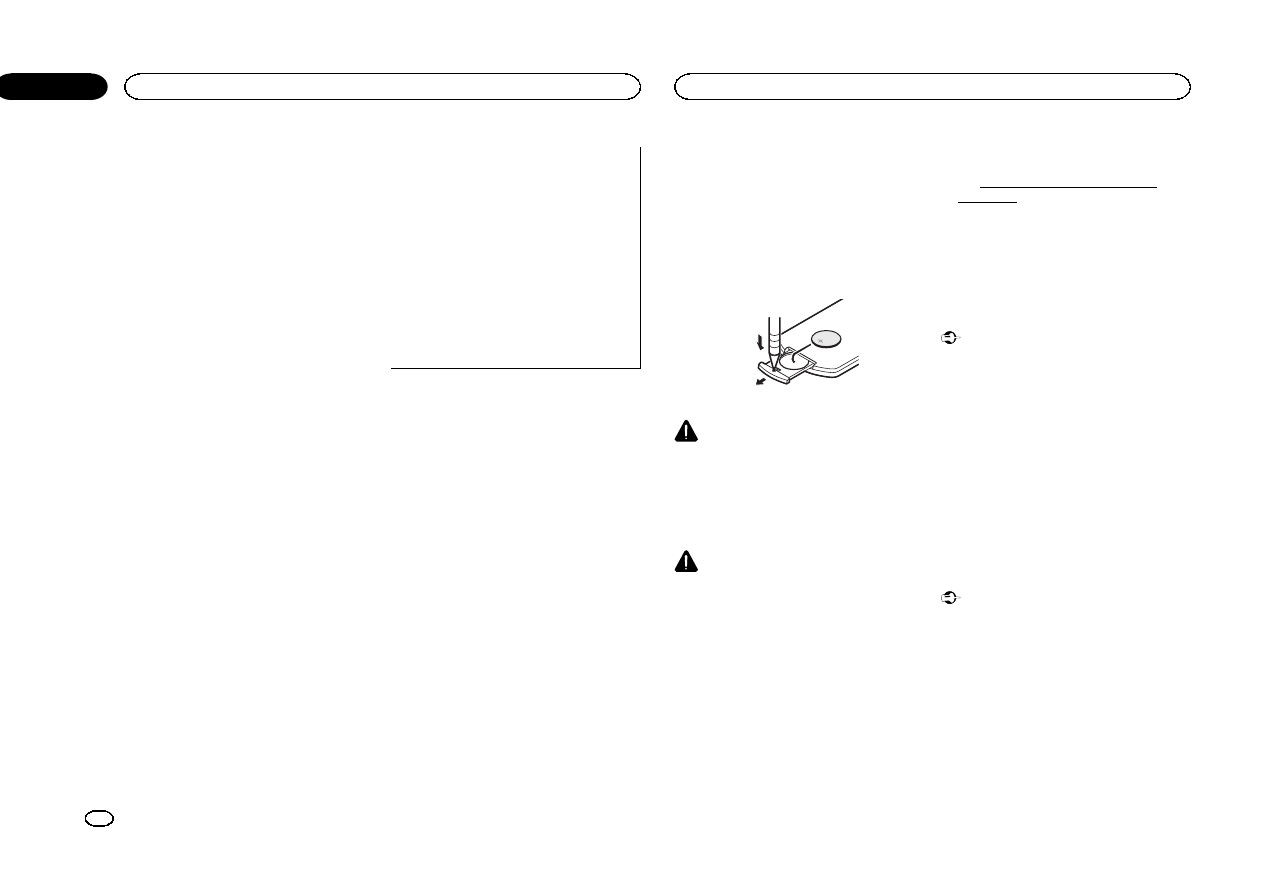
DVD video disc region numbers
Only DVD video discs with compatible region
numbers can be played on this player. You can
find the region number of the player on the bot-
tom of this unit and in this manual (refer to
Specifications on page 65).
About this manual
!This unit features a number of sophisticated
functions to ensure superior reception and
operation. All the functions have been de-
signed for the easiest possible use, but many
are not self-explanatory. This operation man-
ual will help you benefit fully from this unit’s
potential and to maximize your listening en-
joyment.
!This manual uses diagrams of actual screens
to describe operations. However, the screens
on some units may not match those shown
in this manual depending on the model
used.
!In the following instructions, USB memory
sticks and USB audio players are collectively
referred to as “USB storage device”.
!In this manual, iPod and iPhone will be re-
ferred to as “iPod”.
After-sales service for
Pioneer products
Please contact the dealer or distributor from
where you purchased this unit for after-sales
service (including warranty conditions) or any
other information. In case the necessary infor-
mation is not available, please contact the com-
panies listed below:
Please do not ship your unit to the companies at
the addresses listed below for repair without ad-
vance contact.
U.S.A.
Pioneer Electronics (USA) Inc.
CUSTOMER SUPPORT DIVISION
P.O. Box 1760
Long Beach, CA 90801-1760
800-421-1404
CANADA
Pioneer Electronics of Canada, Inc.
CUSTOMER SATISFACTION DEPARTMENT
340 Ferrier Street
Unit 2
Markham, Ontario L3R 2Z5, Canada
1-877-283-5901
905-479-4411
For warranty information please see the Limited
Warranty sheet included with this unit.
Visit our website
Visit us at the following site:
http://www.pioneerelectronics.com
in Canada
http://www.pioneerelectronics.ca
1 Register your product. We will keep the de-
tails of your purchase on file to help you refer
to this information in the event of an insur-
ance claim such as loss or theft.
2 Receive updates on the latest products and
technologies.
3 Download owner’s manuals, order product
catalogues, research new products, and
much more.
4 Your feedback is important in our continual
effort to design and build the most advanced,
consumer-focused product in the industry.
Use and care of the remote
control
Installing the battery
Slide the tray on the back of the remote control
out and insert the battery with the plus (+) and
minus (–) poles aligned properly.
!When using for the first time, pull out the
film protruding from the tray.
WARNING
!Keep the battery out of the reach of children.
Should the battery be swallowed, consult a
doctor immediately.
!Batteries (battery pack or batteries installed)
must not be exposed to excessive heat such
as sunshine, fire or the like.
CAUTION
!Use one CR2025 (3 V) lithium battery.
!Remove the battery if the remote control is
not used for a month or longer.
!There is a danger of explosion if the battery is
incorrectly replaced. Replace only with the
same or equivalent type.
!Do not handle the battery with metallic tools.
!Do not store the battery with metallic ob-
jects.
!If the battery leaks, wipe the remote control
completely clean and install a new battery.
!When disposing of used batteries, comply
with governmental regulations or environ-
mental public institutions’rules that apply in
your country/area.
!“Perchlorate Material –special handling may
apply.
See www.dtsc.ca.gov/hazardouswaste/
perchlorate. (Applicable to California,
U.S.A.)”
Using the remote control
Point the remote control in the direction of the
front panel to operate.
!The remote control may not function properly
in direct sunlight.
Important
!Do not store the remote control in high tem-
peratures or direct sunlight.
!Do not let the remote control fall onto the
floor, where it may become jammed under
the brake or accelerator pedal.
Demo mode
The feature demo automatically starts when you
select Off for the source and continues while
the ignition switch is set to ACC or ON. To can-
cel the feature demo, press and hold MUTE.
Press and hold MUTE again to restart. Operat-
ing the feature demo while the car engine is
turned off it may drain the battery power.
Important
The red lead (ACC) of this unit should be con-
nected to the ignition on/off function. Failure to
do so may result in battery drain.
Before you start
6
Section
Before you start
En
02
<CRD4703-A/N>6
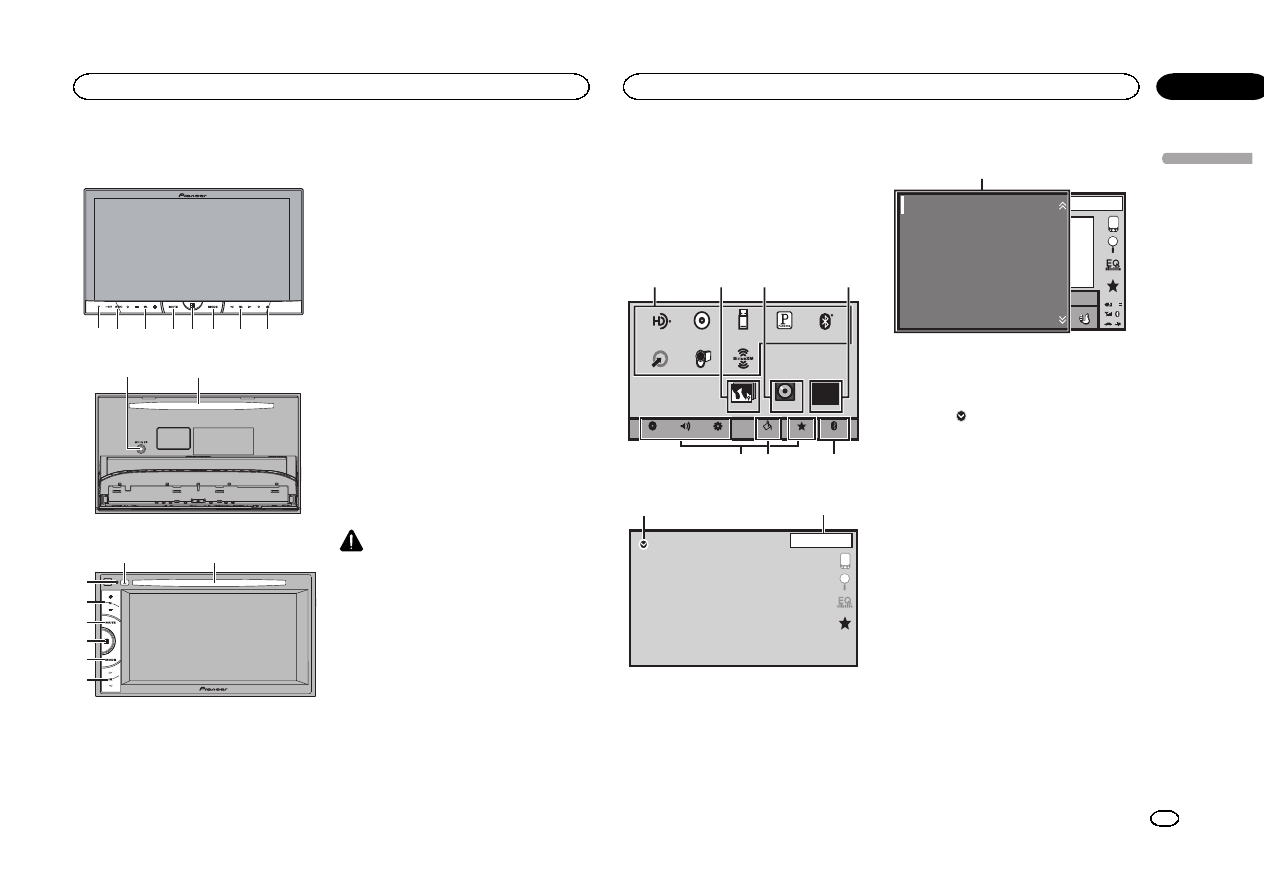
Head unit
AVH-X5500BHS and AVH-X4500BT
1 2 3 5 6 74 8
9 a
AVH-X3500BHS, AVH-X2500BTand AVH-X1500DVD
8a
1
3
4
5
6
7
1RESET
For details refer to Resetting the microproces-
sor on page 44.
2SRC/OFF
3+/–(VOLUME/VOL)
4MUTE
Press to mute. Press again to unmute.
5Home button
Displaying the home display.
The display returns to the Launcher screen
while a 3rd-party application is being used in
Advanced App Mode.
Double-clicking the icon on the Launcher
screen returns the display to the home dis-
play.
6MODE
Turning the information display off.
7c/d(TRK)
8h(eject)
9Auto EQ microphone input jack
Use to connect an auto EQ microphone.
aDisc loading slot
CAUTION
Do not use unauthorized products.
Notes
!When the navigation system is connected,
press MODE to switch to the navigation dis-
play. Press MODE and hold to turn the dis-
play off.
Press MODE again to turn the display on.
!For details on how to operate a navigation
system from this unit, refer to its operation
manual.
!When an iPhone that is running an applica-
tion that supports Advanced App Mode is
connected, press MODE to switch to the ap-
plication display. You can use the application
by touching the display.
!For details on how to connect an iPod or
USB storage device to this unit, refer to
When connecting with optional CD-IU201V
cable on page 48.
Home display
Home display
Digital Radio Disc USB/iPod1 Pandora Bluetooth Audio
AV SiriusXM
RearView
ON
Apps
OFF
AUX
BluetoothFavoriteThemeSystem
Settings
AudioVideo
1324
567
Source off display
OFF
1 JAN
AM
12:12
89
Source on display
JAN
AM
DB
Dolby PLII
12:22
Bluetooth Audio
SiriusXM
USB/iPod
Digital Radio
Pandora
Disc
S.Rtrv
Appr
ppr
App
pp
App
1
1Source icon
Selecting a favorite source.
When the source icon is not displayed, it can
be displayed by pressing the home key or
touching .
2Apps key
Switching to Advanced App Mode.
3Rear view key
Displaying the rear view image.
For details refer to Using the rear view on
page 10.
4Source off key
Turning the source off.
5Bluetooth key
Displaying the Bluetooth connection menu.
6Theme key
Displaying the Theme menu.
7Menu icon
Displaying the menu.
8Source key
Displaying the source menu.
English
What’s what
7
Section
What’s what
En
03
<CRD4703-A/N>7
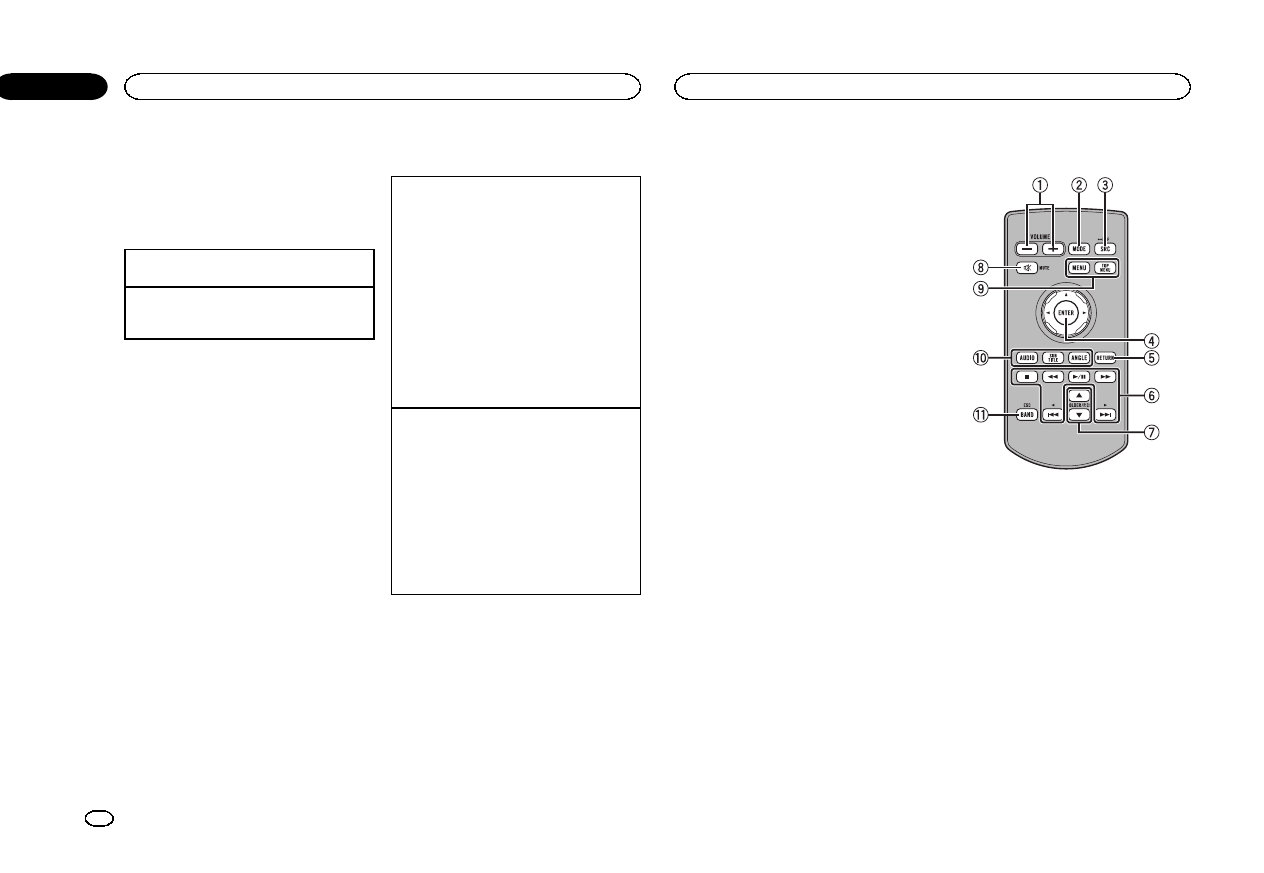
9Clock key
Switching to clock adjustment display.
Turning the source ON/OFF
(Function of AVH-X5500BHS/AVH-X4500BT)
Turning the source on using the buttons
1Press SRC/OFF to turn the source on.
Turning the source off using the buttons
1Press SRC/OFF and hold until the source turns
off.
Selecting a source
Available source modes
!SiriusXM –SiriusXM tuner
(AVH-X5500BHS/AVH-X3500BHS)
!Digital Radio –Digital Radio tuner
(AVH-X5500BHS/AVH-X3500BHS)
!Radio –Radio tuner
(AVH-X4500BT/AVH-X2500BT/AVH-X1500DVD)
!Disc –Built-in DVD and CD player
!USB/iPod –USB/iPod
!Pandora –Pandoraâinternet radio
!Bluetooth Audio –Built-in Bluetooth audio
(AVH-X5500BHS/AVH-X4500BT/AVH-
X3500BHS/AVH-X2500BT)
!AUX –AUX
!AV –AV input
Selecting a source
!Using SRC/OFF
(Function of AVH-X5500BHS/AVH-X4500BT)
1Press SRC/OFF.
!Using the touch panel keys on the home dis-
play
1Touch the source icon and then touch the
desired source name.
!When the source icon is not displayed, it
can be displayed by touching the screen.
!While operating the menu, you cannot se-
lect a source by touching the source icon.
Note
The USB/iPod icon will change as follows:
!USB is displayed when a USB storage device is
connected to USB input.
!iPod is displayed when an iPod is connected to
USB input.
!USB/iPod is displayed when no device is con-
nected.
Adjusting the volume
%Press +/–(VOLUME/VOL) to adjust the
volume.
Remote control
1+/–(VOLUME/VOL)
2MODE
Turning the information display off.
3SRC/OFF
Refer to Source off key on the previous
page.
4Thumb pad
Use to select a menu on the DVD menu.
5RETURN
Press to display the PBC (playback control)
menu during PBC playback.
6f
Press to pause or resume playback.
m
Press to perform fast reverse.
Press to change the fast reverse speed.
What’s what
8
Section
What’s what
En
03
<CRD4703-A/N>8
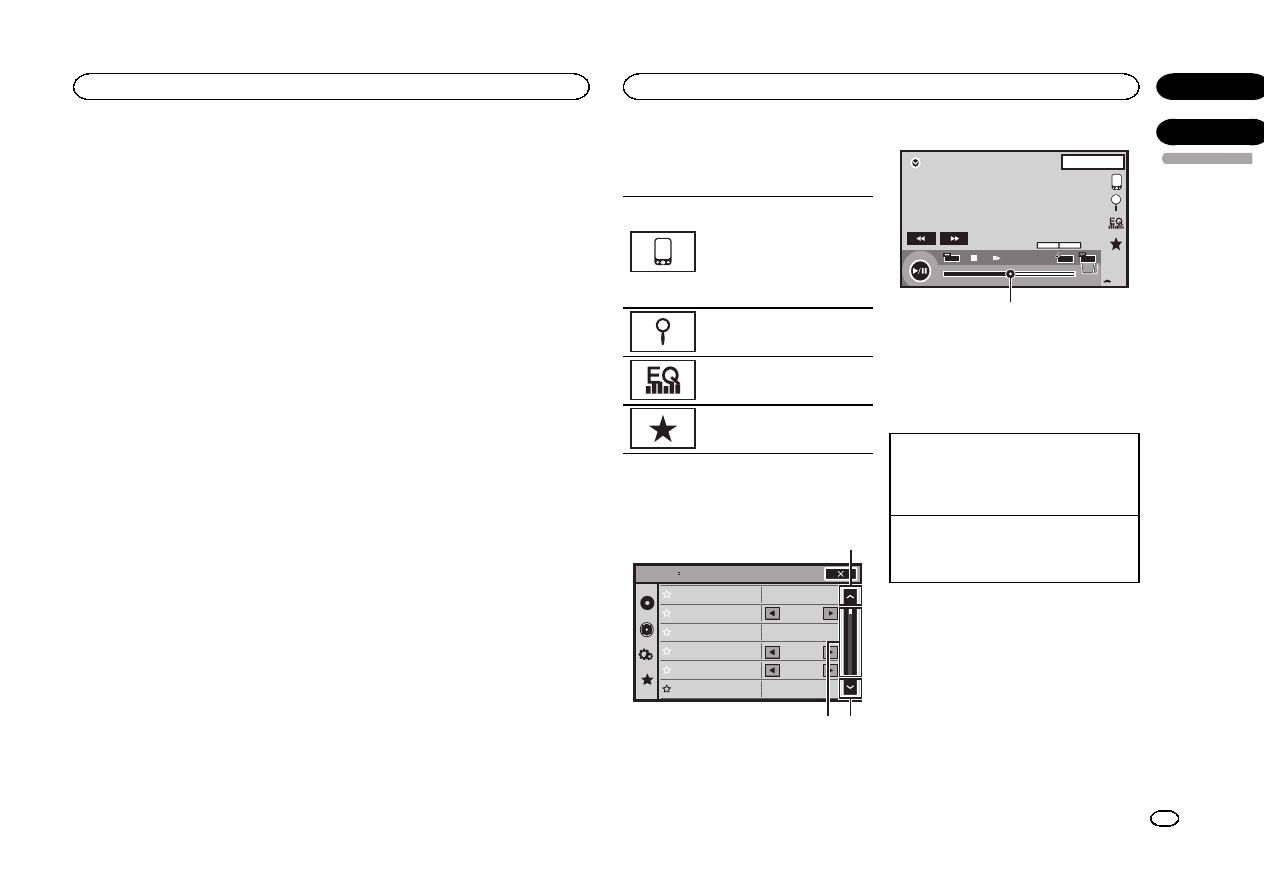
n
Press to perform fast forward.
Press to change the fast forward speed.
o
Press to return to the previous track (chap-
ter).
p
Press to go to the next track (chapter).
g
Press to stop playback.
If you resume playback, playback will start
from the point where you stopped. Touch the
key again to stop playback completely.
7FOLDER/P.CH
Press to select the next or previous disc or
folder.
Press to recall radio station frequencies as-
signed to preset tuning keys.
8MUTE
Press to mute. Press again to unmute.
9MENU
Press to display the DVD menu during DVD
playback.
TOP MENU
Press to return to the top menu during DVD
playback.
aAUDIO
Press to change the audio language during
DVD playback.
Press to switch audio output for DivX/
MPEG-4.
SUBTITLE
Press to change the subtitle language during
DVD/DivX/MPEG-4 playback.
ANGLE
Press to change the viewing angle during
DVD playback.
bBAND/ESC
Press to select the tuner band when tuner is
selected as a source. Also used to cancel the
control mode of functions.
Press to switch between modes when play-
ing the following types of data:
!Disc
Compressed audio and audio data (CD-
DA) such as with CD-EXTRA and MIXED-
MODE CDs
!USB storage device
Audio data, video data, and photo data
Common operations for
menu settings/lists
(Function of AVH-X5500BHS/
AVH-X4500BT/AVH-X3500BHS/
AVH-X2500BT)
Starting the Bluetooth telephone
menu.
For details refer to Bluetooth tele-
phone on page 29.
Displaying the list menu.
Starting the search function.
Displaying the EQ (Audio func-
tion menu).
Displaying the Favorite menu.
Operating the scroll icon
and the scrubber bar
Sonic Center Control
Loudness
Subwoofer
Bass Booster
High Pass Filter
Source Level Adjuster
L/R 0
Low
0
125Hz
0
On
Audio
1
12
DVD-V
00'20'' -119'51''
48kHz 16bit
Dolby D
MENU MENU
TOP
1/2
Dolby DMulti ch
FULL
11
1JAN
PM
12:43
01 01
2
1Scroll icon
Appears when selectable items are hidden.
2Scrubber bar
Appears when items cannot be displayed on
a single page only.
Viewing the hidden items
1Touch the scroll icon or drag the scrubber bar
to view any hidden items.
!Also, you can drag the list to view any hidden
items.
Specifying the playback point
1Drag the scrubber bar on the screen.
(Not available when the scrubber bar is grayed
out.)
English
What’s what
9
Section
Common operations
En
03
04
<CRD4703-A/N>9
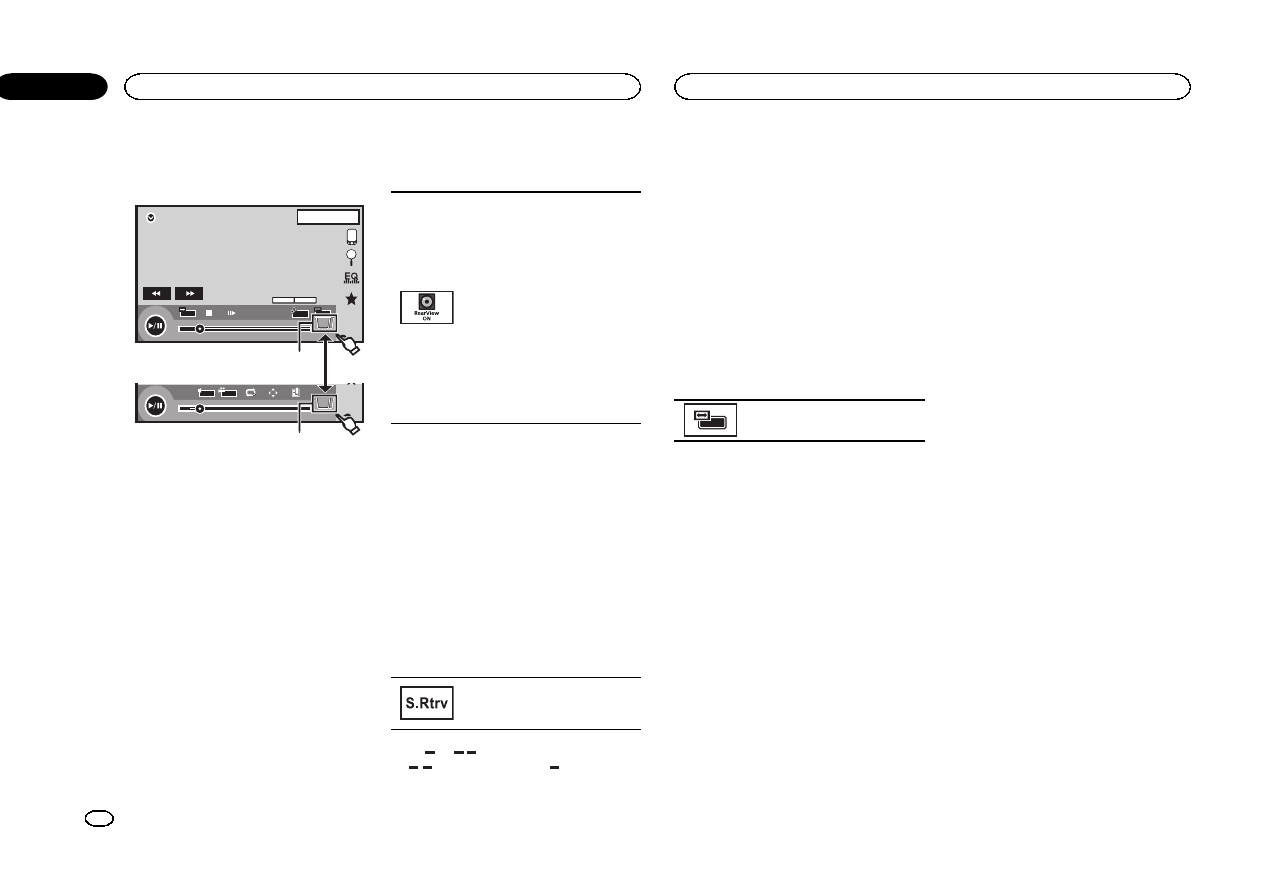
Activating the touch panel keys
Touch panel keys
DVD-V
00'20'' -119'51''
48kHz 16bit
Dolby D
MENU MENU
TOP
1/2
Dolby DMulti ch
FULL
11
1JAN
PM
12:43
01 01
07'24'' -112'47''
2/2
L+R
Return
1
1
1
1Tab key
Switching the touch keys on the display.
Using the rear view
The below functions are available. Use of the
rear view camera feature requires a rear view
camera sold separately.
!Rear view camera
This unit can be setup to display the rear
view image automatically when you move
the shift lever to the REVERSE (R) position.
!Camera for rear view mode
The rear view can be turned on to display at
all times.
The rear view camera needs to be set to a set-
ting other than Off to turn on rear view
mode.
For details about the settings, refer to Setting the
rear view camera (back up camera) on page 39.
Using the rear view key to
display the rear view
Displaying the rear view image by
turning the rear view image on.
When the rear view image is dis-
played, you can switch to the
source display by touching the dis-
play. You can operate from the
source display temporarily at this
time. If you do not perform any op-
erations within a few seconds, the
display will return to the rear view
image.
To turn off the rear view image,
press the home button to return to
the home display and then press
this key again.
Using the rear monitor
Connecting a rear monitor, sold separately, to
this unit allows images and videos to be viewed
from the rear seats.
Notes
!Touch keys and operation screens do not dis-
play on the rear monitor.
!Images and video will continue to be dis-
played whether the vehicle is in motion or
stopped.
Using sound retriever
Automatically enhances com-
pressed audio and restores rich
sound.
Off — —
!is more effective than .
Notes
!This function is enabled for playback on the
sources listed below.
—CD-DA
—MP3/WMA/AAC/WAV files on USB storage
devices
—MP3/WMA/AAC files on CD media
—iPod
—Pandora
!The sound retriever setting is turned Off
when the MIXTRAX function is used in USB
source mode.
Changing the wide-screen
mode
Selecting the appropriate screen
ratio for the playback video.
1 Display the screen mode.
2 Touch the desired wide mode setting.
FULL (full screen)
The 4:3 picture is enlarged in the horizontal di-
rection only, granting viewers a 4:3 TV picture
(normal picture) without any omissions.
ZOOM (zoom)
The 4:3 picture is enlarged in the same propor-
tion both vertically and horizontally; ideal for a
cinema sized picture (wide screen picture).
NORMAL (normal)
The 4:3 picture is displayed as is, granting view-
ers no sense of disparity as the proportions are
the same as that of the normal picture.
Notes
!You cannot operate this function while driv-
ing.
!Different settings can be stored for each
video source.
!When a video is viewed in a wide screen
mode that does not match its original aspect
ratio, it may appear different.
!Remember that using the wide mode feature
of this system for commercial or public view-
ing purposes may constitute an infringement
on the author’s rights protected by the Copy-
right Law.
!The video image will appear coarser when
viewed in ZOOM mode.
!This function is enabled for playback on the
sources listed below.
—Disc: DVD-V, Video-CD, DivX, MPEG-1,
MPEG-2, MPEG-4, JPEG
—USB: DivX, MPEG-1, MPEG-2, MPEG-4, JPEG
—iPod: Video
—AV Input: A/V data
—AUX: A/V data
Common operations
10
Section
Common operations
En
04
<CRD4703-A/N>10
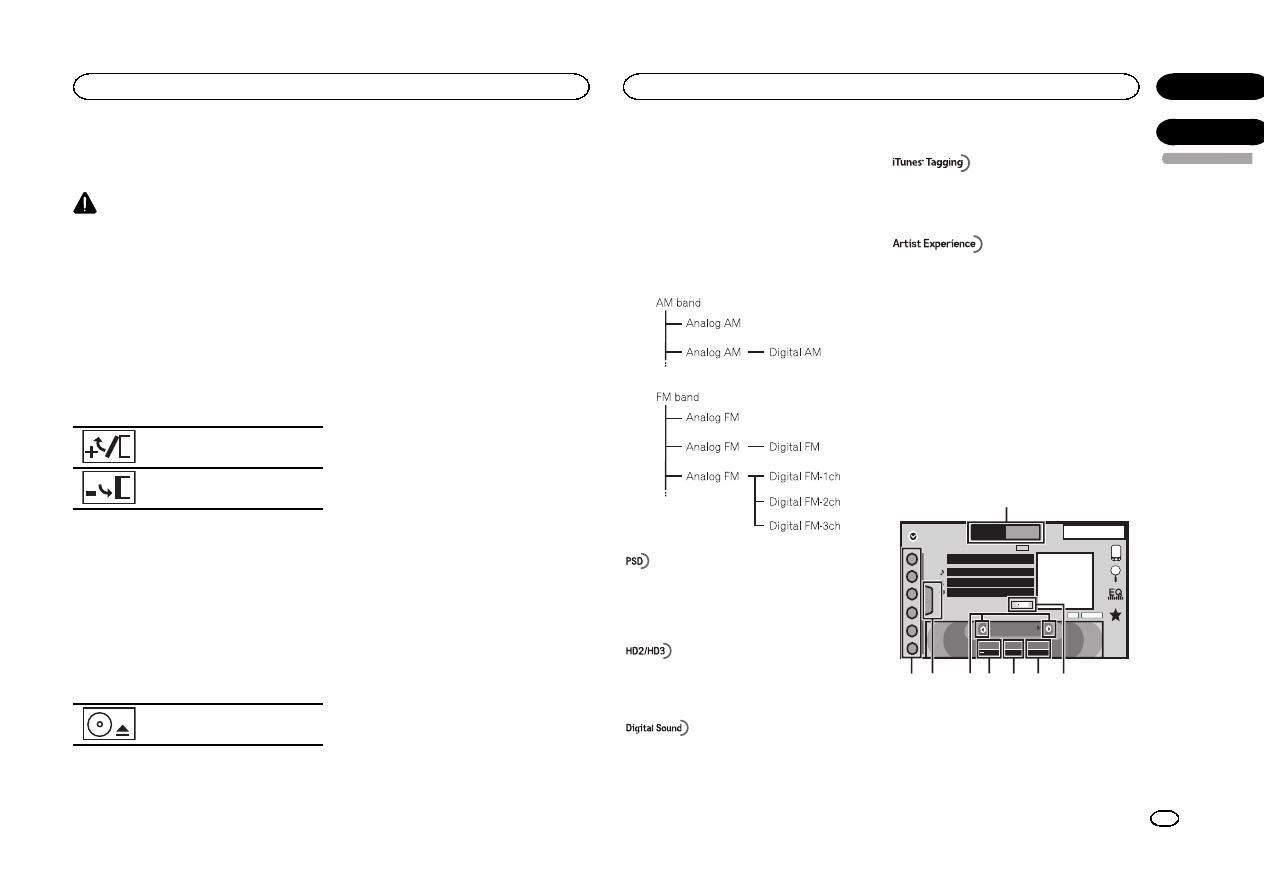
Adjusting the angle of the
LCD panel and ejecting media
CAUTION
Keep hands and fingers clear of the unit when
opening, closing, or adjusting the LCD panel. Be
especially cautious of children’s hands and fin-
gers.
Adjusting the LCD panel angle
(Function of AVH-X5500BHS/AVH-X4500BT)
1 Press h(eject) to display the ejecting
menu.
2 Adjust the LCD panel to an easily view-
able angle.
Laying the panel down.
Returning the panel to the upright
position.
#As the set angle is saved, the LCD panel will au-
tomatically be adjusted to the same position the next
time the LCD panel is opened.
Ejecting a disc
(Function of AVH-X5500BHS/AVH-X4500BT)
1 Press h(eject) to display the ejecting
menu.
2 Eject a disc.
Ejecting a disc.
Ejecting a disc
(Function of AVH-X3500BHS/AVH-X2500BT/AVH-
X1500DVD)
%Press hto eject a disc.
Setting the clock
1 Touch the Clock key.
The Clock Adjustment screen appears.
For details refer to Home display on page 7.
2 Select the item to set.
3 Touch aor bto set the correct date and
time.
About HD Radioästations
(Function of AVH-X5500BHS/AVH-X3500BHS)
HD Radioästations offer high-quality audio and
data services. HD Radio stations are brought to
you by local FM/AM stations.
HD Radio stations feature the following:
!High quality audio
!FM multicasting
!Data services
Program Service Data: Contributes to the superior user
experience of HD Radio Technology. Presents song name,
artist, station IDs, HD2/HD3 Channel Guide, and other rel-
evant data streams.
Adjacent to traditional main stations are extra local FM
channels. These HD2/HD3 Channels provide new, original
music as well as deep cuts into traditional genre.
Digital, CD-quality sound. HD Radio Technology enables
local radio stations to broadcast a clean digital signal.
AM sounds like today’s FM and FM sounds like a CD.
iTunesâTagging provides you the opportunity to discover
a wide range of content and the means to “tag”that con-
tent for later review and purchase from the iTunesâStore.
Visual information related to content being played on
your HD Radio receiver, such as Album Art, historical pho-
tographs, still art from live broadcasts, among other re-
lated content.
HD RadioäTechnology
!HD Radio Technology manufactured under li-
cense from iBiquity Digital Corporation. U.S.
and Foreign Patents. HD Radioäand the
HD, HD Radio, and “Arc”logos are propriet-
ary trademarks of iBiquity Digital Corp.
HD Radio tuner operations
Touch panel keys
Radio
8 AUG
PM
12:05
1
2
3
4
5
6
FM AM1
HD
Local Seek
ALL
Blending
D/A Auto
87.5MHz
DIGITAL
PS Data
Song Data
Artist Data
Album Data
Tag
HD8
1
2345678
1Band key
Selecting a band (FM or AM) by touching the
band key.
The touch panel key for the selected band is
highlighted.
English
Basic operations
11
Section
HD Radioätuner
En
05
06
<CRD4703-A/N>11
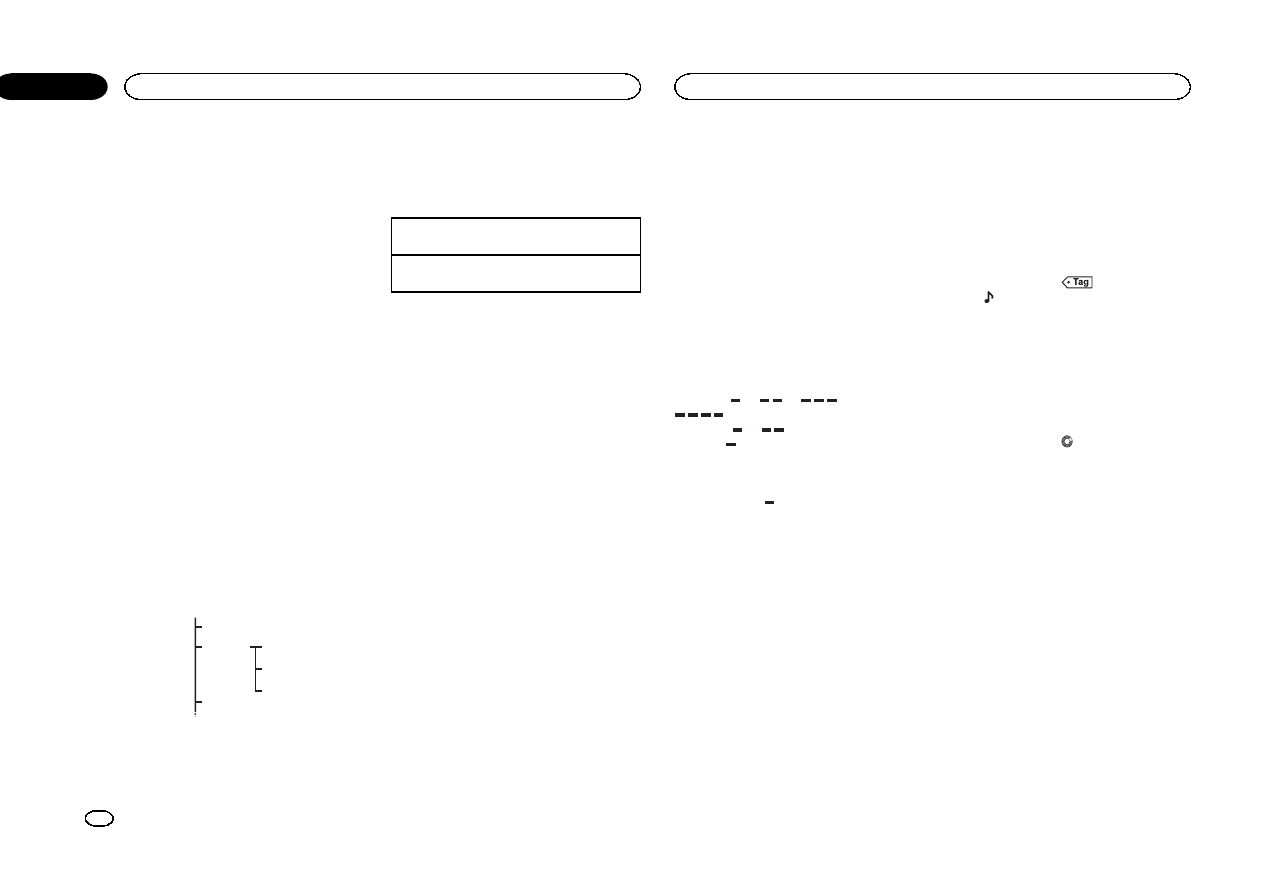
Switching between FM1,FM2, and FM3 by
touching the band key.
When AM is selected, you cannot switch to
another AM band by touching the band key.
2Tag key
Saving song information (tag) from the
broadcasting station to your iPod.
3Reception mode key
Switching to the analog broadcast of the
same frequency.
4Seek mode key
Switching between Digital broadcasting sta-
tion seek and normal seek.
5Local key
Setting the local seek level.
6Tuning key
Tuning up or down manually.
Touch and hold down for more than two sec-
onds to skip stations. Seek tuning starts as
soon as you release. Touch again to cancel
seek tuning.
When an analog station is received, tuning
down operation is conducted within the ana-
log broadcasting. (6d2)
If a digital broadcast is not yet received, tun-
ing-up operation tunes in the next analog sta-
tion. (2d6)
Analog FM 1
Digital FM-1ch
3
Digital FM-2ch
4
Digital FM-3ch
5
Analog FM 2
Analog FM 6
7List key
Displaying the preset channel list.
8Preset channel key
Select a preset channel.
Basic operations
Switching preset channels using the buttons
1Press cor d(TRK).
Seek tuning using the buttons
1Press and hold cor d(TRK).
Note
Touch panel keys not listed under HD Radio
tuner operations may appear on the display.
Refer to Indicator list on page 57.
Storing and recalling stations
You can easily store up to six stations for each
band as presets.
!Six stations for each band can be stored in
memory.
1 Display the preset channel list screen.
Refer to HD Radio tuner operations on the pre-
vious page.
The preset channel list appears in the display.
2 Touch and hold down one of the preset
tuning keys to store the selected frequency
to the memory.
The selected radio station frequency has been
stored in the memory.
3 Touch the appropriate preset tuning key
to select the desired station.
Storing the strongest stations
BSM (best stations memory) automatically
stores the six strongest stations in the order of
their signal strength.
Storing broadcast frequencies with BSM may re-
place broadcast frequencies you have saved
using the preset tuning keys.
1 Display the preset channel list screen.
Refer to HD Radio tuner operations on the pre-
vious page.
The preset channel list appears in the display.
2 Touch BSM to turn BSM on.
The six strongest broadcast frequencies will be
stored under preset tuning keys in order of their
signal strength.
#To cancel the storage process, touch Cancel.
Tuning in to strong signals
Local seek tuning allows you to tune in to only
those radio stations with sufficiently strong sig-
nals for good reception.
FM: Off —— — —
AM: Off — —
The more there are on the screen, the fewer
the stations that can be selected. Only stations
with the strongest signals in your local area can
be selected.
If there are fewer , this unit will be able to re-
ceive broadcasts from weaker stations.
Using iTunes tagging
Note
For more details about iTunes tagging, refer to
About iTunes tagging on page 60.
Storing the tag information to
this unit
1 Tune in to the broadcast station.
2 Store the tag information to this unit.
Refer to HD Radio tuner operations on the pre-
vious page.
You can store the information if the Tag indica-
tor is displayed while the desired song is being
broadcast.
#While storing the tag data on this unit, Tag
flashes.
#The tag information for up to 50 songs can be
stored on this unit.
#Depending on the timing of when the tag infor-
mation is stored, the tag information for the song
played before or after the currently playing song may
also be stored.
3 When completed, indicator turns
off and indicator is displayed.
Storing the tagged information
to your iPod
1 Connect your iPod.
When your iPod is connected to this unit, your
iPod starts storing the tagged information auto-
matically.
2 When completed, indicator turns off
and the tagged information is stored on
your iPod.
Switching the seek mode
There are two seek tuning settings, one is HD
(Digital broadcasting stations seek) and the
other is ALL (normal seek).
ALL—HD
Switching the reception mode
If the reception for a digital broadcast becomes
poor, this unit automatically switches to the ana-
log broadcast of the same frequency. If this
function is set to D/A AUTO, the tuner switches
between digital broadcast and analog broadcast
automatically. If this function is set to ANALOG,
the tuner will only receive analog broadcasts.
D/A AUTO—ANALOG
HD Radioätuner
12
Section
HD Radioätuner
En
06
<CRD4703-A/N>12
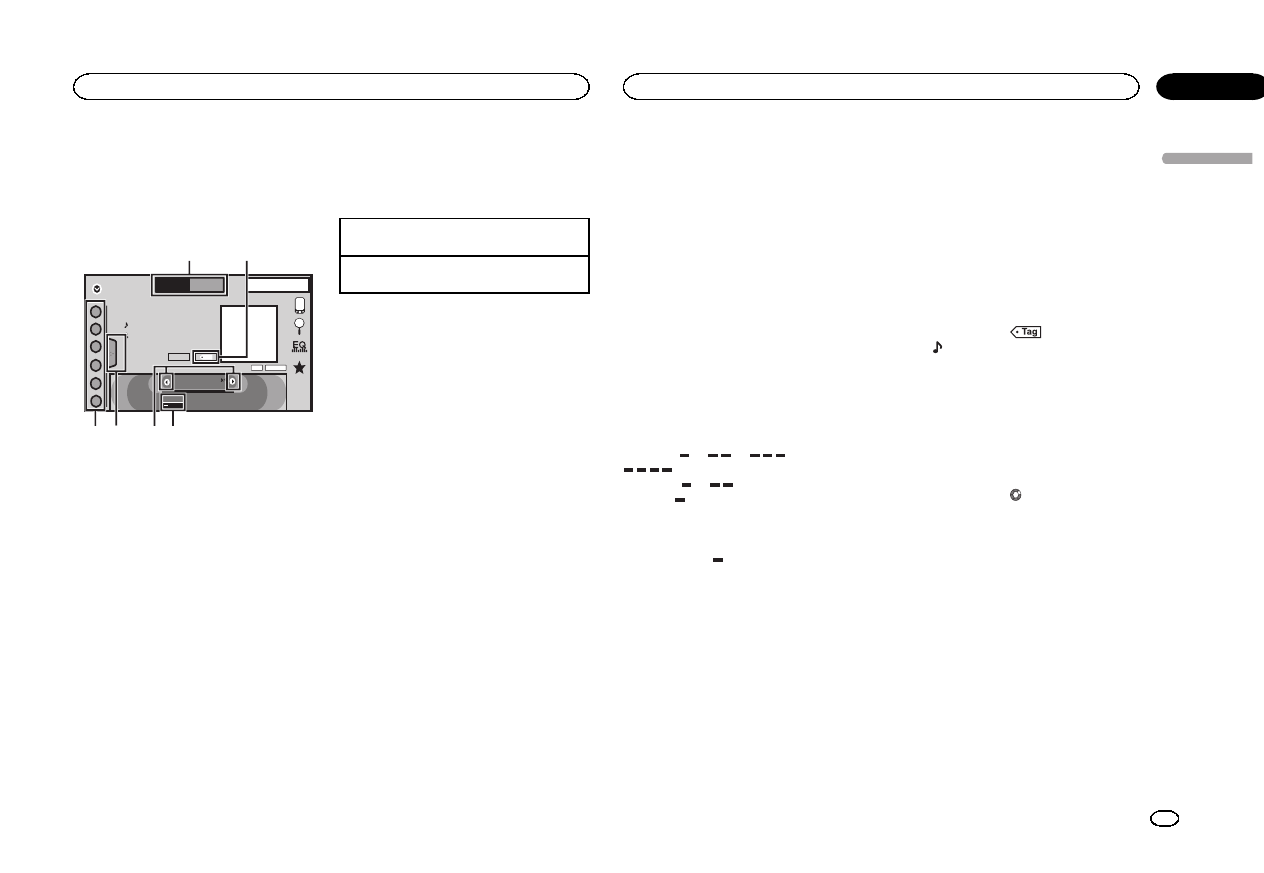
Tuner operations
(Function of AVH-X4500BT/AVH-X2500BT/AVH-
X1500DVD)
Touch panel keys
Radio
8 AUG
PM
12:05
1
2
3
4
5
6
FM AM1
HD
Local
87.5MHz
DIGITAL
Tex t
Tag
1
3456
2
WWWWWWWW
WWWWWWWW
WWWWWWWW
1Band key
Selecting a band (FM1,FM2 or FM3)by
touching the left icon. Switching to the AM
band by touching the right icon.
The icon for the selected band is highlighted.
2Tag key
Saving song information (tag) from the
broadcasting station to your iPod.
3Local key
Setting the local seek level.
4Tuning key
Tuning up or down manually.
Touch and hold down for more than two sec-
onds to skip stations. Seek tuning starts as
soon as you release. Touch again to cancel
seek tuning.
5List key
Displaying the preset channel list.
6Preset channel key
Selecting a preset channel.
Basic operations
Switching preset channels using the buttons
1Press cor d(TRK).
Seek tuning using the buttons
1Press and hold cor d(TRK).
Notes
!Listening AM radio while an iPod is charged
from this unit may generate noise. In this
case, disconnect the iPod from this unit.
!Touch panel keys not listed under Tuner oper-
ations may appear on the display.
Refer to Indicator list on page 57.
Storing and recalling stations
You can easily store up to six stations for each
band as presets.
1 Display the preset screen.
Refer to Tuner operations on this page.
The preset screen appears in the display.
2 Touch and hold down one of the preset
tuning keys to store the selected frequency
to the memory.
The selected radio station frequency has been
stored in the memory.
3 Touch the appropriate preset tuning key
to select the desired station.
Storing the strongest stations
BSM (best stations memory) automatically
stores the six strongest stations in the order of
their signal strength.
Storing broadcast frequencies with BSM may re-
place broadcast frequencies you have saved
using the preset tuning keys.
1 Display the preset screen.
Refer to Tuner operations on this page.
The preset screen appears in the display.
2 Touch BSM to turn BSM on.
The six strongest broadcast frequencies will be
stored under preset tuning keys in order of their
signal strength.
#To cancel the storage process, touch Cancel.
Tuning in to strong signals
Local seek tuning allows you to tune in to only
those radio stations with sufficiently strong sig-
nals for good reception.
FM: Off —— — —
AM: Off — —
The more there are on the screen, the fewer
the stations that can be selected. Only stations
with the strongest signals in your local area can
be selected.
If there are fewer , this unit will be able to re-
ceive broadcasts from weaker stations.
Using iTunes tagging
Note
For more details about iTunes tagging, refer to
About iTunes tagging on page 60.
Storing the tag information to
this unit
1 Tune in to the broadcast station.
2 Store the tag information to this unit.
Refer to Tuner operations on this page.
You can store the information if the Tag indica-
tor is displayed while the desired song is being
broadcast.
#While storing the tag data on this unit, Tag
flashes.
#The tag information for up to 50 songs can be
stored on this unit.
#Depending on the timing of when the tag infor-
mation is stored, the tag information for the song
played before or after the currently playing song may
also be stored.
3 When completed, indicator turns
off and indicator is displayed.
Storing the tagged information
to your iPod
1 Connect your iPod.
When your iPod is connected to this unit, your
iPod starts storing the tagged information auto-
matically.
2 When completed, indicator turns off
and the tagged information is stored on
your iPod.
English
Tuner
13
Section
Tuner
En
07
<CRD4703-A/N>13
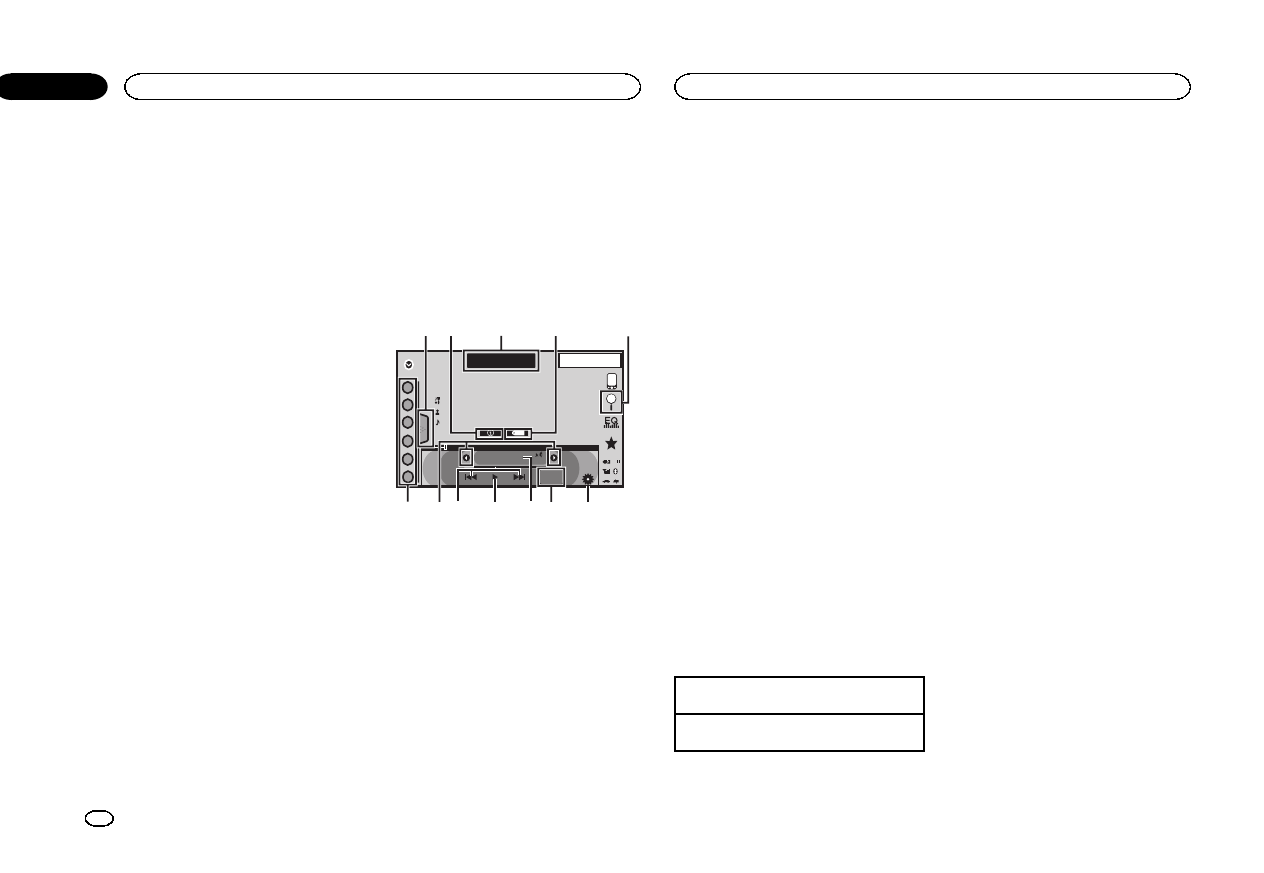
Introducing SiriusXM tuner
operations
(Function of AVH-X5500BHS/AVH-X3500BHS)
You can use this unit to control SiriusXM Con-
nect Vehicle Tuner, which is sold separately.
For more information on how to install SiriusXM
Connect Vehicle Tuner, consult the installation
guide included with the tuner.
Everything worth listening to is on SiriusXM, get-
ting over 130 channels, including the most com-
mercial‐free music, plus the best sports, news,
talk and entertainment. A SiriusXM Vehicle
Tuner and Subscription are required. For more
information, visit www.siriusxm.com.
To subscribe to the SiriusXM
Satellite Radio service
1 Select SiriusXM as a source.
You should be able to tune in to Channel 1. If
you cannot get Channel 1, make sure that your
SiriusXM Connect Vehicle Tuner is installed cor-
rectly as described in the tuner installation
guide.
2 Switch to Channel 0 and check the Radio
ID.
The SiriusXM Radio ID can be found by tuning
to Channel 0. In addition, the Radio ID is located
on the bottom of the SiriusXM Connect Vehicle
Tuner.
Please note that the SiriusXM Radio ID does not
include the letters I, O, S or F.
You will need this number to activate your sub-
scription.
3 Activate the service either online or by
phone.
!Visit the website, www.siriusxm.com/activate-
now
!Call SiriusXM Listener Care at 1-800-XM-
RADIO (1-866-635-2349) to activate.
#The SiriusXM satellites will send an activation
message to your tuner. When the tuner has received
the message, “Subscription Updated”is displayed.
Once you have subscribed, SiriusXM will send an ac-
tivation message to your tuner.
The activation process usually takes 10 to 15 minutes
but may take up to an hour in some cases. Do not
turn off the unit while the activation message is dis-
played.
Touch panel keys
SiriusXM
22 JAN
AM
12:22
1
2
3
4
5
6
888
Tag
WWWWWWWWWWWWW
WWWWWWWWWWWWWWWW
WWWWWWWWWWWWWWWW
WWWWWWWWWWWWWWWW
CH
CH
Live
-01’ 00”
DB
Dolby PLII
SXM 1
934215
6798bac
1List key
Displaying the preset channel list.
2Information key
Switching the SiriusXM information.
Category name—Content information
Touch and hold for more than two seconds to
scroll the text.
3Band key
Selecting a band from SXM1,SXM2 or
SXM3.
4iTunesâsong tagging key
Saving iTunesâsong tagging from the broad-
casting station to your iPod.
5Search key
Selecting a channel directly.
Selecting a channel from the SiriusXM chan-
nel list.
6Parental control key
The Parental Control screen appears.
7Live key
Returning to the current live broadcast
8Direct key
A numeric keypad appears, allowing you to
enter SiriusXM channel numbers directly.
9Pause and play key
aTrack select key
Touch to select a track.
Touch and hold for more than two seconds to
fast forward or reverse.
bTuning key
Tuning up or down manually.
Touch and hold down for more than two sec-
onds to skip stations. Seek tuning starts as
soon as you release. Touch again to cancel
seek tuning.
cPreset channel key
Recalling the preset channels by touching
the key.
Storing the current station in the preset
channel list by touching and holding the key.
Basic operations
Manual tuning (step by step) using the buttons
1Press cor d(TRK).
Seek tuning using the buttons
1Press and hold cor d(TRK).
Note
Touch panel keys not listed under Introducing
SiriusXM tuner operations may appear on the dis-
play.
Refer to Indicator list on page 57.
Storing and recalling stations
You can easily store up to six stations for each
band as presets.
!Six stations for each band can be stored in
memory.
!Channels are stored and recalled on a broad-
cast station basis. This means that even if
SiriusXM assigns a broadcast station that
you stored to a different channel, you will still
be able to recall that broadcast channel
(although the displayed channel number
may differ from the original).
1 Display the preset channel list screen.
Refer to Introducing SiriusXM tuner operations on
this page.
The preset channel list appears in the display.
2 Touch and hold down one of the preset
tuning keys to store the selected frequency
to the memory.
The selected radio station frequency has been
stored in the memory.
3 Touch the appropriate preset tuning key
to select the desired station.
Selecting a channel from the
SiriusXM channel list display
Selecting a channel from the all
channel list
You can select a channel from any of the avail-
able channels.
HSiriusXM tuner
14
Section
HSiriusXM tuner
En
08
<CRD4703-A/N>14
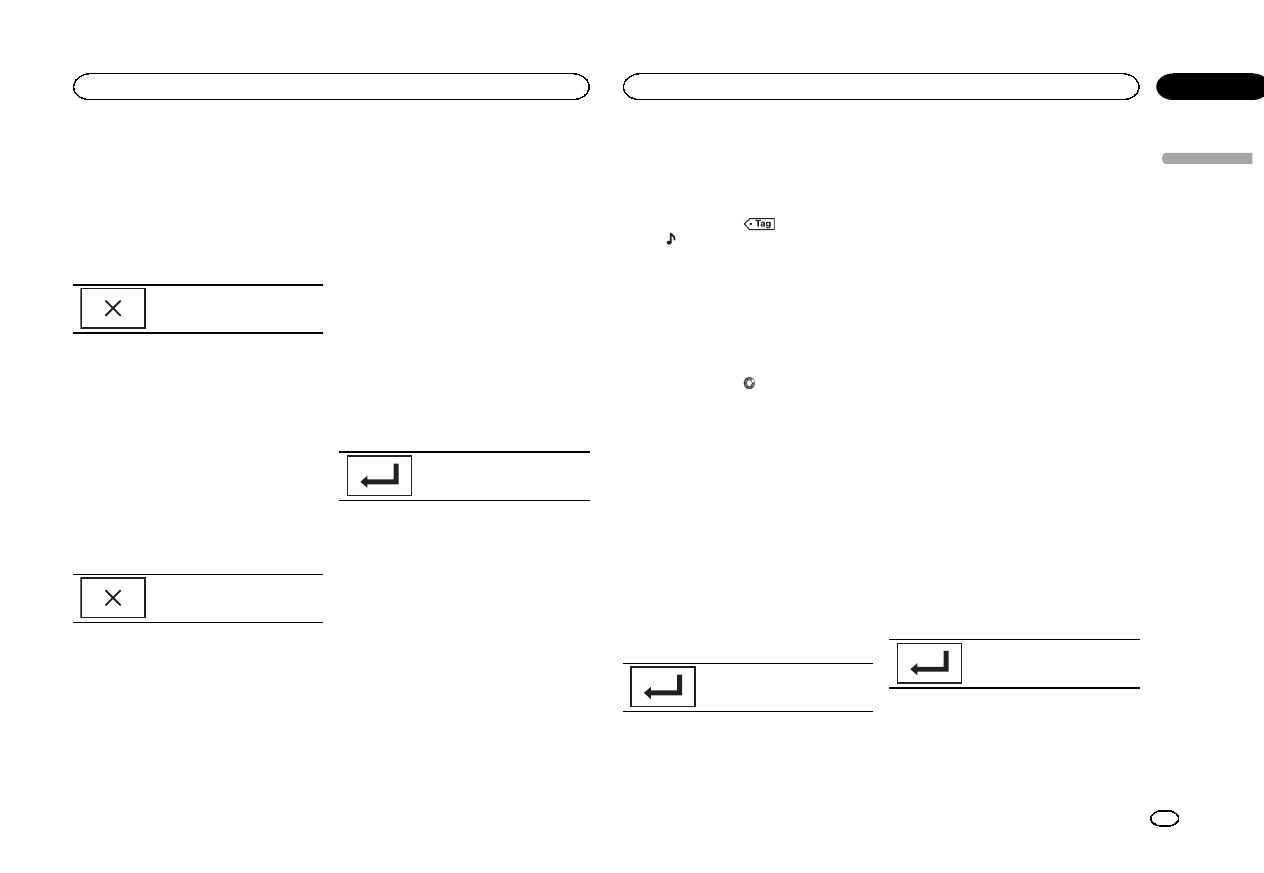
1 Touch the search key to open the list
screen.
2 Select the all setting.
3 Select the desired channel.
4 Touch the close key to close the list
screen.
Display is closed.
Selecting a channel from the
category list
You can select a channel from any of the avail-
able SiriusXM channels.
1 Touch the search key to open the list
screen.
2 Select a category from the list.
3 Select the desired channel.
4 Touch the close key to close the list
screen.
Display is closed.
Switching the list display
You can switch between list types while a list is
showing.
%Touch the list key while a list is showing
to switch between list types.
The list displayed will switch between the below
types in the order given.
Channel Name—Artist Name—Song Title—Con-
tent Info
Selecting a SiriusXM
channel directly
You can select a SiriusXM channel directly by
entering the desired channel number.
1 Touch the direct key to switch to direct
input display.
2 Touch 0 to 9 to input the desired channel
number.
#To cancel the input numbers, touch C.
3 Select the SiriusXM channel of the en-
tered number.
The SiriusXM channel of the entered number is
selected.
Selecting the SiriusXM channel
of the entered number.
Using iTunes tagging
Note
For more details about iTunes tagging, refer to
About iTunes tagging on page 60.
iTunes tagging of SiriusXM songs
1 Tune in to the broadcast station.
2 Store the tag information to this unit.
Refer to HD Radio tuner operations on page 11.
You can store the information if the Ta g indica-
tor is displayed while the desired song is being
broadcast.
#While storing the tag data on this unit, Tag
flashes.
#The tag information for up to 50 songs can be
stored on this unit.
#Depending on the timing of when the tag infor-
mation is stored, the tag information for the song
played before or after the currently playing song may
also be stored.
3 When completed, indicator turns
off and indicator is displayed.
Storing the tagged information
to your iPod
1 Connect your iPod.
When your iPod is connected to this unit, your
iPod starts storing the tagged information auto-
matically.
2 When completed, indicator turns off
and the tagged information is stored on
your iPod.
Setting Parental Control
The SiriusXM Parental Control feature allows
you to control access to channels that you con-
sider inappropriate for younger listener.
When enabled, the Parental Control feature re-
quires you to enter a passcode to tune to the
locked channels.
1 Touch the parental control key to open
the passcode confirmation screen.
2 Use the numeric keypad to enter the
four-digit passcode and then touch the Enter
key.
Touch to confirm the passcode.
The default passcode is 0000.
If a valid passcode is entered, the channel list
appears on the Parental Control screen together
with a lock or unlock icon.
3 The below operations can be completed
from the Parental Control screen.
Locking channels
Access to the current broadcast channel can be
locked. You will need to input your passcode
later on to listen to a locked channel.
%To lock a specific channel, touch the
name of the desired channel on the list.
A locked lock icon will appear next to the name
of a locked channel.
Touch the name of a locked channel a second
time to unlock the channel.
Clear All (clearing the locks from
all channels)
You can clear the locks from all locked channels
at the same time.
%Touch Clear All to unlock all locked chan-
nels at the same time.
Edit Code (changing the passcode)
You can change your passcode.
1 Touch Edit Code to switch to the pass-
code edit screen.
2 Use the numeric keypad to enter a new
four-digit passcode and then touch the Enter
key.
Touch to confirm the passcode.
Once the new passcode is set, the Parental Con-
trol screen will open.
Note
If Check Tuner displays instead, refer to
SiriusXM Satellite Radio on page 53.
English
HSiriusXM tuner
15
Section
HSiriusXM tuner
En
08
<CRD4703-A/N>15
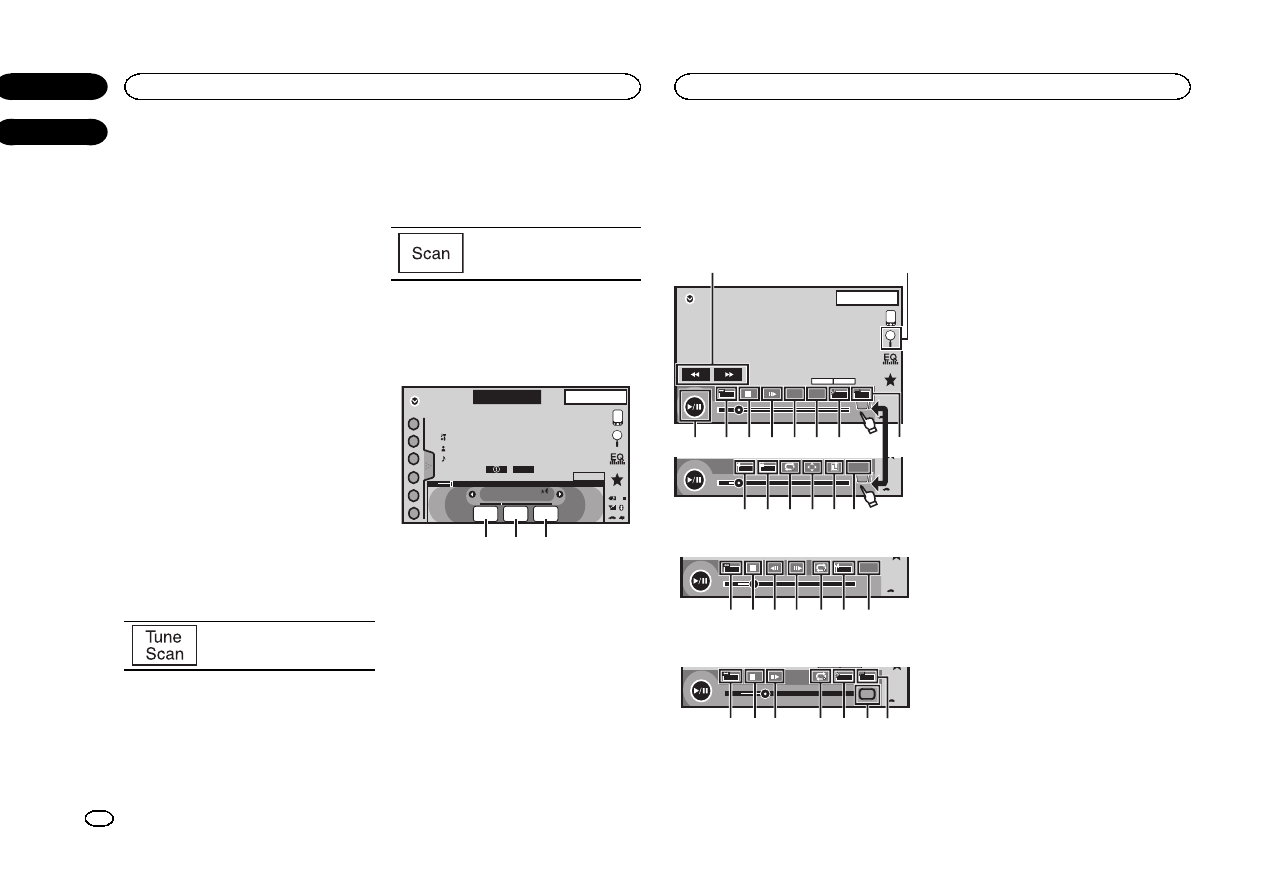
Setting SiriusXM Tune Startä
SiriusXM Tune Start can be used to set the start
position for playback of the audio track being
broadcast when the channel is changed.
1 Press the home button to switch to the
home display.
2 Touch the system key to open the system
menu.
3 Touch SiriusXM Tune Start on the system
menu to turn SiriusXM Tune Start on or off.
On: The current broadcast audio track is played
back from the start of the track.
Off: The live broadcast is played for the current
audio channel.
Scan play
Channels and tracks can be played back on this
unit by scan play.
Tune Scanä
Scan through short previews of songs you may
have missed on your preset music channels.
1 Touch the list key to display the preset
channel list.
2 Touch Tune Scan.
Each track in the current channel
plays for eight seconds at a time.
Refer to Scan play operations on this page for a
list of functions that can be used during scan
play.
Category scan
Scan through each channel in a category.
1 Touch the search key.
2 Touch the desired category.
3 Touch Scan.
The live broadcast for each chan-
nel in the current category plays
for five seconds at a time.
Refer to Scan play operations on this page for a
list of functions that can be used during scan
play.
Scan play operations
SiriusXM
22 JAN
AM
12:22
1
2
3
4
5
6
888
WWWWWWWWWWWWW
WWWWWWWWWWWWWWWW
WWWWWWWWWWWWWWWW
WWWWWWWWWWWWWWWW
CH
CH
Scan
Play
DB
Dolby PLII
Scan
Next
Scan
Esc
Scanning
SXM 1
1 2 3
1Scan play key
Switching to the channel currently playing in
scan play
2Scan next key
Switching to the next track during the tune
scan
Switching to the next channel during the cat-
egory scan
3Scan escape key
Quitting scan play
Introducing movie operations
You can use this unit to view DVD/DVD-R/DVD-
RW/CD/CD-R/CD-RW movie files.
Touch panel keys
DVD video
DVD-V
00'20'' -119'51''
48kHz 16bit
Dolby D
MENU MENU
TOP
1/2
Dolby DMulti ch
FULL
11
1JAN
PM
12:43
01 01
07'24'' -112'47''
2/2
L+R
Return
1
a 987654
21
fedcgb
3
Video CD
00'20'' -119'51''
L+R
FULL
Return
98h7 eg b
When playing a disc containing a mixture of vari-
ous media file types
00'15'' -00'59''
yy
FULL
1
OFF
Media
987 i3e4
1Fast forward key/Reverse key
Fast forwarding or reversing
Touch to change the fast forward and reverse
speed.
2Search key
Starting the search function.
3Switch subtitle language key
With DVDs/DivX files featuring multi-subtitle
recordings, you can switch between subtitle
languages during playback.
4Switch audio language key
With DVDs/DivX files that provides audio
playback in different languages and different
audio systems (Dolby Digital, DTS, etc.), you
can switch between languages/audio sys-
tems during playback.
Depending on the setting, the video may not
be played back with the audio system used
to record the DVD.
5TOP MENU key
Returning to the top menu during DVD play-
back.
6MENU key
Displaying the DVD menu during DVD play-
back.
7Slow-motion playback key
Moving the selection ahead one frame at a
time during playback.
Touch and hold down the key for more than
two seconds to slow down playback speed.
Touching the key increases the playback
speed over four incremental settings during
slow motion playback from DVD video/Video
CD.
8Stop key
Stopping playback.
If you resume playback, playback will start
from the point where you stopped. Touch the
key again to stop playback completely.
HSiriusXM tuner
16
Section
Disc (CD/DVD)
En
08
09
<CRD4703-A/N>16
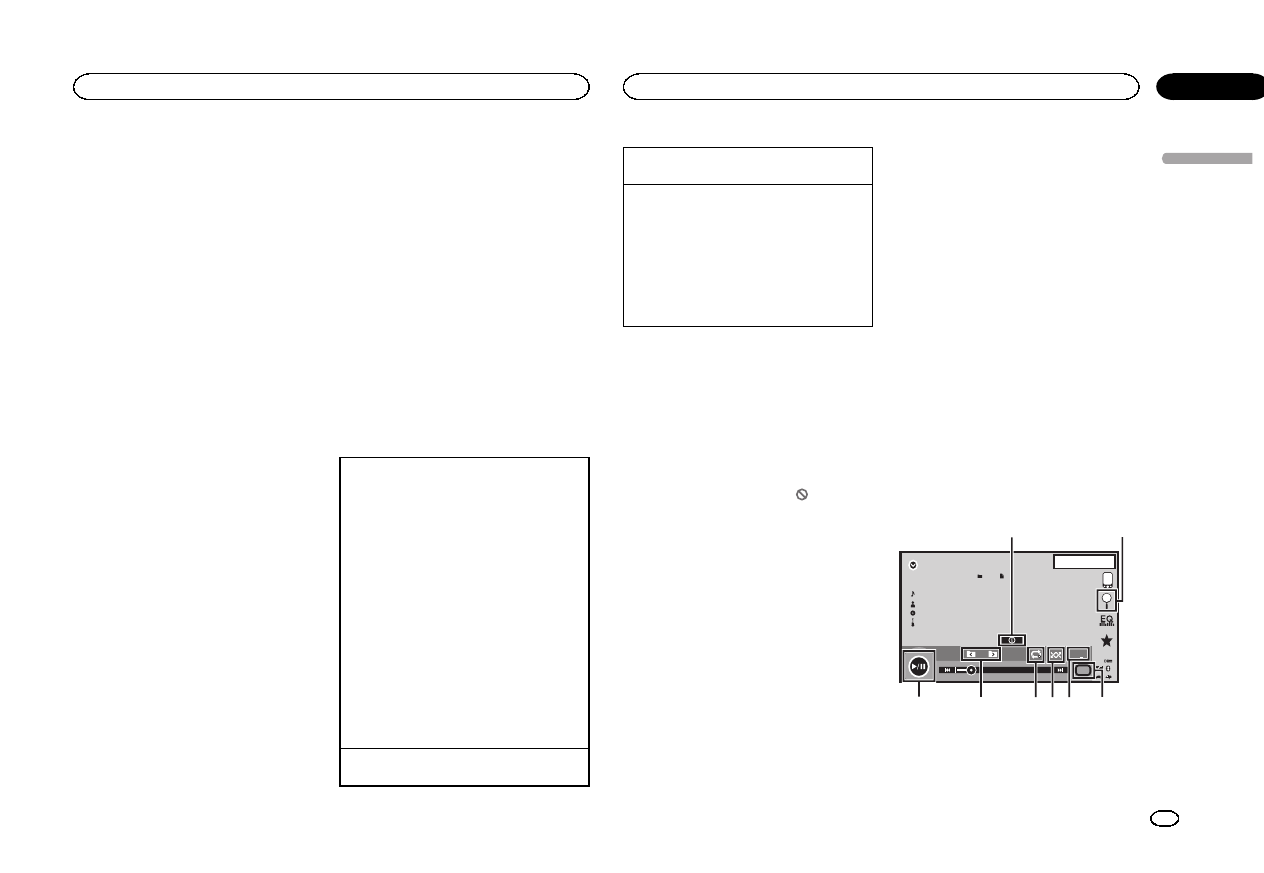
9Screen mode key
Changing the screen mode.
Refer to Changing the wide-screen mode on
page 10.
aPause and play key
Pausing playback.
Returning to normal playback during
paused, slow motion, or frame-by-frame play-
back.
bReturn key
Returning to the specified scene to which
the DVD currently being played has been pre-
programmed to return.
This function cannot be used if a specified
scene has not been preprogrammed on the
DVD disc.
cBookmark key
During playback, touch the point at which
you want to resume playback the next time
the disc is loaded.
!You can set one bookmark per DVD video.
You can set up to five bookmarks total.
!To clear the bookmark on a disc, touch
and hold the key during playback.
!The oldest bookmark is replaced by the
new one.
dArrow key
Displaying arrow keys to operate the DVD
menu.
eRepeat key
Selecting the repeat range.
fViewing angle key
With DVDs featuring multi-angle (scenes
shot from multiple angles) recordings, you
can switch among viewing angles during
playback.
gAudio output key
Switching the audio output, when playing
video discs recorded with LPCM audio.
hSlow key
Speeding down the playback speed in four
steps, during slow motion playback on DVD
video/Video CD.
!There is no sound during slow motion
playback.
!Images during slow motion playback may
be unclear for some discs.
!Reverse slow motion playback is not avail-
able.
iMedia key
Switching between media file types to play
on DVD/CD/USB.
Basic operations
Playing back videos
1Insert the disc into the disc loading slot with
the label side up.
Playback will automatically start.
!If you are playing a DVD or Video CD, a menu
may appear. Refer to Operating the DVD menu
on the next page and PBC playback on page
19.
!When the automatic playback function is on,
the unit will skip the DVD menu and automati-
cally start playback from the first chapter of
the first title. Refer to Automatic playback of
DVDs on page 37.
!When the source icon is not displayed, it can
be displayed by touching the screen.
!If a message is displayed after loading a disc
containing DivX VOD content, touch Play.
Refer to Playing DivXâVOD content on page
19.
Ejecting a disc
!Refer to Ejecting a disc on page 11.
Selecting a chapter using the buttons
1Press cor d(TRK).
Fast forwarding or reversing using the buttons
1Press and hold cor d(TRK).
!Fast forward/fast reverse may not always be
possible on some discs. In such cases, normal
playback will automatically resume.
!The fast forward/fast reverse speed depends
on the length of time you press and hold down
cor d(TRK). This function is not available for
Video CD.
Notes
!This DVD player can play back a DivX file re-
corded on CD-R/RW, DVD-R/RW, or MPEG-1/
MPEG-2/MPEG-4. (Please see the following
section for files that can be played back.
Refer to DivX video files on page 59.)
!Do not insert anything other than a DVD-R/
RW or CD-R/RW into the disc loading slot.
!Some operations may not be available while
watching a media due to the programming
of the disc. In such cases, the icon ap-
pears on the screen.
!There may be touch panel keys not listed
under Introducing movie operations on the
previous page that appear on the screen.
Refer to Indicator list on page 57.
!With some DVDs, switching between lan-
guages/audio systems may only be possible
using a menu display.
!You can also switch between languages/
audio systems using Video Setup menu. For
details, refer to Setting the audio language on
page 35.
!This unit will return to normal playback if you
change the audio language during fast for-
ward/fast reverse, pause or slow motion play-
back.
!With some DVDs, switching between subtitle
languages may only be possible using a
menu display.
!You can also switch between subtitle lan-
guages using Video Setup menu. For de-
tails, refer to Setting the subtitle language on
page 35.
!This unit will return to normal playback if you
change the subtitle language during fast for-
ward/fast reverse, pause or slow motion play-
back.
!During playback of a scene shot from multi-
ple angles, the angle icon is displayed. Use
the Video Setup menu to turn the angle
icon display on or off. For details, refer to Set-
ting the multi-angle DVD display on page 35.
!You will return to normal playback if you
change the viewing angle during fast for-
ward/fast reverse, pause or slow motion play-
back.
Sound playback operations
You can use this unit to listen to DVD-R/DVD-
RW/CD/CD-R/CD-RW sound files.
Touch panel keys
ROM
S.Rtrv
11
Abcdefghi
Abcdefghi
Abcdefghi
Abcdefghi
1JAN
PM
12:43
00'37'' -08'43''
Dolby PLll
12
45678 3
Media
1Information key
Switching the text information to display on
this unit when playing MP3/WMA/AAC files.
English
Disc (CD/DVD)
17
Section
Disc (CD/DVD)
En
09
<CRD4703-A/N>17
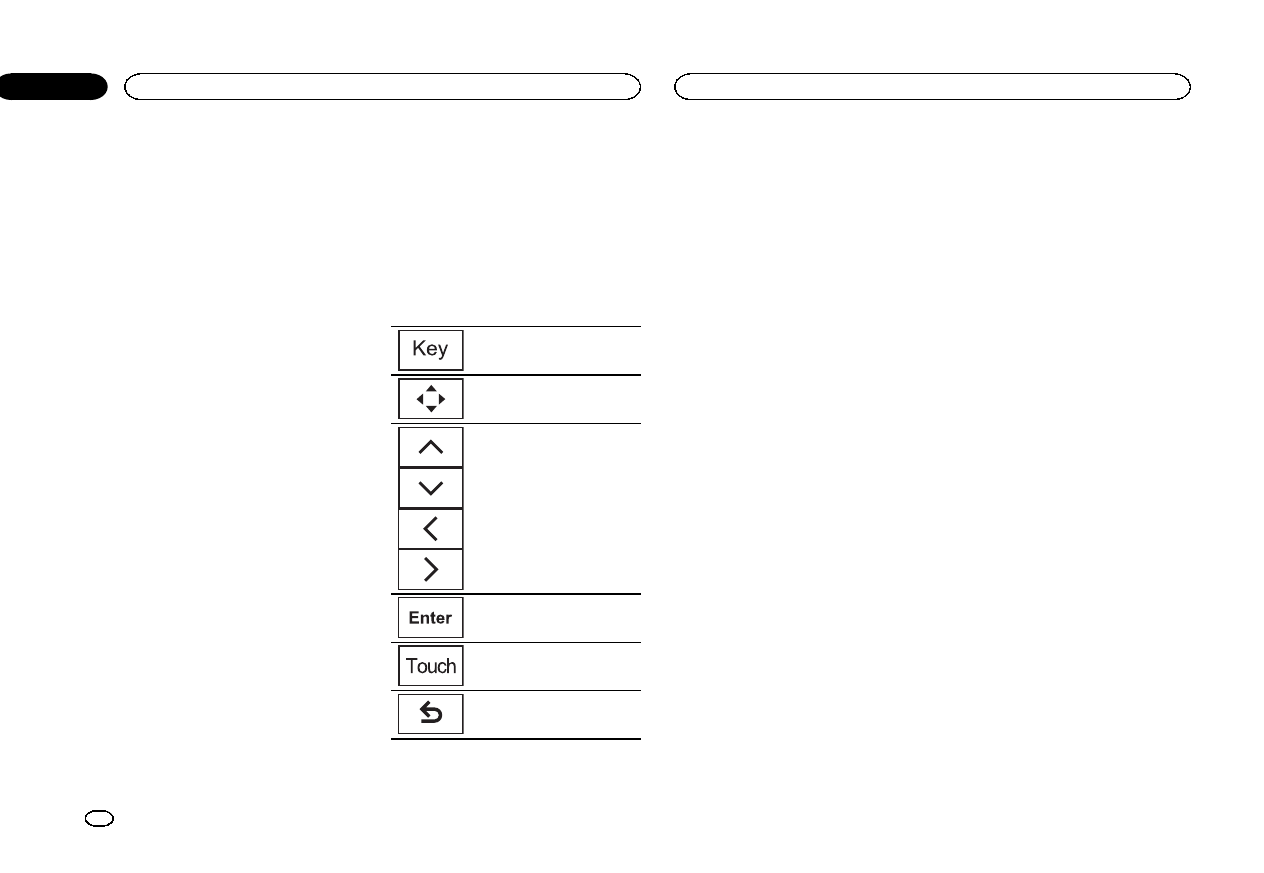
2Search key
Displaying a list of track titles/file names to
select songs on a CD.
Displaying the file name list to select the
files.
3Media key
Switching between media file types on a
DVD or CD.
4Sound retriever key
Refer to Using sound retriever on page 10.
5Random key
Playing songs in random order.
6Repeat key
Selecting the repeat range.
7Previous folder key/Next folder key
Selecting a folder.
8Pause and play key
Pausing and starting playback.
Switching the media file type
When playing a digital media containing a mix-
ture of various media file types, such as DivX,
MPEG-1, MPEG-2, MPEG-4 and MP3, you can
switch between media file types to play.
%Touch Media to switch media file types.
CD (audio data (CD-DA))—Music/ROM (com-
pressed audio)—Video (DivX, MPEG-1, MPEG-2,
MPEG-4 video files)
Note
Audio data (CD-DA) and JPEG picture files on
DVD-R/RW/ROM cannot be played back on this
unit.
Operating the DVD menu
(Function for DVD video)
Some DVDs allow you to make a selection from
the disc contents using a menu.
Using the arrow keys
1 Display arrow keys to operate the DVD
menu.
2 Select the desired menu item.
Returning to the normal DVD
video display.
Displaying arrow keys.
Selecting the desired menu item.
Starting playback from the se-
lected menu item.
Operating the DVD menu by di-
rectly touching the menu item.
Back to Previous display.
#When operating the DVD menu by directly touch-
ing the menu item, touch the icon to operate.
#Ways to display the menu will differ depending
on the disc.
#Depending on the contents of the DVD disc, this
function may not work properly. In such cases, use
the touch panel keys to operate the DVD menu.
Random play (shuffle)
%Touch the random key.
!Songs –Play back videos/songs in the se-
lected list in random order.
!Albums –Play back videos/songs from a ran-
domly selected album in order.
!Folder –Play back songs/tracks in the se-
lected folder in random order.
!Disc –Play back songs/tracks in the selected
disc in random order.
!On –Play back files in random order within
the repeat range, Folder and Disc.
!Off –Cancel random play.
Repeating playback
%Touch the repeat key.
!Disc –Play through the current disc
!Chapter –Repeat the current chapter
!Title –Repeat the current title
!Track –Repeat the current track
!File –Repeat the current file
!Folder –Repeat the current folder
!One –Repeat just the current video/song
Notes
!This function cannot be operated during
Video CD playback featuring PBC (playback
control).
!If you perform chapter search, fast forward/
reverse, frame-by-frame playback or slow mo-
tion playback, the repeat play will stop.
!When playing discs with compressed audio
and audio data (CD-DA), playback is re-
peated within the type of data currently play-
ing even if Disc is selected.
!If you select another folder during repeat
play, the repeat play range changes to Disc.
!If you perform track search or fast forward/
reverse during File, the repeat play range
changes to Folder.
!If you perform title/chapter search or fast for-
ward/reverse during Chapter, the repeat play
is set to off automatically.
!If you perform track search or fast forward/
reverse during Track, the repeat play range
changes to Disc.
!When Folder is selected, it is not possible to
play back a subfolder of that folder.
Searching for the part you
want to play
You can use the search function to find the part
you want to play.
For DVD videos, you can select Title (title),
Chapter (chapter) or 10key (numeric keypad).
For video CDs, you can select Track (track) or
10key (numeric keypad).
!Chapter search is not available when disc
playback is stopped.
!This function cannot be operated during
some DVD videos or Video CD playback fea-
turing PBC (playback control).
1 Start the search function.
Refer to Introducing movie operations on page
16.
2 Touch the desired search option (e.g.,
Chapter).
3 Touch 0 to 9 to input the desired number.
#To cancel the entered numbers, touch C.
Disc (CD/DVD)
18
Section
Disc (CD/DVD)
En
09
<CRD4703-A/N>18
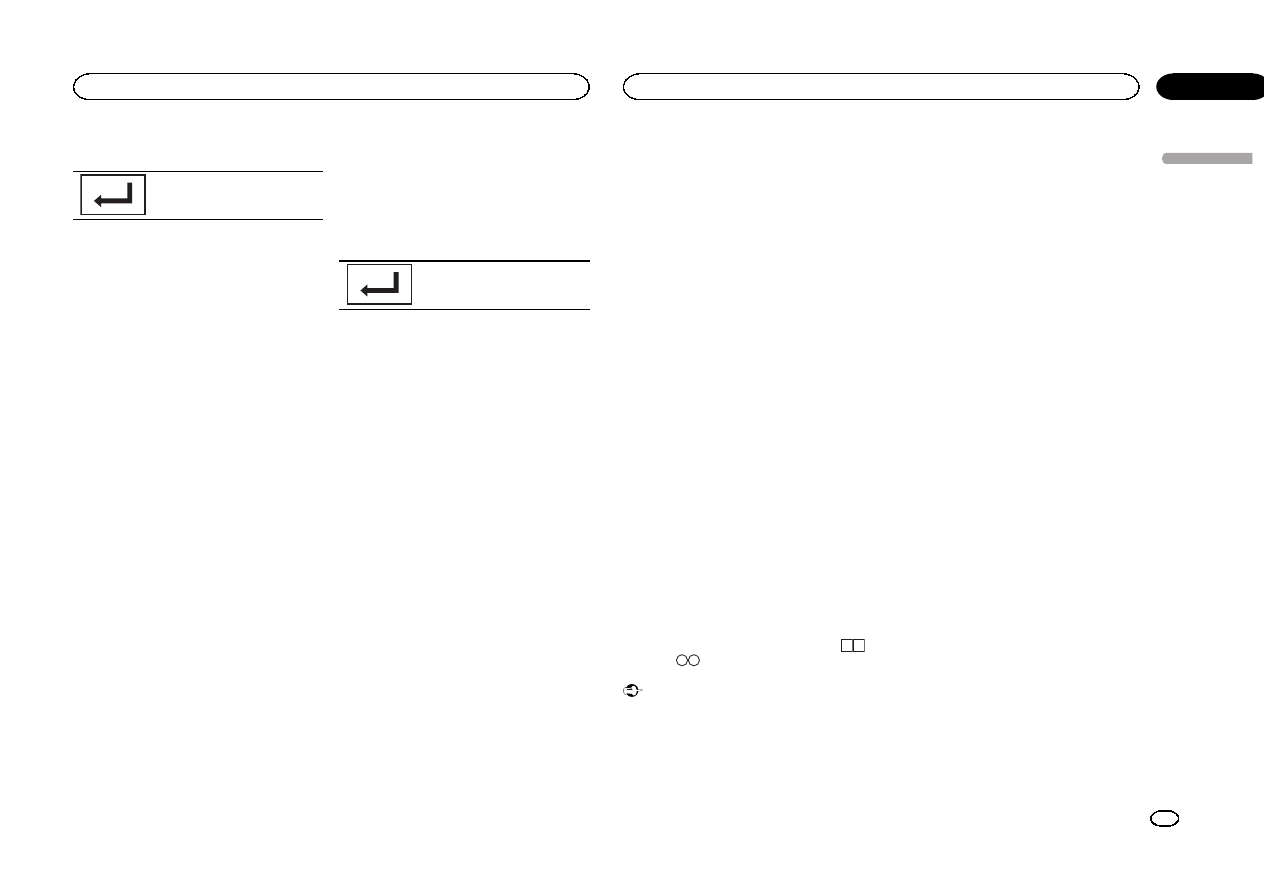
4 Start playback from the selected part.
Registering the numbers and
starting playback.
Note
With discs featuring a menu, you can also use
the DVD menu to make your selection.
Refer to Introducing movie operations on page
16.
Selecting audio output
When playing DVD video discs recorded with
LPCM audio, you can switch the audio output.
When playing video CDs, you can switch be-
tween stereo and monaural audio output.
!This function is not available when disc play-
back is stopped.
%Touch the audio output key to switch
audio output types.
!L+R –Left and right
!Left –Left
!Right –Right
!Mix –Mixing left and right
Note
You may not be able to select or use this func-
tion depending on the disc and the playback lo-
cation.
PBC playback
(Function for Video CDs)
During playback of Video CDs featuring PBC
(playback control), PBC On is displayed.
1 Start the search function.
Refer to Introducing movie operations on page
16.
2 Touch 10key to display the numeric key-
pad.
3 Touch 0 to 9 corresponding to a menu
number.
4 Start playback from the selected part.
Registering the numbers and
starting playback.
Notes
!You can display the menu by touching
Return during PBC playback. For details,
refer to the instructions provided with the
disc.
!PBC playback of a Video CD cannot be can-
celed.
!During playback of Video CDs featuring PBC
(playback control), you cannot select the re-
peat play range or use the search function.
Selecting tracks from the
track title list
You can select tracks to playback using the track
title list which is a list of the tracks recorded on
a disc.
1 Display the track title list.
Refer to Sound playback operations on page 17.
2 Touch your favorite track title.
Playback begins.
Selecting files from the file
name list
(Function for compressed audio/DivX/MPEG-1/
MPEG-2/MPEG-4)
File name list is a list of file names (or folder
names) from which you can select a file (or fold-
er) to play back.
1 Touch the search key to display the file
(or folder) name list.
2 Touch your favorite file (or folder) name.
#When you have selected a folder, a list of the
names of the files (or the folders) in it can be viewed.
Repeat this operation to select the desired file name.
#If folder 1(ROOT) contains no files, playback
commences with folder 2.
Note
If part of the recorded information does not dis-
play, a scroll key appears on the right side of list.
Touch the scroll key to scroll.
Playing DivXâVOD content
Some DivX video on demand (VOD) content may
only be playable a fixed number of times. When
you load a disc containing this type of content,
the number of times it has been played will be
shown on-screen. You can then decide whether
or not to play the disc.
!For DivX VOD content without this restriction,
you can load the disc into your player and
play the content as often as you like, with no
message displayed.
!You can confirm the number of times that
the content can be played by checking the
message, This DivX rental has used
out of views..
Important
!In order to play DivX VOD contents on this
unit, you first need to register the unit with
your DivX VOD contents provider. For details
on your registration code, refer to Displaying
the DivXâVOD registration code on page 36.
!DivX VOD content is protected by a DRM
(Digital Rights Management) system. This re-
stricts playback of content to specific, regis-
tered devices.
%If a message is displayed after loading a
disc containing DivX VOD content, touch
Play.
Playback of the DivX VOD content will start.
#To skip to the next file, touch Next Play.
#If you do not want to play the DivX VOD content,
touch Stop.
English
Disc (CD/DVD)
19
Section
Disc (CD/DVD)
En
09
<CRD4703-A/N>19
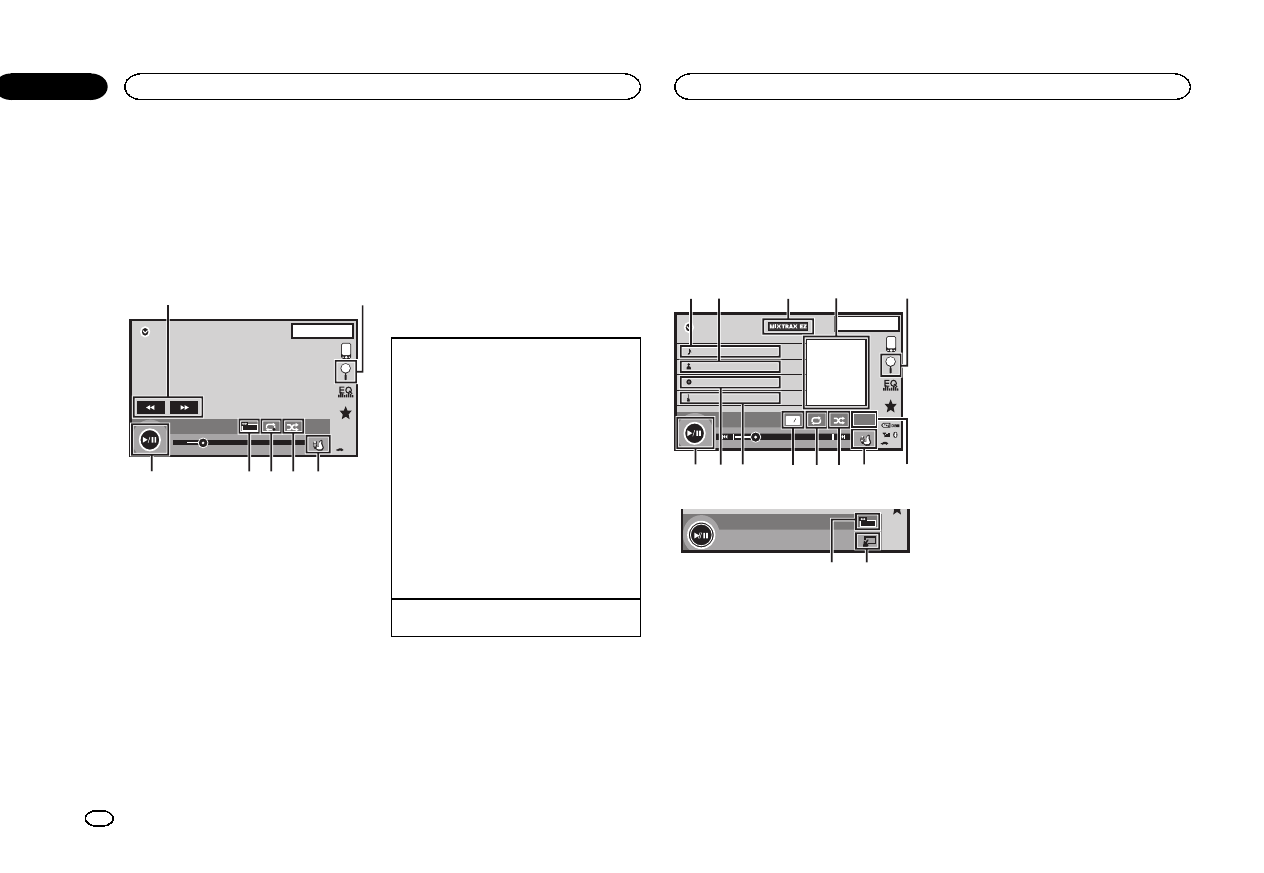
Moving images operations
You can use the unit to view iPod movie files.
!Depending on your iPod, there may not be
any output unless you use CD-IU201S/CD-
IU201V (sold separately). Be sure to use CD-
IU201S/CD-IU201V to connect your iPod.
Touch panel keys
iPod
02'35'' -21'54''
1JAN
PM
12:43
FULL 1
Appr
ppr
App
pp
App
2/3
2
1
654 37
2
1Fast forward key/Reverse key
Fast forwarding or reversing
Touch to change the fast forward and reverse
speed.
2Search key
Displaying iPod menus.
3iPod control mode key
Conducting operation from your iPod and lis-
tening to it using your car’s speakers.
4Shuffle key
Playing the video on your iPod in a random
order.
5Repeat key
Selecting the repeat range.
6Screen mode key
Changing the screen mode.
Refer to Changing the wide-screen mode on
page 10.
7Pause and play key
Pausing playback.
Returning to normal playback during
paused, slow motion, or frame-by-frame play-
back.
Basic operations
Playing back videos
1Touch the search key to pull up the iPod
menus.
2Select a movie to play.
Refer to Playing videos from your iPod on the
next page.
!When the source icon is not displayed, it
can be displayed by touching the screen.
!Disconnect headphones from the iPod be-
fore connecting it to this unit.
!Depending on the iPod model and the
amount of data stored in the iPod, it may
take some time for playback to begin.
!Use the touch panel keys to select the iPod
after connecting it to this unit.
!No Device is displayed when disconnect-
ing the iPod.
Fast forwarding or reversing using the buttons
1Press and hold cor d(TRK).
Notes
!To ensure proper operation, connect the
dock connector cable from the iPod directly
to this unit.
!While the iPod is connected to this unit, the
iPod cannot be turned on or off.
!Touch panel keys not listed under Moving im-
ages operations may appear on the display.
Refer to Indicator list on page 57.
Sound playback operations
You can use the unit to listen iPod sound files.
Note
The play time may not display correctly.
Touch panel keys
iPod audio (Control Audio)
iPod
Appr
ppr
App
pp
App
1JAN
PM
12:43
Abcdefghi
1/9
Abcdefghi
Abcdefghi
Abcdefghi
01'17'' -05'29''
S.Rtrv
All
All
All
x
12
54321
dcb a987 6
iPod audio (App Mode)
FULL
ef
1Song title
Displaying the Songs list on the iPod.
2Artist name
Displaying the Artists list on the iPod.
3MIXTRAX EZ key
Starting MIXTRAX EZ.
Refer to MIXTRAX EZ operation on page 27.
4Artwork
Starting link search on your iPod when you
touch the artwork display.
5Search key
Displaying iPod menus.
6Sound retriever key
Refer to Using sound retriever on page 10.
7iPod control mode key
Conducting operation from your iPod and lis-
tening to it using your car’s speakers.
8Shuffle key
Playing songs on the iPod in random order.
9Repeat key
Selecting the repeat range.
aChange speed key
Changing the speed of audiobook playback
on the iPod.
bGenre
Displaying the Genres list on the iPod.
cAlbum title
Displaying the Albums list on the iPod.
dPause and play key
Pausing and starting playback.
eUnit operation key
Performing operations from this unit and lis-
tening to the music on your iPod using your
car’s speakers.
fScreen mode key
Changing the screen mode.
Using this unit’s iPod
function from your iPod
You can listen to sound from applications on
your iPod using the car’s speakers when
App Mode is selected.
HiPod
20
Section
HiPod
En
10
<CRD4703-A/N>20
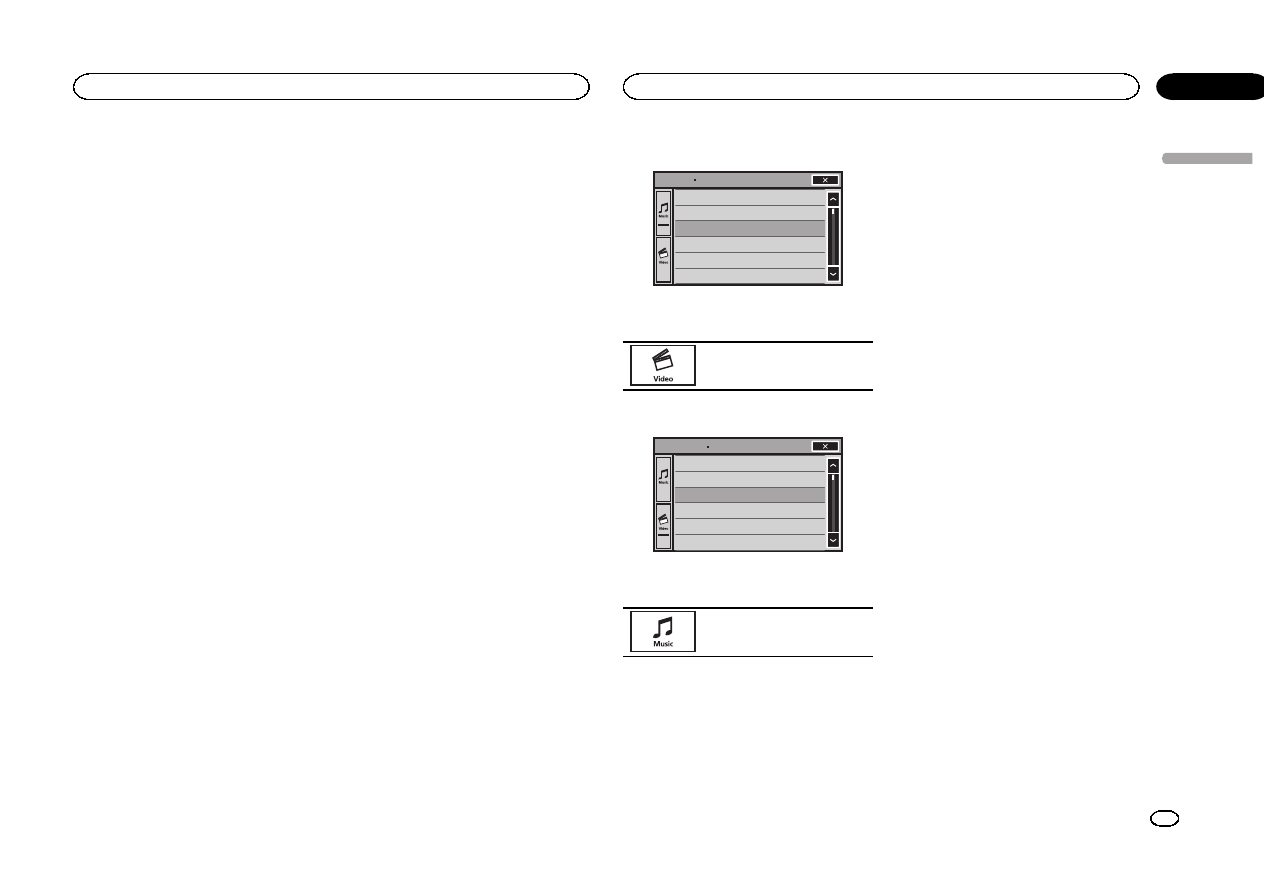
This function is not compatible with the follow-
ing iPod models.
!iPod nano 1st generation
!iPod with video
Note
While this function is in use, the iPod will not
turn off even if the ignition key is turned off. Op-
erate the iPod to turn off the power.
1 Switch the control mode to App Mode.
Refer to Moving images operations on the pre-
vious page.
Refer to Sound playback operations on the pre-
vious page.
2 Operate the connected iPod to select a
video/song and play.
Notes
!The following functions are still accessible
from the unit even if the control mode is set
to App Mode.
However, the operation will depend on your
applications.
—Playing/pausing
—Fast forwarding/reversing
—Tracking up/down
—Moving to a chapter up/down
!App Mode is compatible with the following
iPod models.
—iPod touch 4th generation
—iPod touch 3rd generation
—iPod touch 2nd generation
—iPod touch 1st generation
—iPod classic 160GB
—iPod classic 120GB
—iPod classic
—iPod nano 6th generation
—iPod nano 5th generation
—iPod nano 4th generation
—iPod nano 3rd generation
—iPod nano 2nd generation
—iPhone 4S
—iPhone 4
—iPhone 3GS
—iPhone 3G
—iPhone
Shuffle play
%Touch the shuffle key.
!Songs –Play back videos/songs in the se-
lected list in random order.
!Albums –Play back videos/songs from a ran-
domly selected album in order.
!Folder –Play back songs/tracks in the se-
lected folder in random order.
!On –Play back files in random order within
the repeat range.
!Off –Turn off shuffle play.
Repeating playback
%Touch the repeat key.
!One –Repeat just the current video/song
!All –Repeat all videos/songs in the selected
list on the iPod
Playing videos from your iPod
Videos can be played on this unit if an iPod with
video capabilities is connected.
!This unit can play back “Movies”,“Music vid-
eos”,“Video Podcast”and “TV show”which
are downloaded from the iTunes store.
1 Touch Search to display iPod menus.
Refer to Moving images operations on the pre-
vious page.
2 Switch to iPod video mode.
Playlists
Artists
Albums
Songs
Podcasts
Genres
ROOT
#If you want to switch to iPod video mode, touch
the icon.
Switching to iPod video mode.
3 Play the video from the iPod.
Video Playlists
Movies
Music Videos
Video Podcasts
TV Shows
Rentals
ROOT
#If you want to switch to iPod music mode, touch
the icon.
Switching to iPod music mode.
Browsing for a video/music
on the iPod
To make operating and searching easy, opera-
tions to control an iPod with this unit are de-
signed to be as similar to the iPod as possible.
Searching for a video/music by
category
1 Touch the search key to pull up the iPod
menus.
Refer to Sound playback operations on the pre-
vious page.
2 Touch one of the categories in which you
want to search for a video/music.
!Video Playlists (video playlists)
!Movies (movies)
!Music Videos (music videos)
!Video Podcasts (video podcasts)
!TV Shows (TV shows)
!Rentals (rentals)
!Playlists (playlists)
!Artists (artists)
!Albums (albums)
!Songs (songs)
!Podcasts (podcasts)
!Genres (genres)
!Composers (composers)
!Audiobooks (audiobooks)
3 Touch the title of the list that you want
to play.
Repeat this operation until you find the desired
video/music.
Notes
!Depending on the generation or version of
the iPod, some functions may not be avail-
able.
!You can play playlists created with the Music-
Sphere application. The application will be
available on our website.
!Playlists that you created with the Music-
Sphere application are displayed in abbrevi-
ated form.
English
HiPod
21
Section
HiPod
En
10
<CRD4703-A/N>21
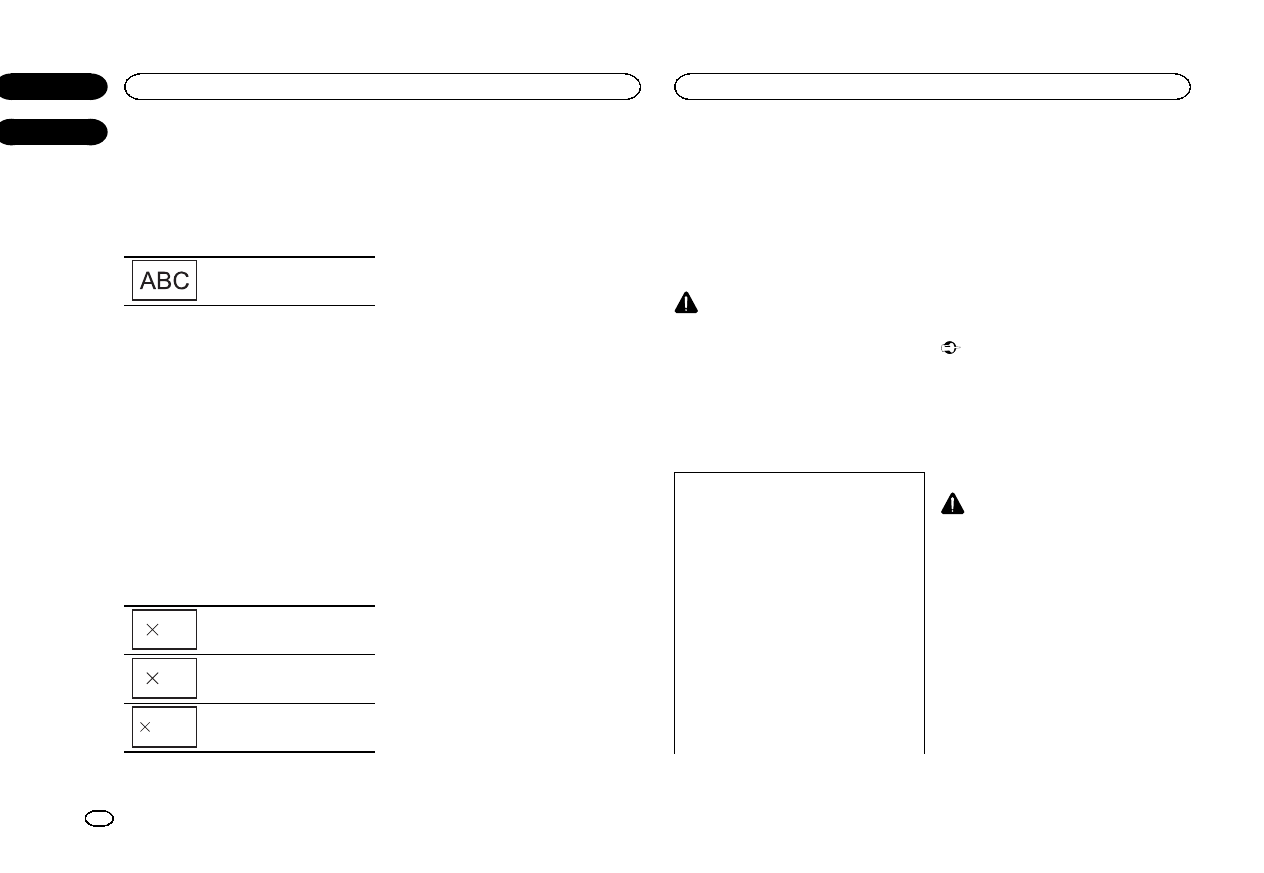
Searching the list by alphabet
1 Select a category.
Refer to Searching for a video/music by category
on the previous page.
2 Switch to alphabet search mode.
Switching to alphabet search
mode.
Alphabet search mode is displayed.
3 Touch the first letter of the title of the
video/song you are looking for.
While searching, touch panel key operation is
not available.
#To refine the search with a different letter, touch
Cancel.
4 Touch the title of the list that you want
to play.
Repeat this operation until you find the desired
song/video.
Changing audiobook speed
%Touch the change speed key to change
the speed.
2Playback at a speed faster than
normal
1Playback at normal speed
1/2 Playback at a speed slower than
normal
Displaying lists related to
the song currently playing
(link search)
Touch the artwork to open a list of the names of
songs on the album currently playing. Touch the
name of the song you want to play to start play-
ing that song.
Note
If part of the recorded information does not dis-
play, a scroll key appears on the right side of list.
Touch the scroll key to scroll.
Advanced App Mode operation
This system can switch to the Advanced App
Mode, which you can display and operate the
application for iPhone on the screen.
In Advanced App Mode, you can operate appli-
cations with finger gestures such as tapping,
dragging, scrolling or flicking on the screen of
the system.
WARNING
Certain uses of a smartphone may not be
legal while driving in your jurisdiction, so
you must be aware of and obey any such re-
strictions.
If in doubt as to a particular function, only
perform it while the car is parked.
No feature should be used unless it is safe
to do so under the driving conditions you
are experiencing.
!Pioneer is not liable for any issues that
may arise from incorrect or flawed app-
based content.
!The content and functionality of the sup-
ported applications are the responsibility
of the App providers.
!In Advanced App Mode, functionality
through the product is limited while driv-
ing, with available functions determined
by the App providers.
!Availability of Advanced App Mode func-
tionality is determined by the App provider,
and not determined by Pioneer.
!Advanced App Mode allows access to ap-
plications other than those listed (subject
to limitations while driving), but the extent
to which content can be used is deter-
mined by the App providers.
Advanced App Mode is compatible with the fol-
lowing iPod models.
!iPhone 4S
!iPhone 4
!iPod touch 4th generation
—Applications operable by switching this sys-
tem to Advanced App Mode are only those
available for Advanced App Mode.
—Please check iPhone applications supported
Advanced App Mode at
http://www.pioneerelectronics.com/
AppRadio
Important
!Use the CD-IU201S (sold separately) when you
use this function.
!The only port that supports Advanced App Mode
is USB input.
!When listening to music and sounds from appli-
cation simultaneously, see the following section.
Refer to Setting the App sound mixing on the next
page.
CAUTION
!While driving, you cannot enter text on your iPod.
!Use the connected iPod to open an application.
Starting procedure
1 Install the AppRadio app on your iPhone.
2 Set the RGB Input to iPhone under Sys-
tem settings.
When you use this function, set the RGB input
to iPhone. For details, refer to Setting the RGB
Input on page 37.
3 Start an application available for Ad-
vanced App Mode from the iPhone.
An image of the application is displayed on the
screen of this system.
HiPod
22
Section
Advanced App Mode
En
10
11
<CRD4703-A/N>22
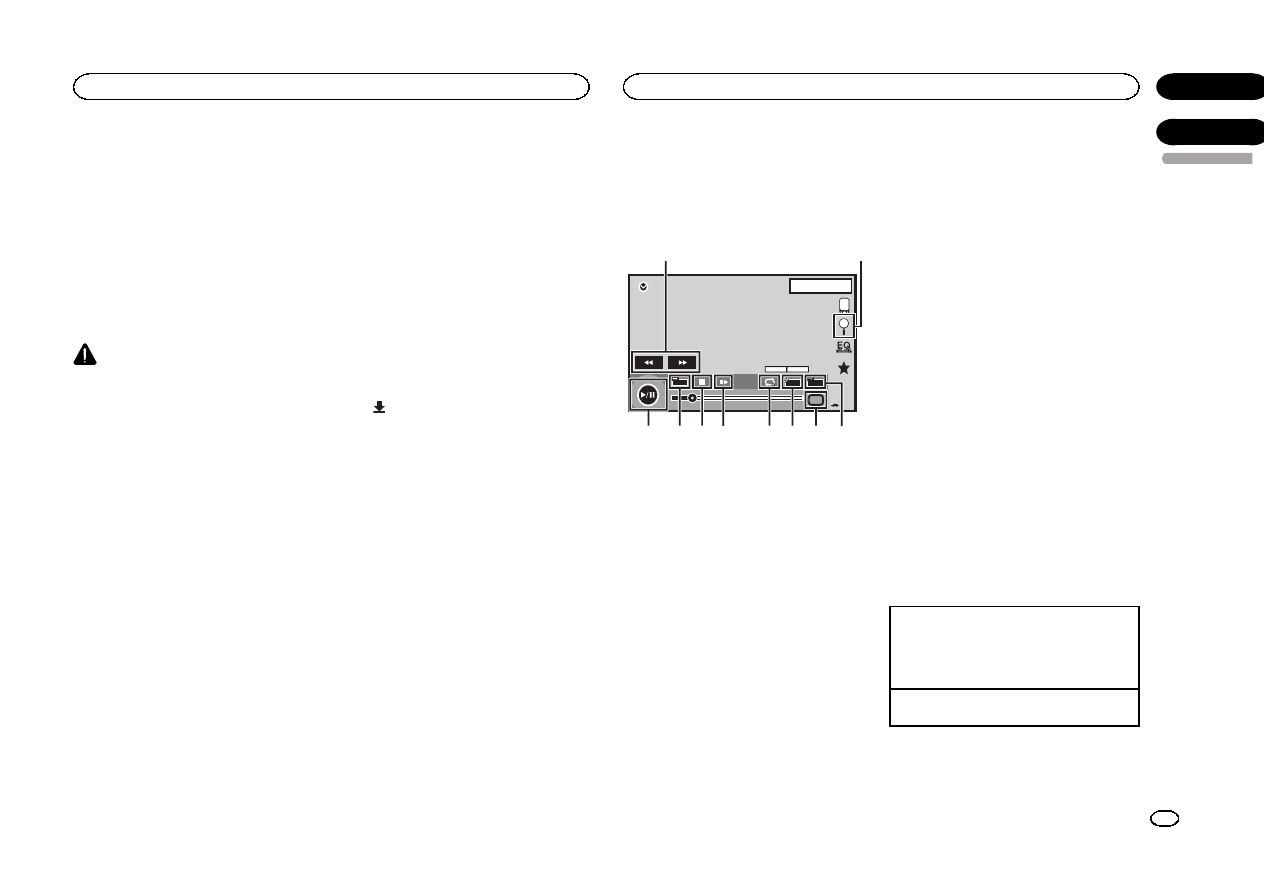
!You can start an application available for Ad-
vanced App Mode also from a launcher appli-
cation.
4 Press the home button to switch to the
home display.
5 Touch the Apps key.
6 Operate the application.
Setting the Keyboard
CAUTION
For your safety, the keyboard functionality is only
available when the vehicle is stopped and the
parking brake is engaged.
Depending on the application, you can input
text on the display. In order to input text correctly
using keyboard which appears on this unit, you
need to set the language setting in this function.
When the Advanced App Mode is used, the lan-
guage setting for the keyboard set for the func-
tion and the language setting for the iPhone
keyboard need to be the same.
!Keyboard is available only in Advanced App
Mode.
When you tap a text input area of an application
for iPhone, a keyboard will be displayed on-
screen. You can input the desired text directly
from this system.
!The language preference for the keyboard of
this system should be same as the setting on
your iPhone.
If the settings for this product and the
iPhone are different, you may not be able to
enter characters properly.
1 Press the home button to switch to the
home display.
2 Touch the system key to open the system
menu.
3 Touch Keyboard on the System menu to
select desired language.
4 Touch the desired language.
French (French)—German (German)—Greek
(Greek)—Russian (Russian)—English (US Eng-
lish)—English (UK) (UK English)—Dutch
(Dutch)—Italian (Italian)—Norwegian (Norwe-
gian)—Swedish (Swedish)—Finnish (Finnish)
—Spanish (Spanish)—Portuguese (Portu-
guese)
5 Tap the text input area on the application
screen of the iPhone.
Touch to hide the keyboard.
Setting the App sound mixing
You cannot turn on or off Mixing when this unit
is playing a song of iPod.
The sound of application during Advanced App
Mode can be adjusted.
Enable this setting when you want to mix the
App sound with the sound from a built-in source
(such as the radio). The volume of the App
sound can be selected from 3 levels.
1 Press the home button to switch to the
home display.
2 Touch the system key to open the system
menu.
3 Touch App sound mixing on the System
menu to select desired setting.
OFF (off)—Low (low)—Mid (mid)—High (high)
Moving images operations
You can use this unit to view USB storage device
files.
Touch panel keys
USB
00'20'' -119'51''
Dolby DMulti ch
FULL
11
1JAN
PM
12:43
01 01
Media
1
a987 5
643
2
1Fast forward key/Reverse key
Fast forwarding or reversing
Touch to change the fast forward and reverse
speed.
2Search key
Displaying USB menus.
3Switch subtitle language key
With DivX files featuring multi-subtitle re-
cordings, you can switch between subtitle
languages during playback.
4Media key
Switching between media file types to play
on Music/Video/Photo.
5Switch audio language key
With DivX files that provides audio playback
in different languages and different audio
systems (Dolby Digital, DTS, etc.), you can
switch between languages/audio systems
during playback.
6Repeat key
Selecting the repeat range.
Refer to Repeating playback on page 25.
7Slow-motion playback key
(Function for DivX file/MPEG-1/MPEG-2/
MPEG-4)
Moving the selection ahead one frame at a
time during playback.
Touch and hold down the key for more than
two seconds to slow down playback speed.
8Stop key
Stopping playback.
If you resume playback, playback will start
from the point where you stopped. Touch the
key again to stop playback completely.
9Screen mode key
Changing the screen mode.
Refer to Changing the wide-screen mode on
page 10.
aPause and play key
Pausing playback.
Returning to normal playback during
paused, slow motion, or frame-by-frame play-
back.
Basic operations
Playing back videos
1Connect the USB device.
Playback will automatically start.
When the source icon is not displayed, it can
be displayed by touching the screen.
Fast forwarding or reversing using the buttons
1Press and hold cor d(TRK).
Notes
!Touch panel keys not listed under Moving im-
ages operations may appear on the display.
Refer to Indicator list on page 57.
English
Advanced App Mode
23
Section
USB
En
11
12
<CRD4703-A/N>23
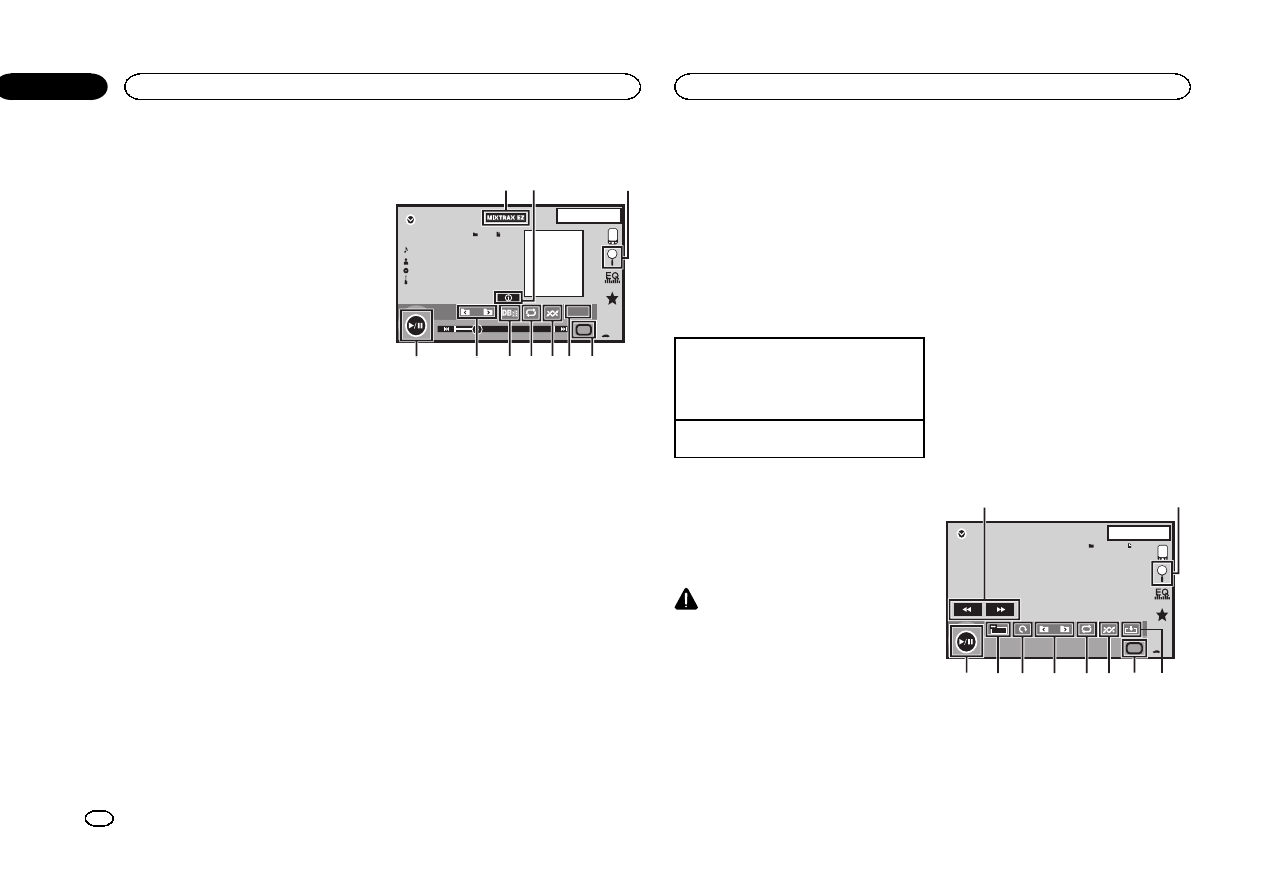
!You can also switch between languages/
audio systems using Video Setup menu. For
details, refer to Setting the audio language on
page 35.
!This unit will return to normal playback if you
change the audio language during fast for-
ward/fast reverse, pause or slow motion play-
back.
!You can also switch between subtitle lan-
guages using Video Setup menu. For de-
tails, refer to Setting the subtitle language on
page 35.
!This unit will return to normal playback if you
change the subtitle language during fast for-
ward/fast reverse, pause or slow motion play-
back.
Sound playback operations
You can use this unit to listen to USB audio files.
Notes
!The play time may not display correctly.
!When playing back files recorded as VBR
(variable bit rate) files, the play time will not
be correctly displayed if fast forward or re-
verse operations are used.
!To ensure proper operation, connect the
dock connector cable from the iPod directly
to this unit.
!While the iPod is connected to this unit, the
iPod cannot be turned on or off.
!If the characters recorded on the disc are not
compatible with this unit, those characters
will not be displayed.
!Text information may not be correctly dis-
played depending on the recorded environ-
ment.
!Disconnect the USB portable audio player/
USB memory when you are done using it.
!When you select Speana on Selecting the
background display on page 43, the artwork is
not displayed.
Touch panel keys
00'01'' -00'03''
JAN
PM
12:43
USB
Abcdefghi
Abcdefghi
Abcdefghi
Abcdefghi
S.Rtrv
61
All
All
All
Media
21
a987654
3
1MIXTRAX EZ key
Starting MIXTRAX EZ.
2Information key
Switching the text information to display on
this unit when playing MP3/WMA/AAC/WAV
files.
3Search key
Displaying the file name list to select the
files.
4Media key
Switching between media file types to play
on USB.
5Sound retriever key
Refer to Using sound retriever on page 10.
6Random key
Playing songs in random order.
7Repeat key
Selecting the repeat range.
8DB key
Creating a database that enables searches
by artist name, genre, and other options.
Refer to Music browse mode on this page.
9Previous folder key/Next folder key
Selecting a folder.
aPause and play key
Pausing and starting playback.
Basic operations
Playing back tracks
1Connect the USB device.
Playback will automatically start.
When the source icon is not displayed, it can
be displayed by touching the screen.
Fast forwarding or reversing using the buttons
1Press and hold cor d(TRK).
Music browse mode
(Function for USB)
This unit creates an index in order to facilitate
browsing for a song. You can search by the cate-
gories such as Albums and Artists.
CAUTION
!This function is not available when the USB
storage device is locked.
!This function is not available when the free
space of USB storage device is less than
5MB.
!While this unit creates an index, do not turn
the unit off. It may cause loss of data on your
USB storage device.
!If you switch to video or JPEG image display
while a database is being created, or when a
database could not be created, a message
appears and database creation stops.
1 Touch DB to create a database in Music
browse mode.
Refer to Sound playback operations on this page.
2 When “Save the Database to memory?”
is displayed, touch “Yes”.
Saving of the database is completed. If you do
not save it, touch “No”.
When the saving is completed, “Database save
to memory was completed.”appears.
Music browse mode will start.
3 Display a list and touch the tag key.
4 Select a file.
Still image playback operations
You can use this unit to view still images saved
on a USB storage device.
Touch panel keys
USB
NORMAL
1JAN
PM
12:43
44
All
All
All
Media
12
3456789a
1Fast forward key/Reverse key
Selecting a picture.
2Search key
Displaying the file name list to select the
files.
USB
24
Section
USB
En
12
<CRD4703-A/N>24
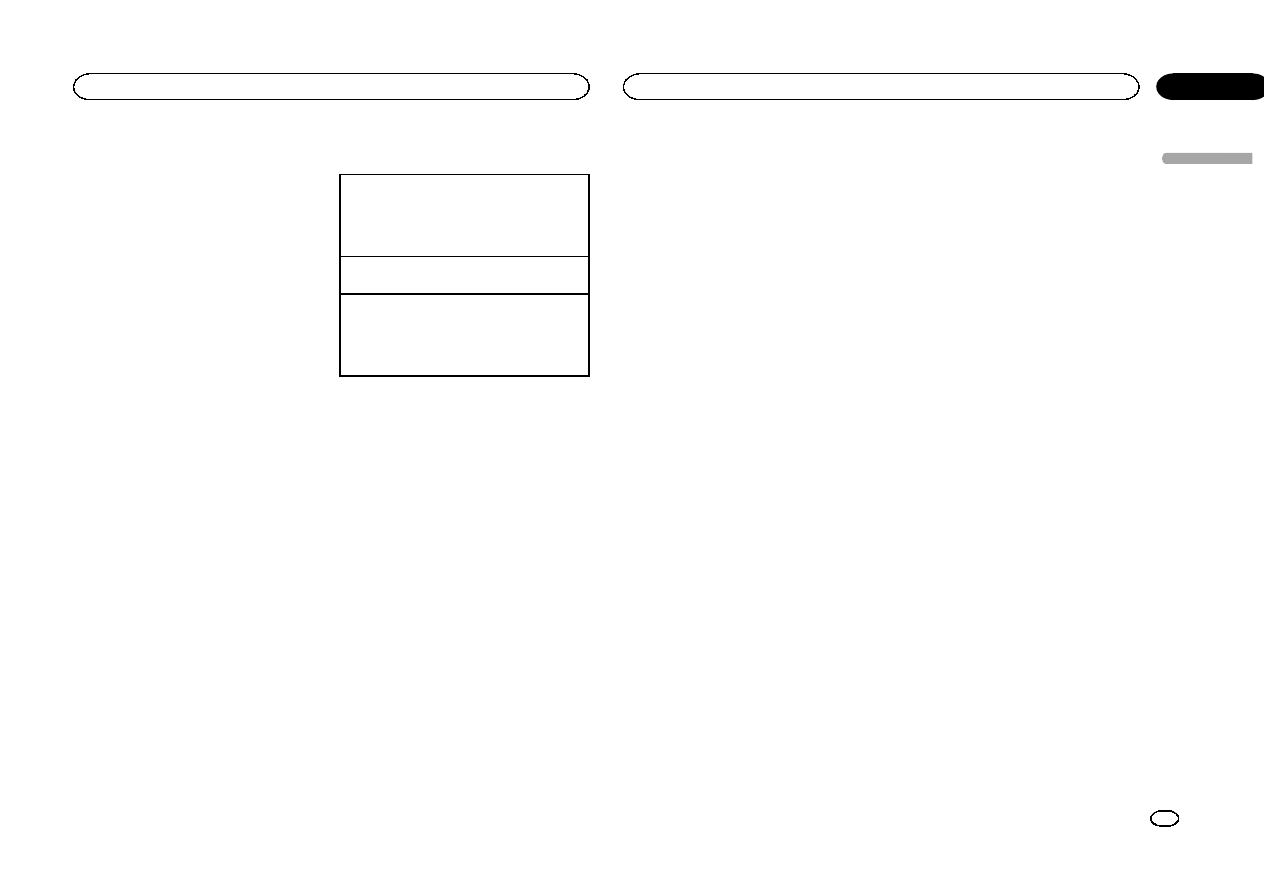
3Capture key
Capturing an image in JPEG files.
4Media key
Switching between media file types when
there is more than one media file type saved
to the USB device. This key does not appear
if there is only one media file type saved to
the USB device.
5Random key
Playing files in a random order.
6Repeat key
Selecting the repeat range.
7Previous folder key/Next folder key
Selecting a folder.
8Rotate key
Rotating the displayed picture 90° clockwise.
9Screen mode key
Changing the screen mode.
Refer to Changing the wide-screen mode on
page 10.
aPause and play key
Starting or pausing the slideshow.
Basic operations
Playing still images
1Connect the USB device.
Playback will automatically start.
!When the source icon is not displayed, it can
be displayed by touching the screen.
Selecting a file using the buttons
1Press cor d(TRK).
Fast file searching
1Press and hold cor d(TRK).
!You can search 10 JPEG files at a time.
If there are fewer than 10 files, the search will
cover the first or last file.
Notes
!Files are played back in file number order
and folders are skipped if they contain no
files. (If folder 1(ROOT) contains no files,
playback commences with folder 2.)
!Touch panel keys not listed under Still image
playback operations may appear on the dis-
play.
Refer to Indicator list on page 57.
Switching the media file type
%Touch Media to switch between media
file types.
Random play (shuffle)
%Touch the random key.
!On –Play back files in random order within
the repeat range, Folder and Media.
!Off –Cancel random play.
Repeating playback
%Touch the repeat key.
!Folder –Repeat the current folder
!All –Repeat all files
!When Folder is selected, it is not possible to
play back a subfolder of that folder.
!If you select USB source, the repeat play
range changes to All.
Selecting files from the file
name list
(Function for compressed audio/DivX/MPEG-1/
MPEG-2/MPEG-4)
Operation is the same as that for Disc.
Refer to Selecting files from the file name list on
page 19.
Displaying lists related to
the song currently playing
(link search)
Touch the artwork to open a list of the names of
songs on the album currently playing. Touch the
name of the song you want to play to start play-
ing that song.
Notes
!If part of the recorded information does not
display, a scroll key appears on the right side
of list. Touch the scroll key to scroll.
!This function is available for USB devices in
Music browse mode.
Playing DivXâVOD content
Operation is the same as that for Disc.
Refer to Playing DivXâVOD content on page 19.
Capture an image in JPEG files
You can capture image data and use it as wall-
paper. Images can be stored and recalled easily
in this unit.
!Only one image can be stored on this unit.
Old image is overwritten with the new one.
1 Touch fto pause the slide show when
the desired image is displayed.
2 Touch Capture to capture the desired
image.
3 When “Do you save this image?”is dis-
played, touch Yes.
While storing the image to this unit, “Saving
the image. Don’t switch off the battery.”is
displayed. When the process is finished, “Image
saved.”is displayed.
#To cancel the storage process, touch No.
English
USB
25
Section
USB
En
12
<CRD4703-A/N>25
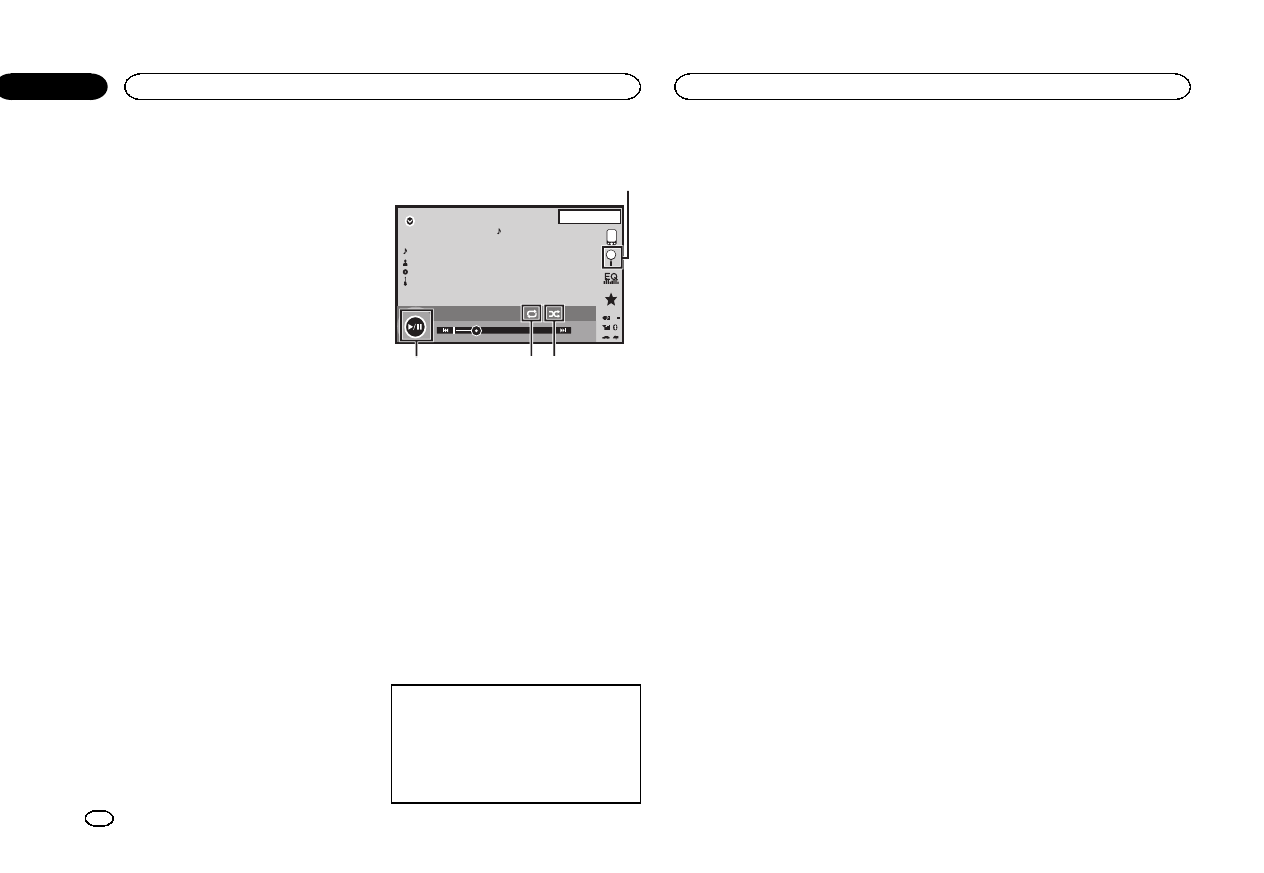
Sound playback operations
(Function of AVH-X5500BHS/AVH-X4500BT/AVH-
X3500BHS/AVH-X2500BT)
You can use this unit to listen to Bluetooth audio
files.
Notes
!Depending on the Bluetooth audio player
connected to this unit, the available opera-
tions will be limited to the following two lev-
els:
—A2DP profile (Advanced Audio Distribution
Profile): You can only playback songs on your
audio player.
—AVRCP profile (Audio/Video Remote Control
Profile): You can perform playback, pause
playback, select songs, etc.
!As there is a wide variety of Bluetooth audio
players available on the market, operations
available with specific models may vary ex-
tensively. When attempting to run a
Bluetooth audio player using this unit, refer
to the instruction manual that came with the
player as well as to this manual for assis-
tance.
!As the signal from your cellular phone may
cause noise, avoid using it when you are lis-
tening to songs on your Bluetooth audio
player.
!The sound from a Bluetooth audio player
connected to this unit will be muted while a
call is in progress on a cellular phone con-
nected to this unit via Bluetooth wireless
technology.
!The play time may not display correctly.
!Depending on the type of Bluetooth audio
player you have connected to this unit, oper-
ation and information display may not be
available for some functions.
Touch panel keys
Bluetooth
88'88'' -88'88''
Abcdefghi
Abcdefgh
Abcdefgh
Abcdefgh
8888
22 JAN
AM
12:22
DB
432
1
1Search key
Displaying the file name list to select the
files.
2Random key
Playing songs in random order.
3Repeat key
Selecting the repeat range.
4Pause and play key
Pausing and starting playback.
Setting up for Bluetooth audio
Before you can use the Bluetooth audio function
you must establish a Bluetooth wireless connec-
tion between the unit and your Bluetooth audio
player.
1Connection
First, you need to connect a Bluetooth audio to
this unit.
For detailed instructions on connecting your
Bluetooth audio to this unit via Bluetooth wire-
less technology, refer to Bluetooth connection
menu on page 42.
Notes
!When playing back files recorded as VBR
(variable bit rate) files, the play time will not
be correctly displayed if fast forward or re-
verse operations are used.
!To ensure proper operation, connect the
dock connector cable from the iPod directly
to this unit.
!While the iPod is connected to this unit, the
iPod cannot be turned on or off.
!If the characters recorded on the disc are not
compatible with this unit, those characters
will not be displayed.
!Text information may not be correctly dis-
played depending on the recorded environ-
ment.
Random play (shuffle)
%Touch the random key.
!On –Play back files in random order.
!Off –Cancel random play.
Repeating playback
%Touch the repeat key.
!One –Repeat the current song only
!All –Repeat all songs
HBluetooth Audio
26
Section
HBluetooth Audio
En
13
<CRD4703-A/N>26

MIXTRAX operation
MIXTRAX is original technology for creating
non-stop mixes of selections from your audio li-
brary, complete with DJ effects that make them
sound as if a DJ is right there with you playing
the music.
MIXTRAX EZ operation
You can use this unit to play iPod/USB audio
files.
MIXTRAX EZ is used to add a variety of sound ef-
fects between songs for arranging the pauses
between songs. It allows you to enjoy listening
to music non-stop.
!This function is only available when a file on
a USB storage device or a song on an iPod is
being played.
!This function is not available when the con-
trol mode is set to App Mode.
!Depending on the file/song, sound effects
may not be available.
!Depending on the file/song, non-stop play-
back may not be available.
Starting MIXTRAX EZ operation
%Touch MIXTRAX EZ.
Setting MIXTRAX mode
Turn on this function to play back audio files
using MIXTRAX.
1 Press the home button to switch to the
home display.
2 Touch the system key to open the system
menu.
3 Touch MIXTRAX Setup on the system
menu.
MIXTRAX setting items are displayed.
!Short Playback Mode –When turned on, se-
lect an audio track playback length. When
this mode is turned off, the audio track will
play all the way to the end.
60s (60 sec.)—90s (90 sec.)—120s (120 sec.)
—150s (150 sec.)—180s (180 sec.)—Random
(random)—Off (off)
When Random is selected, the playback time
varies between 60 s, 90 s, 120s, 150 s, and
180 s selected at random when the playback
song changes.
!Display Effect –When Display Effect is set
to on, the artwork display can be moved ac-
cording to the music type.
!Cut-In Effect –When Cut-In Effect is set to
on, sound effects will play between tracks.
!Effect Setting –Use Effect Setting to set up
the sound effect you want to insert between
tracks.
Setting the effect
You can change the settings for fixed sounds
and sound effects.
There are six different fixed sounds available
that can be inserted for playback between
tracks.
The sound effects are used as effects to signal
the end of a song being played and the begin-
ning of the next song in series.
The fixed sounds and sound effects are set as
combinations as MIXTRAX sounds.
Fixed sounds
!Phaser –A fixed sound that sounds like surg-
ing waves.
!Roll –A fixed sound that repeats playback of
a certain sound.
!Turntable –A fixed sound that mimics DJ
scratching.
!Flanger2 –A rushing sound that mimics
that rising and falling sounds of a jet engine.
!Reverb –A fixed sound effect that creates a
reverberation effect.
!Echo2 –A fixed sound effect that creates an
echoing effect.
Sound effects
!Cross Fade –A sound effect that creates a
fade in and fade out effect between songs.
!Flanger1 –A rushing sound that mimics
that rising and falling sounds of a jet engine.
!Echo1 –A sound effect that creates an echo-
ing effect.
!Loop –A sound effect that repeats playback
of one section of a song track.
Setting sounds and sound effects
as presets using the preset key
The Standard and Simple sound effects are set
already as default presets.
%Touch Standard or Simple to check the
settings.
The registered preset sound effect for the key
that was touched is set as a preset.
Registering sounds and sound
effects as presets
Registers a desired combination of sounds and
sound effects to Custom.
Touch Custom to easily set the desired sound or
sound effect.
1 Touch Custom.
2 Add a check mark to the desired sound
effect by touching the option.
The marked sound effect is registered as a pre-
set in Custom.
Notes
!If a sound effect is touched in the selection
screen for Standard or Simple, the Custom
screen is automatically displayed and the
sound effect is registered to Custom.
!You can listen to fixed sounds to hear exam-
ples by touching the speaker icon.
English
Using MIXTRAX
27
Section
Using MIXTRAX
En
14
<CRD4703-A/N>27
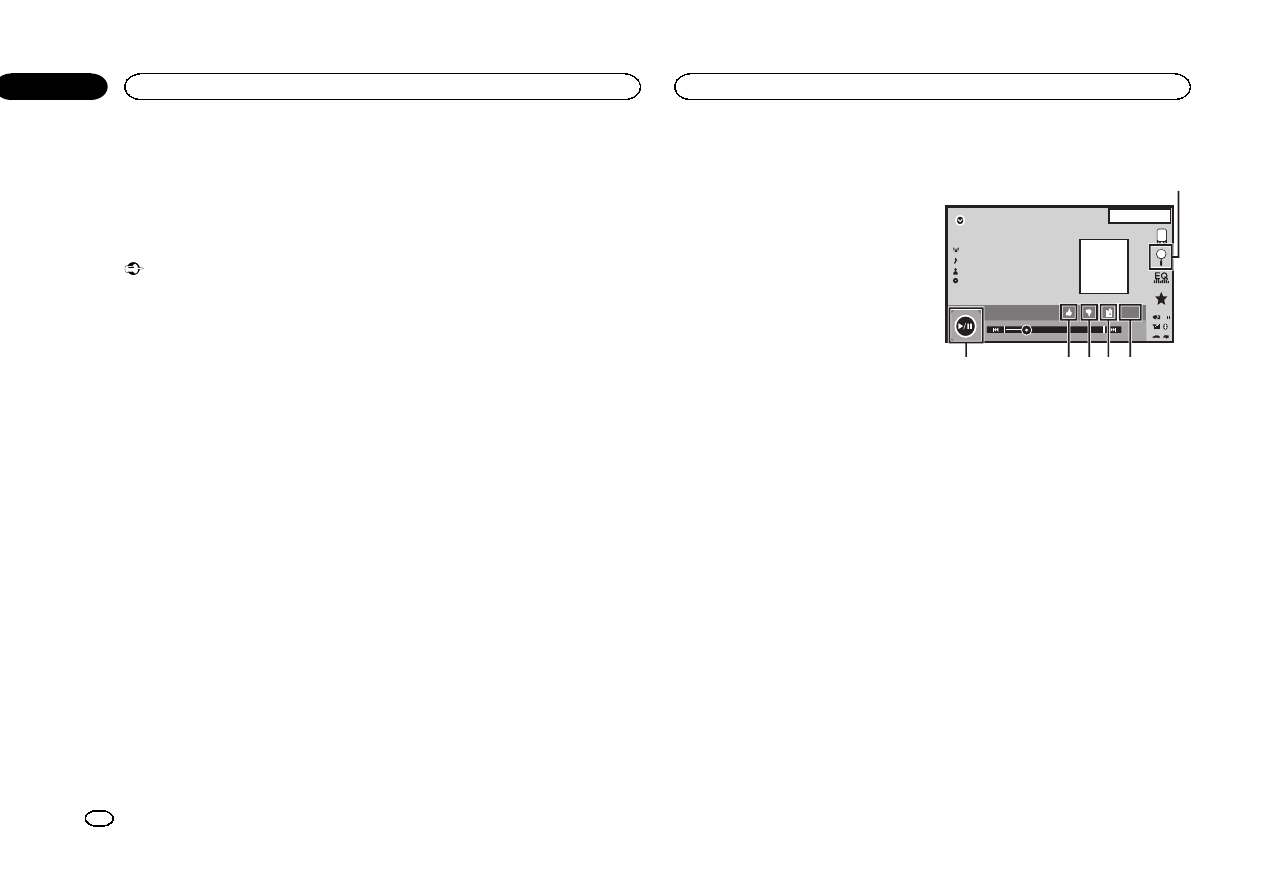
Pandora operations
To play Pandora on the Pioneer car audio/video
products, connect an iPod, iPhone, Androidä
device or BlackBerry device with the most re-
cent Pandora application installed, and start the
Pandora application.
Important
Requirements to access Pandora using the
Pioneer car audio/video products:
Connect an iPod to USB input or an Android de-
vice or a BlackBerry device using Bluetooth to
play Pandora on this unit.
!iPod and iPhone compatibility
Apple iPhone (first generation), iPhone 3G,
iPhone 3GS, iPhone 4, iPhone 4S, iPod touch 1G,
iPod touch 2G, iPod touch 3G or iPod touch 4G
(firmware version 3.0 or later)
Certain firmware versions for the iPhone may not
be compatible with the Pandora application. If
this appears to be the case, please update the
firmware to a version that is compatible with
Pandora.
!Android compatibility
Android OS Version 2.2 or later
!BlackBerry compatibility
BlackBerry OS Version 4.3 or later
!Latest version of the Pandora application, down-
loaded to your device (Search Apple iTunes App
Store or Android market for “Pandora”).
!Current Pandora account (Free account and paid
accounts available from Pandora; create a free
account online at
http://www.pandora.com/register or through the
Pandora application for the iPhone).
!Data Plan
Note: If the Data Plan for your iPhone or
Android device does not provide for unlimited
data usage, additional charges from your carrier
may apply for accessing the Pandora service via
3G and/or EDGE networks.
!Connection to the Internet via 3G, EDGE or Wi-Fi
network.
!Optional Pioneer adapter cable connecting your
iPhone to the Pioneer car audio/video products.
Limitations:
!Access to the Pandora service will depend on the
availability of a cellular and/or Wi-Fi network for
purposes of allowing your device to connect to
the Internet.
!Ability of the Pioneer car audio/video products to
access the Pandora service is subject to change
without notice and could be affected by any of
the following: compatibility issues with future
firmware versions of iPhones or Android devices;
compatibility issues with future firmware ver-
sions of the Pandora application for them;
changes to the Pandora music service by
Pandora; discontinuation of the Pandora music
service by Pandora.
!Certain functions of the Pandora service are not
available when accessing the service through the
Pioneer car audio/video products, including, but
not limited to, creating new stations, deleting sta-
tions, emailing current stations, buying tracks
from iTunes, viewing additional text information,
logging in to Pandora, and adjusting Cell Net-
work Audio Quality.
Pandora internet radio is a music service not af-
filiated with Pioneer. More information is avail-
able at http://www.pandora.com.
Setting the Pandora connect mode
Set the Pandora connection mode appropriately
to notify the system whether you are streaming
Pandora over an iPod via USB or over an
Android device or a BlackBerry device via
Bluetooth.
Notes
!The iPod must have iOS 3.0 or later installed
in order to use Pandora.
!The Android device must have Android OS
Version 2.2 or later installed to use Pandora.
!An Internet connection is required to use an
iPod, an Android device, or a BlackBerry de-
vice.
!Only iPods can be connected to the AVH-
X1500DVD.
1 Press the home button to switch to the
home display.
2 Touch the system key to open the system
menu.
3 Touch Pandora connect mode repeatedly
until the desired setting appears on the
screen.
Wired: An iPod is connected using an actual
cable.
Bluetooth: An Android device or a BlackBerry
device is connected using Bluetooth.
Touch panel keys
Pandora
88'88'' -88'88''
Abcdefghi
Abcdefghi
Abcdefghi
Abcdefghi
22 JAN
AM
12:22
DB
Dolby PLII
S.Rtrv
1
23456
1Search key
Displays the shuffle/station list. Select the
desired station or shuffle mode.
2Sound retriever key
(Only available on iPod)
Refer to Using sound retriever on page 10.
3Bookmark key
Stores track information (Bookmark).
Bookmarks are viewable in your profile.
4Thumbs-down key
Giving a “thumbs-down”tells Pandora you do
not like the current track. Pandora will skip to
the next track, and will not play that track on
the station again.
5Thumbs-up key
Giving a “thumbs-up”tells Pandora that you
like the current track. Pandora will continue
to play that track and tracks like it on the sta-
tion.
6Pause and play key
Pausing and starting playback.
Using Pandoraâinternet radio
28
Section
Using Pandoraâinternet radio
En
15
<CRD4703-A/N>28
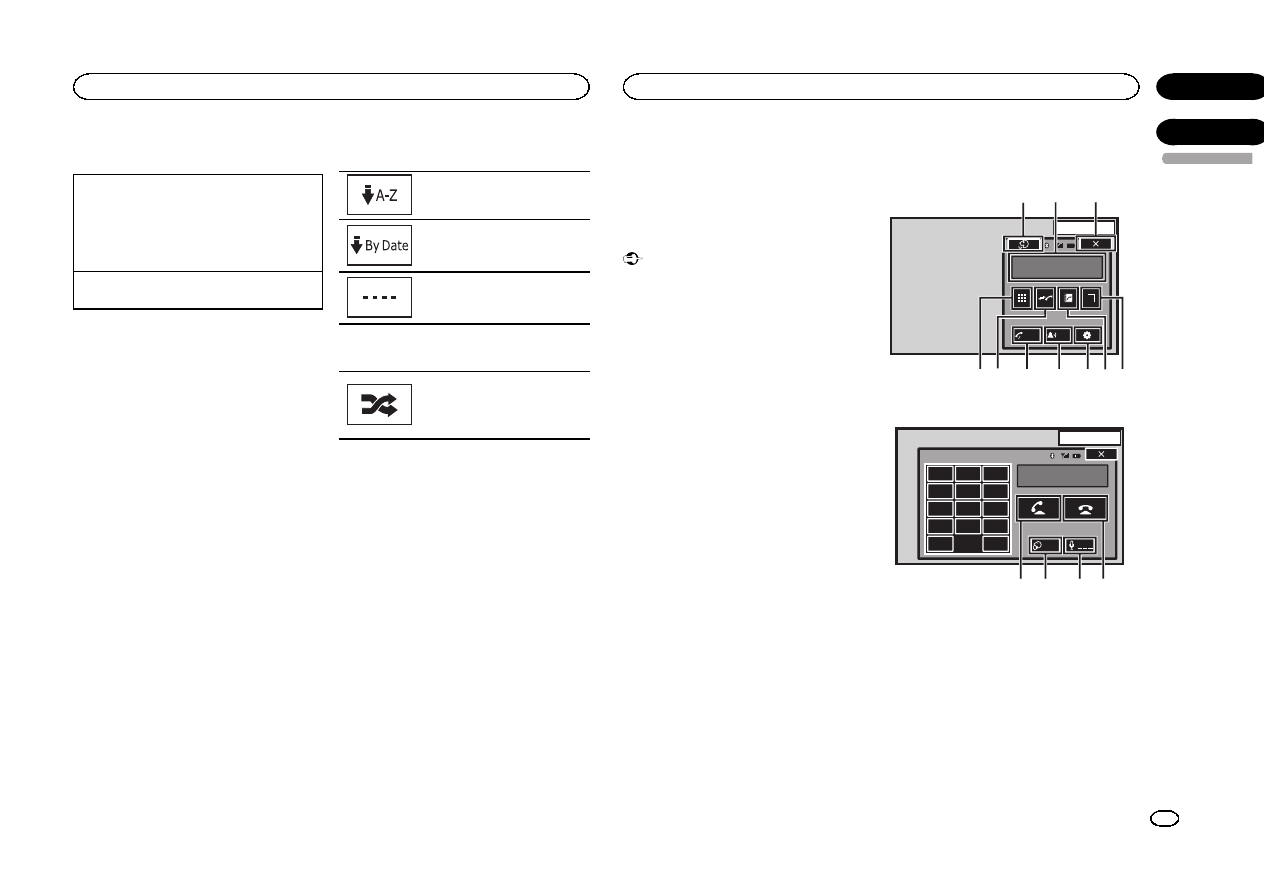
Basic operations
Playing tracks
1Connect an iPod to USB input with a USB
cable using an iPod or iPhone Dock Connec-
tor, or an Android device or BlackBerry device
using Bluetooth.
2Switch the source to Pandora.
Skipping tracks
1Press d(TRK).
Notes
!Touch panel keys not listed under Pandora op-
erations may appear on the display.
Refer to Indicator list on page 57.
!Pandora limits the number of skips allowed
on their service. If you attempt to skip tracks
beyond the limit, "SKIP LIMIT REACHED" is
displayed. If you have reached the skip limit
and you give a "thumbs-down", the current
track will continue to play, but your feedback
will be registered.
Selecting and playing
Pandoraâstations/shuffle
Touch the list for your Pandora stations to select
one of them to play.
1 Display the shuffle/station list.
Refer to Pandora operations on the previous
page.
2 Change the sort order.
You can sort the items in the list
alphabetically.
You can sort the items in the list
in order of the dates on which the
items were created.
You can scroll the titles in the list
while you touch and hold down
the scroll icon.
3 Select shuffle or the desired station.
Shuffle mode will play tracks
from your selected stations. You
an edit shuffle preferences on
your mobile device.
Bluetooth telephone
operations
(Function of AVH-X5500BHS/AVH-X4500BT/AVH-
X3500BHS/AVH-X2500BT)
You can use Bluetooth telephone.
Important
!Leaving the unit on standby to connect to
your phone via Bluetooth while the engine is
not running can drain the battery.
!Advanced operations that require attention
such as dialing numbers on the monitor,
etc., are prohibited while driving. Park your
vehicle in a safe place when using these ad-
vanced operations.
!Bluetooth connection menu cannot be se-
lected while driving.
!Operations available may be limited depend-
ing on the cellular phone connected to this
unit.
!Be sure to park your vehicle in a safe place
and apply the parking brake when perform-
ing this operation.
!If you are unable to complete the connection
using this unit, use the device to connect to
the unit.
!If you connect more than one device at a
time, connected device may not operate
properly. Connecting one device at a time is
recommended.
Touch panel keys
Telephone standby display
13 ARP
PM
12:25
1
Abcdefghi
1234567890123456
Auto
ON
Ton e
OFF
e1
2345678
d
When switching to the entering phone number
mode
13 APR
PM
12:25
1
123
456
789
*0#
C+
Abcdefghi
XXXXXXXXXXXXXXXX
Private
ON
Vol
9abc
1Close key
Display is closed.
2Preset dial key
Displaying the preset dial screen.
3Phone book key
Switching to the phone book mode.
4Setting key
Displaying the Bluetooth connection menu.
English
Using Pandoraâinternet radio
29
Section
HBluetooth telephone
En
15
16
<CRD4703-A/N>29
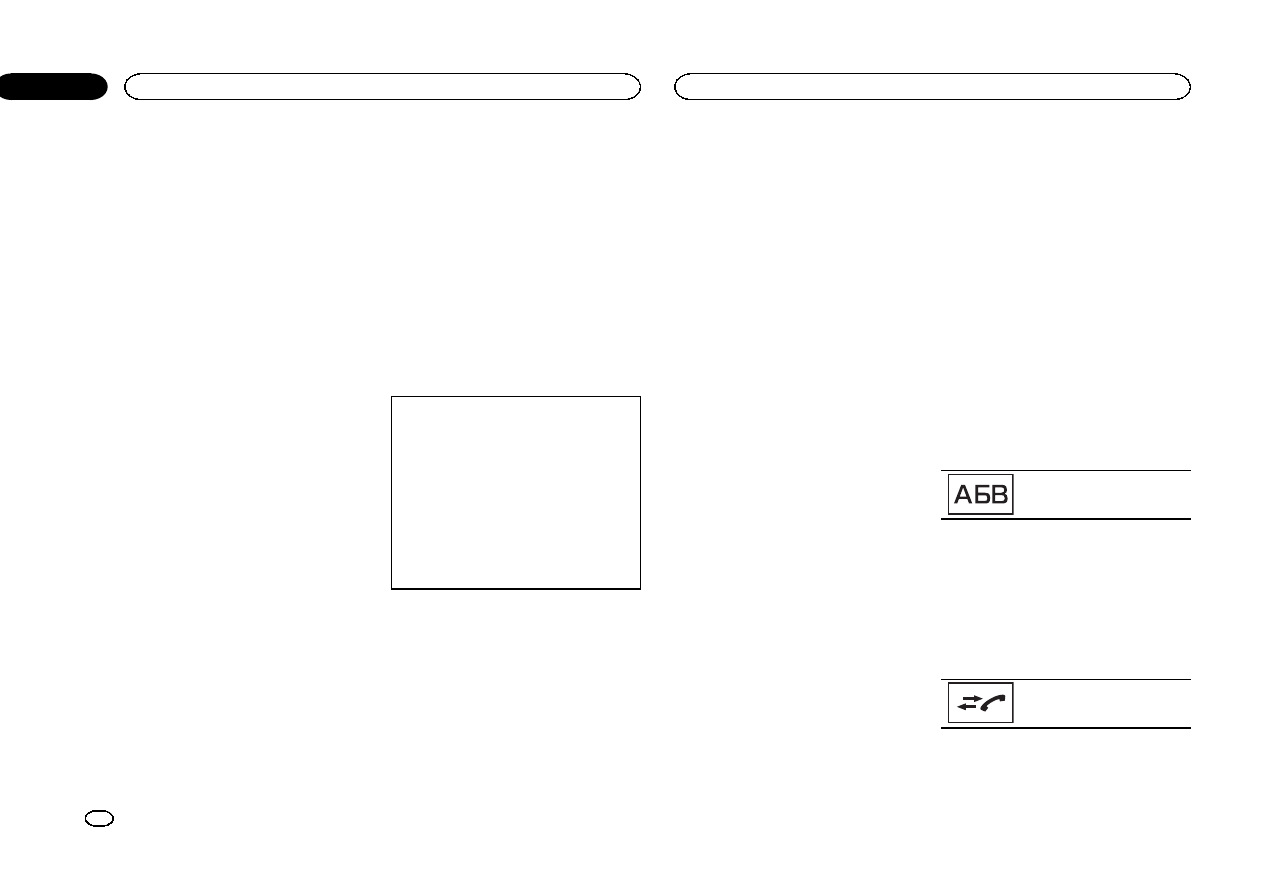
5Tone key
Turning the ring tone for incoming calls on
or off.
6Auto-answer key
Turning automatic answering on or off.
7History key
Switching to the missed, received and dialed
call lists.
8Key pad key
Switching the mode to enter the phone num-
ber directly.
9On-hook key
Ending a call.
Rejecting an incoming call.
Canceling call waiting.
aVolume key
Adjusting the other party’s listening volume.
bPrivate mode key
Turning private mode on or off.
cOff-hook key
Accepting an incoming call.
Making a phone call, when selecting a
phone number.
Switching between callers on hold.
dVoice control key
Notes
!Private mode can only be operated while you
are talking on the phone.
!To end the call, both you and the other caller
must hang up your phones.
!Touch panel keys not listed under Bluetooth
telephone operations may appear on the dis-
play.
Refer to Indicator list on page 57.
Text information
eIncoming call notice
Indicates that an incoming call has been re-
ceived and has not been checked yet.
!Not displayed for calls made when your
cellular phone is disconnected from this
unit.
Setting up for hands-free phoning
Before you can use the hands-free phoning
function you must set up the unit for use with
your cellular phone. This entails establishing a
Bluetooth wireless connection between this unit
and your phone, registering your phone with
this unit, and adjusting the volume level.
1Connection
First, you need to connect a Bluetooth tele-
phone to this unit.
For detailed instructions on connecting your
phone to this unit via Bluetooth wireless tech-
nology, refer to Pairing from this unit on page
42.
2Volume adjustment
Adjust the earpiece volume of your cellular
phone to your preference. The unit will record
the adjusted volume level as the default set-
ting.
Notes
!The volume of the caller’s voice and ring
tone may vary depending on the type of cellu-
lar phone.
!If there is a large volume difference between
the ring tone and caller’s voice, the overall
volume level may become unstable.
!Make sure to adjust the volume to a proper
level before disconnecting the cellular phone
from the unit. If the volume is muted (zero
level) on your cellular phone, the volume
level of your cellular phone remains muted
even after the cellular phone is discon-
nected.
Calling a number in the
phone book
The contacts on your phone will normally be
transferred automatically when the phone is
connected. If it is not, use your phone menu to
transfer the contacts. The visibility of this unit
should be on when you use the phone menu.
Refer to Switching visible unit on page 42.
After finding the number you want to call in the
phone book, you can select the entry and make
the call.
1 Touch the phone book key to switch to
the phone book mode.
2 Select the phone number list.
The detailed phone number list of the selected
entry is displayed.
3 Select the phone number.
#If you want to store the phone number, touch and
hold the list.
4 Touch the off-hook key to make the call.
5 Touch the on-hook key to end the call.
Note
The contacts on your phone will normally be
transferred automatically when the phone is
connected. If it is not, use your phone menu to
transfer the contacts. The visibility of this unit
should be on when you use the phone menu.
Refer to Switching visible unit on page 42.
Selecting a number by
alphabet search mode
If a lot of numbers are registered in the phone
book, you can search for the phone number by
alphabet search mode.
1 Touch the phone book key to switch to
the phone book mode.
2 Touch ABC to switch to alphabet search
mode.
3 Touch the first letter of the entry you are
looking for.
The Phone Book entries starting with that letter
(e.g. “Ben”,“Brian”and “Burt”when “B”is se-
lected) will be displayed.
#If you want to change the character to Russian,
touch the icon. To return to English, touch the icon
again.
Changing the character to Rus-
sian.
#The order of the first name and last name may be
different from that of the cellular phone.
4 Touch the list to display the phone num-
ber list of the selected entry.
#If several phone numbers are included in an
entry, select one by touching the list.
#If you want to switch to the call history list, touch
the icon.
Switching to the call history list.
5 Touch the off-hook key to make the call.
6 Touch the on-hook key to end the call.
HBluetooth telephone
30
Section
HBluetooth telephone
En
16
<CRD4703-A/N>30
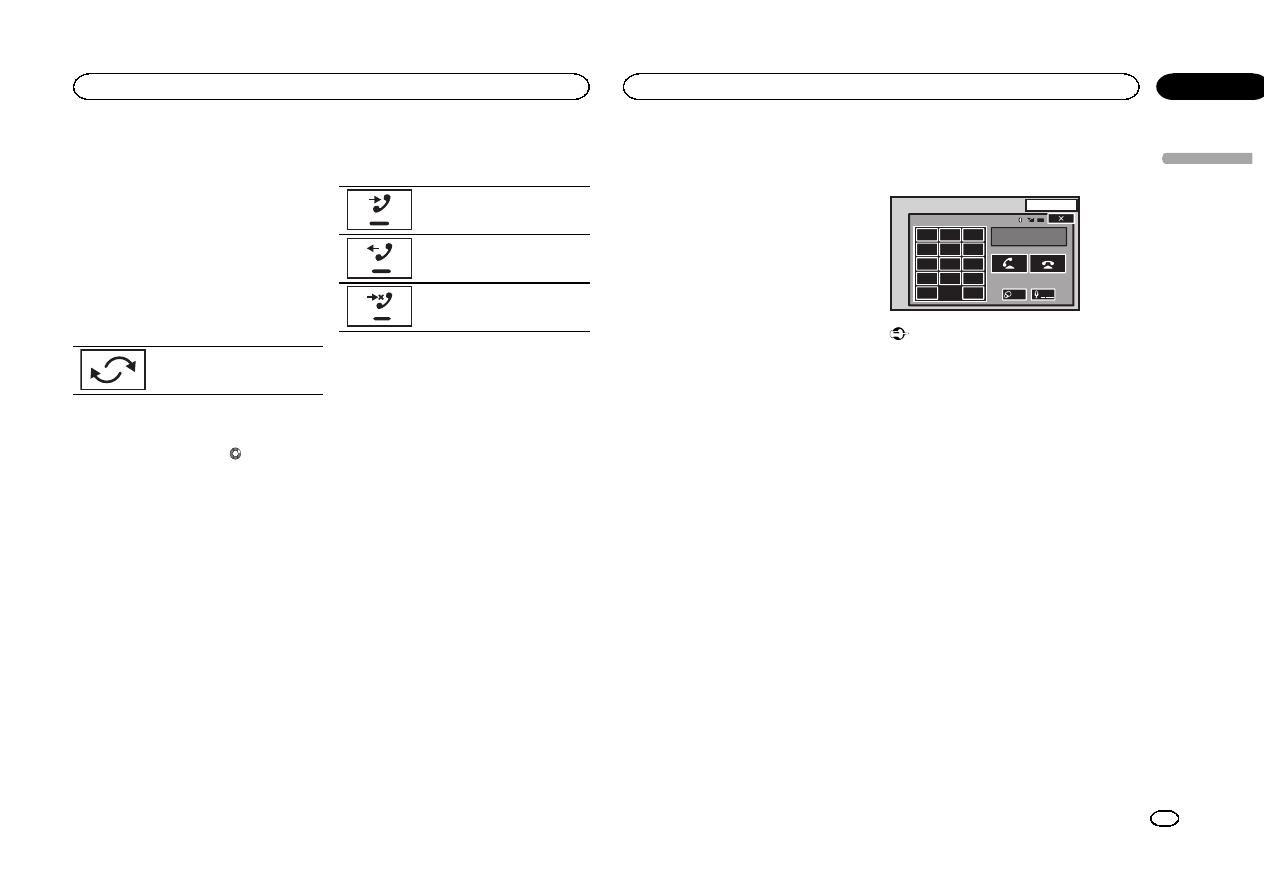
Inverting names in phone book
When your cellular phone is connected to this
unit, the first and last names of your contacts
may be registered to the phone book in reverse
order. You can use this function to change the
order back.
(Inverting the names in the phone book)
1 Touch the phone book key to switch to
the phone book mode.
2 Invert names in phone books.
Inverting names in phone books.
3“Would you like to invert all names?”ap-
pears. Touch Yes to continue.
While the names are inverted, is displayed.
#If the inversion fails, “Invert Name Error”ap-
pears. In such cases, try again from the beginning.
Note
Inverting the names of your contacts from this
unit does not affect the data on your Bluetooth
device.
Using the missed, received
and dialed call lists
The 80 most recent calls dialed, received, and
missed are stored in the memory. You can
browse them and call numbers from these lists.
1 Touch the history key to display the call
history list.
2 Select Missed Calls, Dialed Calls or
Received Calls.
Displaying the received call list.
Displaying the dialed call list.
Displaying the missed call list.
3 Touch the list number to select a phone
number.
Name and phone number are displayed in the
detailed list.
#If you want to store the phone number, touch and
hold the list.
4 Touch the off-hook key to make the call.
5 Touch the on-hook key to end the call.
Setting automatic answering
If this function is on, this unit automatically an-
swers all incoming calls.
%Touch the auto-answer key to turn auto-
matic answering on or off.
Adjusting the other party’s
listening volume
To maintain the good sound quality, this unit
can adjust the other party’s listening volume. If
the volume is not loud enough for the other
party, use this function.
%Touch the volume key to select
Far-End VOL.
1—2—3
#This function can be performed even while talk-
ing on the phone.
#Settings can be stored for each device.
Switching the ring tone
You can select whether or not to use this unit’s
ring tone. If this function is set to on, the ring
tone for this unit will sound.
1 Connect your cellular phone to this unit.
2 Touch the tone key to turn the ring tone
on or off.
Using the preset dial lists
You can easily store up to six phone numbers as
presets.
1 Touch the preset dial key to display the
preset screen.
2 Touch one of the phone numbers to se-
lect.
#If you want to delete a preset phone number,
touch and hold the phone number you wish to de-
lete.
3 Touch the off-hook key to make the call.
4 Touch the on-hook key to end the call.
Making a call by entering
phone number
13 APR
PM
12:25
1
123
456
789
*0#
C+
Abcdefghi
XXXXXXXXXXXXXXXX
Private
ON
Vol
Important
Be sure to park your vehicle in a safe place and
apply the parking brake when performing this
operation.
1 Touch the key pad key to start entering
the phone number.
2 Touch the number icons to input the
numbers.
#Up to 24 digits can be entered.
3 Touch the off-hook key to make the call.
4 Touch the on-hook key to end the call.
Note
Entering phone number mode cannot be oper-
ated unless a Bluetooth telephone is connected
to this unit.
Setting the private mode
During a conversation, you can switch to private
mode (talk directly on your cellular phone).
%Touch the private mode key to turn pri-
vate mode on or off.
English
HBluetooth telephone
31
Section
HBluetooth telephone
En
16
<CRD4703-A/N>31
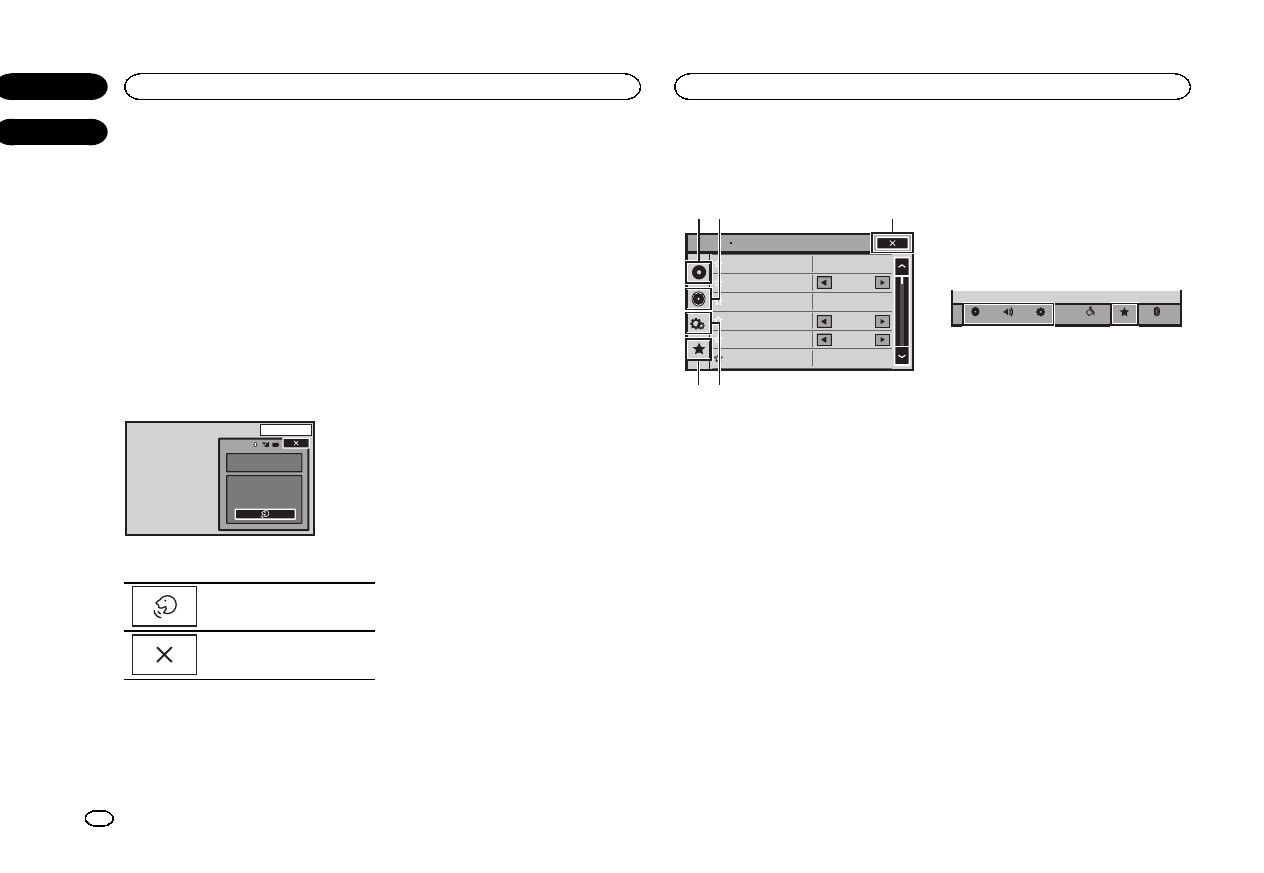
Voice control
If your cellular phone is equipped with the voice
control feature, you can use voice commands to
make calls, for example.
!Operation varies depending on the type of
cellular phone. Refer to the instruction man-
ual that came with your cellular phone for de-
tailed instructions.
!For details on cellular phone models that are
compatible with this feature, refer to the in-
formation on our website.
1 Touch the voice control key.
The display switches to the voice control screen.
You can also switch to the voice control screen
by pressing and holding down the home button
while the source is on.
13 ARP
PM
12:25
1
Voice control
2 Start voice control.
Indicates that continuous calls
can be made uninterrupted.
Indicates that the display is
closed.
Notes
!In order for your voice commands to be rec-
ognized and interpreted correctly, ensure
that conditions are suitable for recognition.
!Please note that wind blowing through the
vehicle windows and noise coming from out-
side the vehicle can interfere with voice com-
mand operation.
!For optimum pick-up, the microphone should
be placed directly in front of the driver at a
suitable distance.
!Speaking too soon after the start of the com-
mand may cause voice recognition to fail.
!Speak slowly, deliberately, and clearly.
Menu operations
Touch panel keys
Sonic Center Control
Loudness
Subwoofer
Bass Booster
High Pass Filter
Source Level Adjuster
L/R 0
Low
0
125Hz
0
On
Audio
1
54
23
1Video setup key
Refer to Setting up the video player on page
35.
2Audio function key
Refer to Audio adjustments on the next page.
3Close key
Returning to the current source display.
4System key
Refer to System settings on page 37.
5Favorite key
You can choose menus within each menu
(Audio function menu, etc.) and register
them to this favorite menu.
Refer to Favorite menu on page 41.
Notes
!You can display the Video Setup menu
when a Disc or USB source is selected.
!If you start the Video Setup menu, playback
is stopped.
!You cannot display the Audio function menu
when the mute function is on or a JPEG file
is playing.
1 Press the home button to switch to the
home display.
2 Touch any of the following touch panel
keys to select the menu to be adjusted.
BluetoothFavoriteThemeSystem
Settings
AudioVideo
HBluetooth telephone
32
Section
Settings
En
16
17
<CRD4703-A/N>32
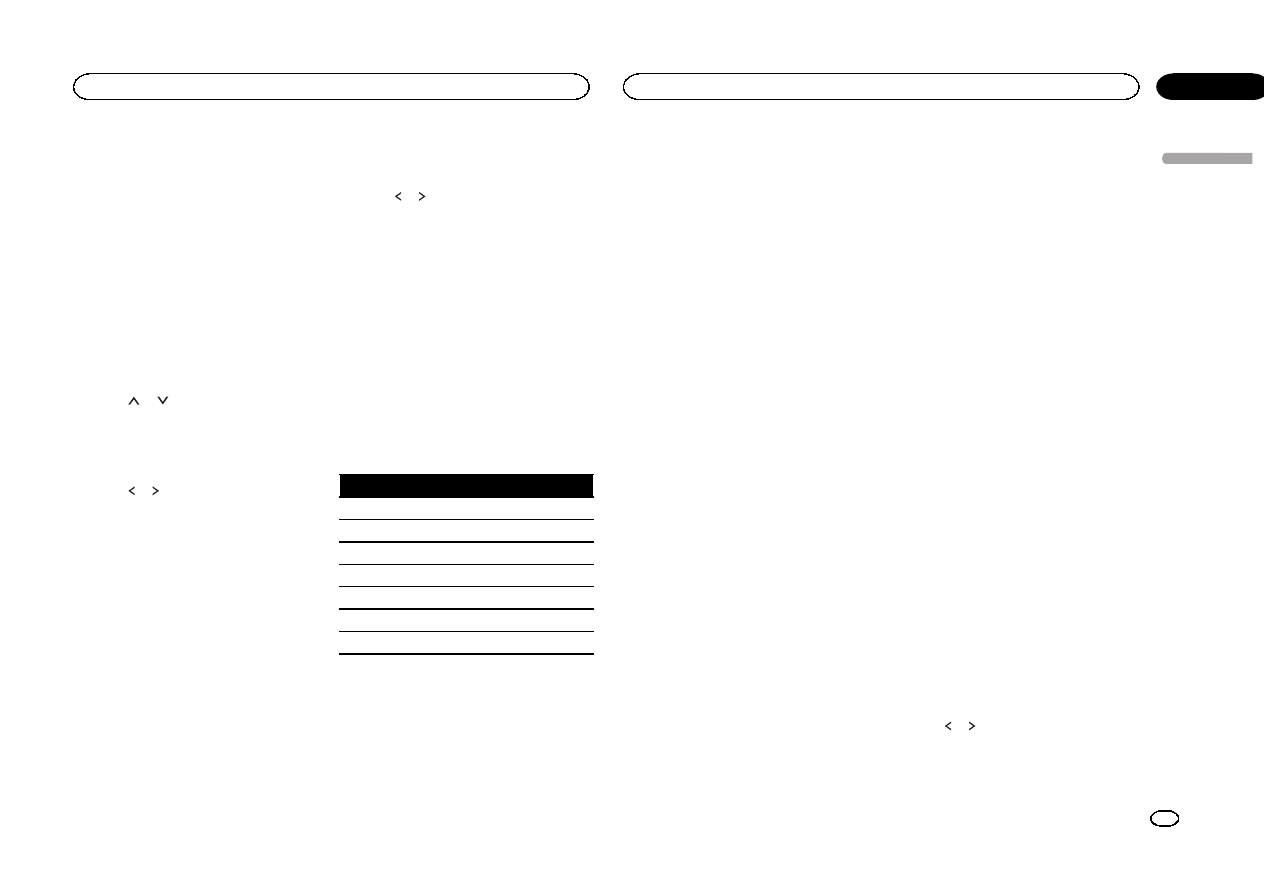
Using fader/balance adjustment
Fader/Balance displays when Rear Speaker is
set to Full on the System Menu.
You can change the fader/balance setting to pro-
vide an ideal listening environment for all of the
occupied seats.
1 Press the home button to switch to the
home display.
2 Touch the audio function key to open the
audio menu.
3 Touch Fader/Balance on the audio func-
tion menu.
4 Touch or to adjust the front/rear
speaker balance.
Range: Front 15 to Rear 15
#Select F/R 0 L/R 0 when only using two speak-
ers.
5 Touch or to adjust the left/right
speaker balance.
Range: Left 15 to Right 15
Note
You can also set the fader/balance by dragging
the dot on the displayed table.
Using balance adjustment
Balance displays when Rear Speaker is set to
Subwoofer on the System Menu. This setting
will allow you to adjust the balance between
right/left sound output.
1 Press the home button to switch to the
home display.
2 Touch the audio function key to open the
audio menu.
3 Touch Balance on the audio function
menu.
4 Touch or to adjust the left/right
speaker balance.
Range: Left 15 to Right 15
Note
You can also set the balance by dragging the dot
on the displayed table.
Using the equalizer
You can adjust the equalization to match the
car’s interior acoustic characteristics as de-
sired.
Recalling equalizer curves
There are seven stored equalizer curves which
you can easily recall at any time. Here is a list of
the equalizer curves.
Display Equalizer curve
S.Bass Super bass
Powerful Powerful
Natural Natural
Vocal Vocal
Flat Flat
Custom1 Custom 1
Custom2 Custom 2
!The equalizer curves for Custom1 and
Custom2 can be adjusted.
!You cannot select Custom1 and Custom2
when using the auto-equalizer.
!When Flat, no changes are made to the
sound. You can check the effects of the
equalizer curves by switching alternatively
between Flat and another equalizer curve.
1 Press the home button to switch to the
home display.
2 Touch the audio function key to open the
audio menu.
3 Touch Graphic EQ on the audio function
menu.
#You cannot select or adjust the equalizer curves
of Custom1 and Custom2 when using the auto-
equalizer.
4 Touch the desired setting.
S.Bass—Powerful—Natural—Vocal—Flat—
Custom1—Custom2
Adjusting the 8-band graphic
equalizer
You can adjust the level of each band for the
equalizer curves.
!A separate Custom1 curve can be created
for each source. If you make adjustments
when a curve other than Custom2 is se-
lected, the equalizer curve settings will be
stored in Custom1.
!ACustom2 curve that is common for all
sources can be created. If you make adjust-
ments when the Custom2 curve is selected,
the Custom2 curve will be updated.
1 Press the home button to switch to the
home display.
2 Touch the audio function key to open the
audio menu.
3 Touch Graphic EQ on the audio function
menu.
4 Touch the desired setting.
S.Bass—Powerful—Natural—Vocal—Flat—
Custom1—Custom2
5 Touch the table to adjust the level of the
equalizer band.
Range: +12dB to –12dB
Using the auto-equalizer
The auto-equalizer is an equalizer curve created
by auto EQ (refer to Auto EQ (auto-equalizing) on
page 40).
You can turn the auto-equalizer on or off.
If you connect an optional microphone to this
unit, you can use this function.
1 Press the home button to switch to the
home display.
2 Touch the audio function key to open the
audio menu.
3 Touch Auto EQ to turn the auto-equalizer
on or off.
#You cannot use this function if auto EQ has not
been carried out.
Using sonic center control
Sound that is suited for the listening position
can easily be created with this function.
1 Press the home button to switch to the
home display.
2 Touch the audio function key to open the
audio menu.
3 Touch Sonic Center Control on the audio
function menu.
4 Touch or to select a listening position.
Range: Left 7 to Right 7
English
Audio adjustments
33
Section
Audio adjustments
En
18
<CRD4703-A/N>33

Adjusting loudness
Loudness compensates for deficiencies in the
low-frequency and high-frequency ranges at low
volume.
1 Press the home button to switch to the
home display.
2 Touch the audio function key to open the
audio menu.
3 Touch cor dto select a desired level for
loudness.
Off (off)—Low (low)—Mid (mid)—High (high)
Using subwoofer output
This unit is equipped with a subwoofer output
which can be turned on or off.
!The cut-off frequency and output level can be
adjusted when the subwoofer output is on.
1 Press the home button to switch to the
home display.
2 Touch the audio function key to open the
audio menu.
3 Touch Subwoofer on the audio function
menu.
4 Touch On or Off next to Subwoofer to
turn the subwoofer output on or off.
5 Touch Normal or Reverse next to Phase
to select the phase of subwoofer output.
6 Touch cor dnext to Level to adjust the
output level of the subwoofer.
Range: +6 to –24
7 Touch cor dnext to Frequency to select
the cut-off frequency.
50Hz—63Hz—80Hz—100Hz—125Hz
Only frequencies lower than those in the se-
lected range are outputted from the subwoofer.
Boosting the bass
You can boost the bass level.
1 Press the home button to switch to the
home display.
2 Touch the audio function key to open the
audio menu.
3 Touch cor dto select a desired level.
Range: 0to +6
Using the high pass filter
When you do not want low sounds from the sub-
woofer output frequency range to play from the
front or rear speakers, turn on the HPF (high
pass filter). Only frequencies higher than those
in the selected range are output from the front
or rear speakers.
1 Press the home button to switch to the
home display.
2 Touch the audio function key to open the
audio menu.
3 Touch cor dnext to the frequency to se-
lect cut-off frequency.
Off (off)—50Hz—63Hz—80Hz—100Hz—
125Hz
Only frequencies higher than those in the se-
lected range are output from the front or rear
speakers.
Adjusting source levels
With SLA (source level adjustment), the volume
levels of each source can be adjusted to prevent
significant differences between sources.
!Settings are based on the FM volume level,
which remains unchanged.
1 Press the home button to switch to the
home display.
2 Touch the audio function key to open the
audio menu.
3 Compare the FM volume level with the
level of the source you wish to adjust.
4 Touch Source Level Adjuster on the audio
function menu.
5 Touch or to adjust the source vol-
ume.
Range: +4 to –4
Notes
!Source Level Adjuster is not available when
FM is selected as the source.
!The AM volume level can also be adjusted
with this function.
!Video CD, CD, compressed audio, DivX,
MPEG-1, MPEG-2 and MPEG-4 are automati-
cally set to the same source level adjustment
volume.
Audio adjustments
34
Section
Audio adjustments
En
18
<CRD4703-A/N>34
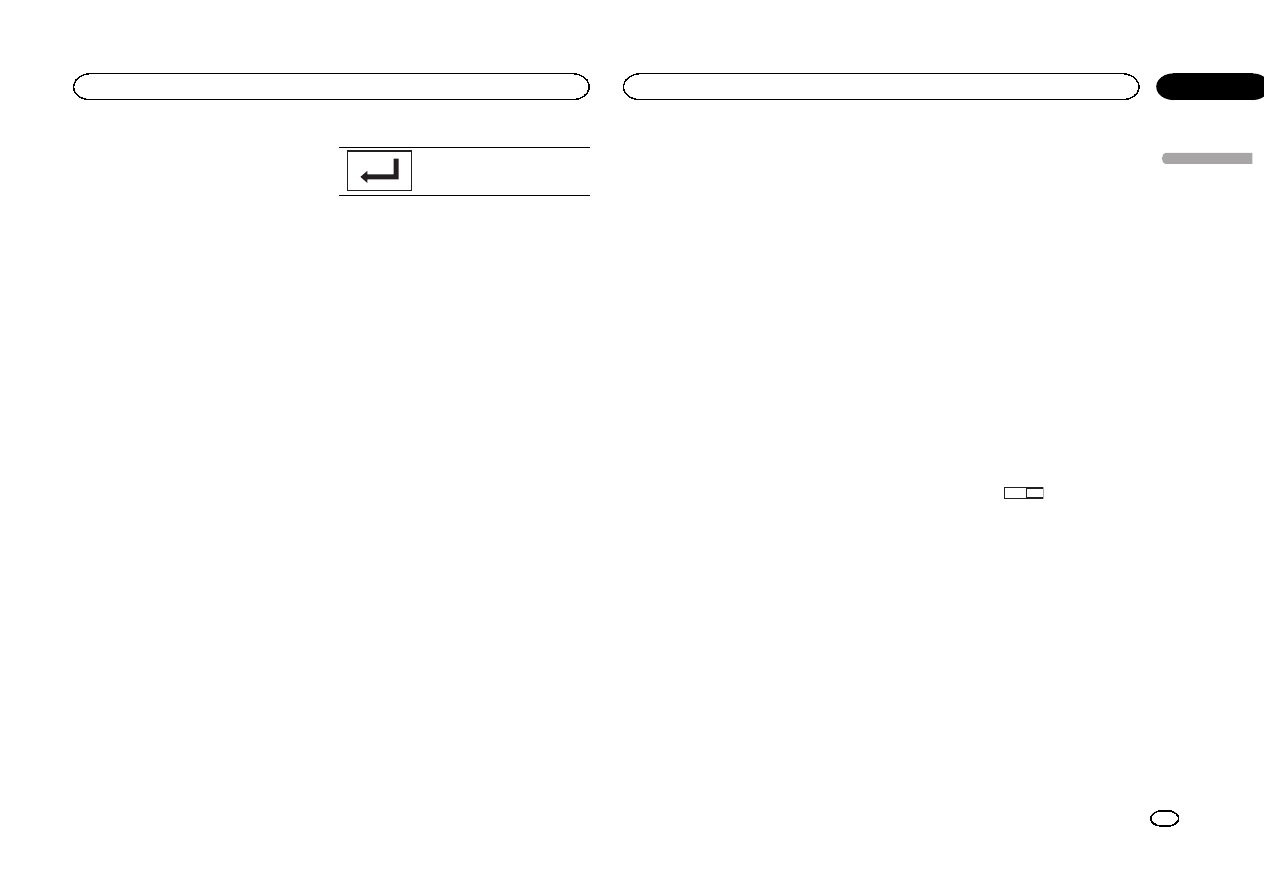
Setting the subtitle language
You can set a desired subtitle language. When
available, the subtitles will be displayed in the
selected language.
1 Press the home button to switch to the
home display.
2 Touch the video setup key to open the
video setup menu.
3 Touch Subtitle Language on the
Video Setup menu.
A subtitle language menu is displayed.
4 Touch the desired language.
The subtitle language is set.
#If you have selected Others, refer to When you se-
lect Others on this page.
Notes
!If the selected language is not available, the
language specified on the disc is displayed.
!You can also switch the subtitle language by
touching the switch subtitle languages key
during playback.
!The setting made here will not be affected
even if the subtitle language is switched dur-
ing playback using the switch subtitle lan-
guages key.
When you select Others
A language code input display is shown when
Others is selected. Refer to Language code chart
for DVD on page 64.
%Touch 0 to 9 to input the language code.
#To cancel the entered numbers, touch C.
#To register the code, touch the following touch
panel key.
Registering the code.
Setting the audio language
You can set the preferred audio language.
1 Press the home button to switch to the
home display.
2 Touch the video setup key to open the
video setup menu.
3 Touch Audio Language on the Video
Setup menu.
An audio language menu is displayed.
4 Touch the desired language.
The audio language is set.
#If you have selected Others, refer to When you se-
lect Others on this page.
Notes
!If the selected language is not available, the
language specified on the disc is used.
!You can also switch the audio language by
touching the switch audio languages key
during playback.
!The setting made here will not be affected
even if the audio language is switched dur-
ing playback using the switch audio lan-
guages key.
Setting the menu language
You can set the preferred language in which the
menus recorded on a disc are displayed.
1 Press the home button to switch to the
home display.
2 Touch the video setup key to open the
video setup menu.
3 Touch Menu Language on the
Video Setup menu.
A menu language menu is displayed.
4 Touch the desired language.
The menu language is set.
#If you have selected Others, refer to When you se-
lect Others on this page.
Note
If the selected language is not available, the lan-
guage specified on the disc is displayed.
Setting the multi-angle DVD
display
The angle icon can be set so it appears on
scenes where the angle can be switched.
1 Press the home button to switch to the
home display.
2 Touch the video setup key to open the
video setup menu.
3 Touch Multi Angle on the Video Setup
menu to turn angle icon display on or off.
Setting the aspect ratio
There are two kinds of display: a wide screen dis-
play that has a width-to-height ratio (TV aspect
ratio) of 16:9, and regular display that has a TV
aspect of 4:3. Be sure to select the correct TV as-
pect for the display connected to V OUT.
!When using regular display, select either
Letter Box or Pan Scan. Selecting 16:9 may
result in an unnatural picture.
!If you select the TV aspect ratio, the unit’s
display will change to the same setting.
1 Press the home button to switch to the
home display.
2 Touch the video setup key to open the
video setup menu.
3 Touch TV Aspect on the Video Setup
menu to select the TV aspect ratio.
Touch TV Aspect repeatedly until the desired as-
pect ratio appears.
!16:9 –Wide screen picture (16:9) is displayed
as is (initial setting)
!Letter Box –The picture is the shape of a let-
terbox with black bands on the top and bot-
tom of the screen
!Pan Scan –The picture is cut short on the
right and left sides of the screen
Notes
!When playing discs that do not specify
Pan Scan, the disc is played back in
Letter Box display even if you select the
Pan Scan setting. Confirm whether the disc
package bears the 16 : 9 LB mark.
!The TV aspect ratio cannot be changed for
some discs. For details, refer to the disc’s in-
structions.
Setting the slideshow interval
JPEG files can be viewed as a slideshow on this
unit. In this setting, the interval between each
image can be set.
1 Press the home button to switch to the
home display.
2 Touch the video setup key to open the
video setup menu.
English
Setting up the video player
35
Section
Setting up the video player
En
19
<CRD4703-A/N>35
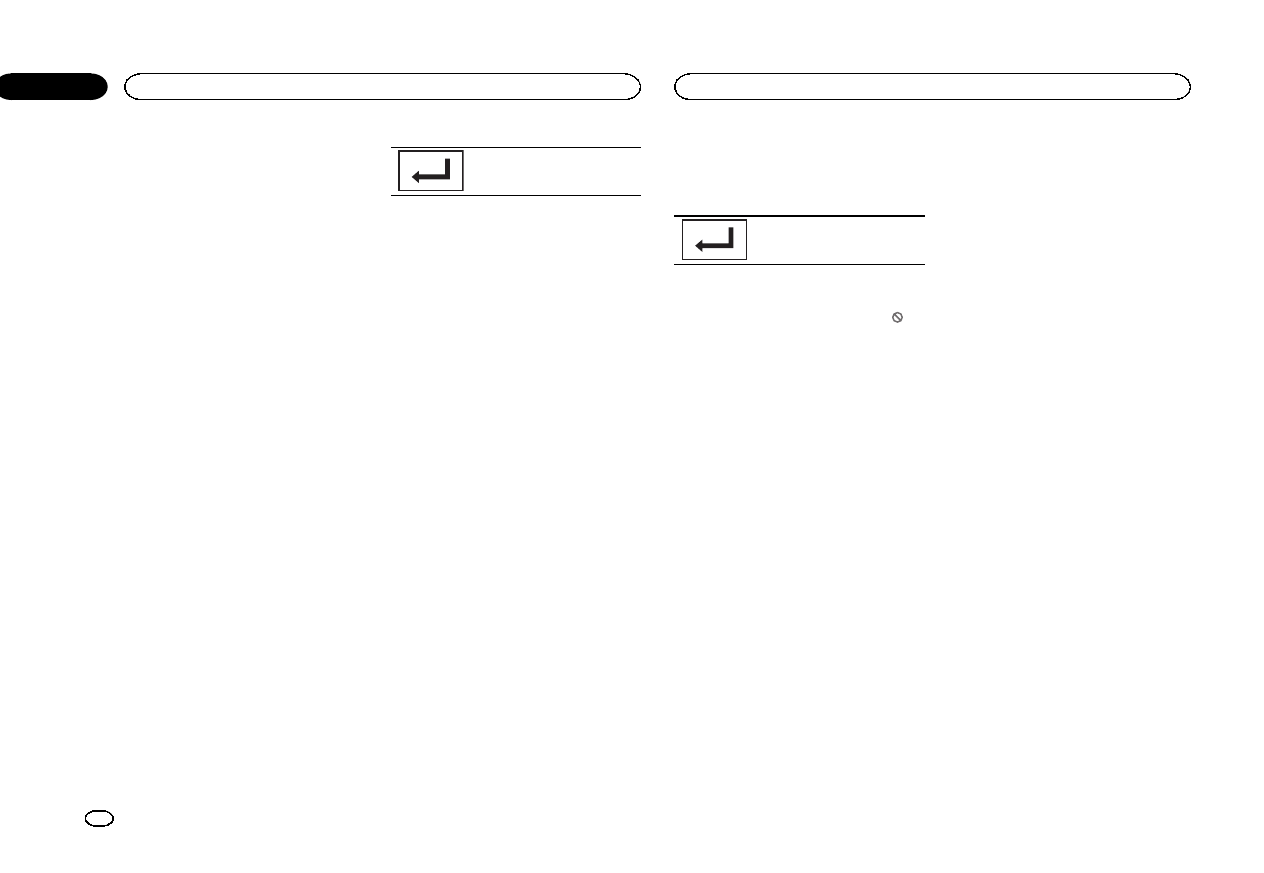
3 Touch Time Per Photo Slide on the
Video Setup menu to select the slideshow in-
terval.
Touch Time Per Photo Slide repeatedly until the
desired setting appears.
!5sec –JPEG images switch at intervals of 5
seconds
!10sec –JPEG images switch at intervals of 10
seconds
!15sec –JPEG images switch at intervals of 15
seconds
!Manual –JPEG images can be switched
manually
Setting parental lock
Some DVD video discs let you use parental lock
to restrict children from viewing violent and
adult-oriented scenes. You can set parental lock
to the desired level.
!When you have a parental lock level set and
play a disc featuring parental lock, code
number input indications may be displayed.
In such cases, playback will begin when the
correct code number is entered.
Setting the code number and level
A code number must be registered in order to
play back discs with parental lock.
1 Press the home button to switch to the
home display.
2 Touch the video setup key to open the
video setup menu.
3 Touch Parental on the Video Setup menu.
4 Touch 0 to 9 to input a four digit code
number.
#To cancel the entered numbers, touch C.
#To register the code, touch the following touch
panel key.
Registering the code.
The code number is set, and the level can now be
set.
5 Touch 1 to 8 to select the desired level.
6 Touch Enter.
The parental lock level is set.
!8–Playback of the entire disc is possible (ini-
tial setting)
!7to 2–Playback of discs for children and
non-adult-oriented discs is possible
!1–Playback of discs for children only is pos-
sible
Notes
!We recommend to keep a record of your
code number in case you forget it.
!The parental lock level is stored on the disc.
Look for the level indication written on the
disc package, included literature or on the
disc itself. Parental lock of this unit is not
possible if a parental lock level is not stored
on the disc.
!With some discs, the parental lock may be
active only for certain levels of scenes. The
playback of those scenes will be skipped. For
details, refer to the instruction manual that
came with the disc.
Changing the level
You can change the set parental lock level.
1 Press the home button to switch to the
home display.
2 Touch the video setup key to open the
video setup menu.
3 Touch Parental on the Video Setup menu.
4 Touch 0 to 9 to input the registered code
number.
5 Registering the code.
Registering the code.
This sets the code number, and the level can
now be changed.
#If you enter an incorrect code number, the
icon is displayed. Touch Cand enter the correct code
number.
#If you forget your code number, refer to If you for-
get your code number on this page.
6 Touch 1 to 8 to select the desired level.
7 Touch Enter.
The new parental lock level is set.
If you forget your code number
%Press RESET.
Setting the DivX subtitle file
You can select whether or not to display DivX ex-
ternal subtitles.
!The DivX subtitles will be displayed even
when Custom is selected if no DivX external
subtitle files exist.
1 Press the home button to switch to the
home display.
2 Touch the video setup key to open the
video setup menu.
3 Touch DivX® Subtitle on the Video Setup
menu to select the desired subtitle setting.
!Original –Display the DivX subtitles
!Custom –Display the DivX external subtitles
Notes
!Up to 42 characters can be displayed on one
line. If more than 42 characters are set, the
line breaks and the characters are displayed
on the next line.
!Up to 126 characters can be displayed on
one screen. If more than 126 characters are
set, the excess characters will not be dis-
played.
Displaying the DivXâVOD
registration code
In order to play DivX VOD (video on demand)
contents on this unit, the unit must first be reg-
istered with a DivX VOD contents provider. For
registration, generate a DivX VOD registration
code and submit it to your provider.
!Keep a record of the code as you will need it
when you register your unit to the DivX VOD
provider.
1 Press the home button to switch to the
home display.
2 Touch the video setup key to open the
video setup menu.
3 Touch DivX® VOD on the Video Setup
menu.
Registration Code and Deregistration Code
appear.
4 Touch Registration Code.
Your registration code is displayed.
Displaying the deregistration code
If your device is already registered, deregister it
by entering the deregistration code.
1 Press the home button to switch to the
home display.
Setting up the video player
36
Section
Setting up the video player
En
19
<CRD4703-A/N>36
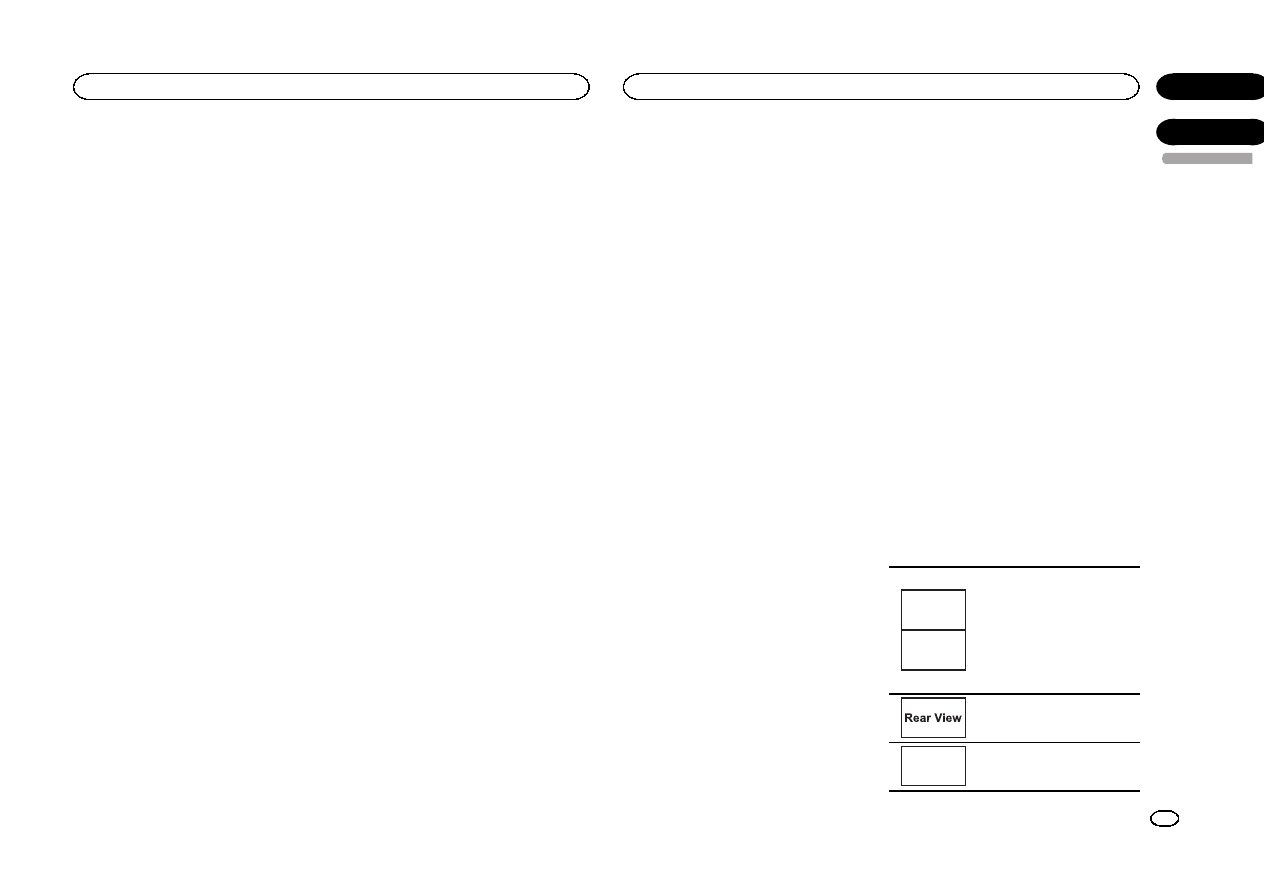
2 Touch the video setup key to open the
video setup menu.
3 Touch DivX® VOD on the Video Setup
menu.
4 Touch Deregistration Code.
#To cancel deregistration, touch Cancel.
5 Touch OK.
The deregistration is complete.
Automatic playback of DVDs
When a DVD disc with a DVD menu is inserted,
this unit will cancel the menu automatically and
start playback from the first chapter of the first
title.
!Some DVDs may not operate properly. If this
function is not fully operated, turn this func-
tion off and start playback.
1 Press the home button to switch to the
home display.
2 Touch the video setup key to open the
video setup menu.
3 Touch DVD Auto Play to turn automatic
playback on.
#To turn automatic playback off, touch
DVD Auto Play again.
Switching the auxiliary setting
Activate this setting when using an auxiliary de-
vice connected to this unit.
1 Press the home button to switch to the
home display.
2 Touch the system key to open the system
menu.
3 Touch AUX Input on the system menu to
turn AUX Input on or off.
Setting AV input
Activate this setting when using an external
video component connected to this unit.
1 Press the home button to switch to the
home display.
2 Touch the system key to open the system
menu.
3 Touch AV Input on the system menu to
turn AV Input on or off.
Setting the RGB Input
You can switch the setting of RGB input.
1 Press the home button to switch to the
home display.
2 Touch the system key to open the system
menu.
3 Touch RGB Input on the system menu to
turn iPhone or NAVI.
Note
If you use Advanced App Mode, set to iPhone.
Setting the App sound mixing
Refer to Setting the App sound mixing on page
23.
Setting MIXTRAX mode
Refer to Setting MIXTRAX mode on page 27.
Changing the picture
adjustment
You can adjust the Brightness (brightness),
Contrast (contrast), Color (color) , Hue (hue),
Dimmer (dimmer), and Temperature (tempera-
ture) for each source and rear view camera.
!You cannot adjust Color,Hue and Contrast
for the audio source.
1 Press the home button to switch to the
home display.
2 Touch the system key to open the system
menu.
3 If you are adjusting the
Picture Adjustment, select the unit.
NAVI
Apps
Completing Picture Adjust-
ment for the Navigation system
when the RGB input setting is
set to NAVI.
Completing Picture Adjust-
ment for the Advanced App
Mode when the RGB input set-
ting is set to iPhone.
Adjusting the Picture Adjust-
ment for the rear view camera.
Source Adjusting the Picture Adjust-
ment for the source.
English
Setting up the video player
37
Section
System settings
En
19
20
<CRD4703-A/N>37

4 Touch any of the following touch panel
keys to select the function to be adjusted.
Picture Adjustment items are displayed.
!Brightness –Adjusts the black intensity
!Contrast –Adjusts the contrast
!Color –Adjusts the color saturation
!Hue –Adjusts the tone of color (red or green
is emphasized)
!Dimmer –Adjusts the brightness of the dis-
play
!Temperature –Adjusts the color tempera-
ture, resulting in a better white balance
#You can adjust Hue only when the color system
is set to NTSC.
#With some rear view cameras, picture adjust-
ment may not be possible.
5 Touch cor dto adjust the selected item.
Each time you touch cor d, the level of the se-
lected item increases or decreases.
#Dimmer can be adjusted from +1 to +48.
#Temperature can be adjusted from +3 to –3.
Notes
!You cannot operate this function while driv-
ing.
!Different Brightness/Contrast/Dimmer set-
tings can be set for when the illumination
switch is on and when it is off.
Selecting the system language
The system language can be selected.
If text information such as the title name, artist
name or a comment is embedded in a European
language, they can also be displayed on this
unit.
!The language can be changed for the follow-
ing:
—Audio menu
—System menu
—Video Setup menu
—Bluetooth menu
—On-screen display
(English and Russian only)
—Multi language setting for DivX
(English and Russian only)
—Language for cautions
Some operations on this unit are prohib-
ited from use while driving or require
careful attention when operated. In such
cases, a caution will appear on the dis-
play. You can change the language for
caution messages with this setting.
!If the embedded language and the selected
language setting are not the same, text infor-
mation may not display properly.
!Some characters may not be displayed prop-
erly.
1 Press the home button to switch to the
home display.
2 Touch the system key to open the system
menu.
3 Touch System Language on the system
menu to select the desired language.
4 Touch the desired language.
English (English)—Français (French)—Español
(Spanish)—Portuguese (Portuguese)—中文
(Simplified Chinese)
Setting SiriusXM Tune Startä
Refer to Setting SiriusXM Tune Startäon page
16.
Setting Demo Mode
Once Demo Mode is turned on, the Demo
screen appears.
Refer to Demo mode on page 6.
1 Press the home button to switch to the
home display.
2 Touch the system key to open the system
menu.
3 Touch Demo mode on the system menu
to turn Demo mode on or off.
!On –The Demo screen appears.
!Off –The Demo screen does not appear.
Switching sound muting/
attenuation
Sound from this system is automatically muted
or attenuated when a signal from equipment
with a mute function is received.
!Sound from this system returns to normal
when the muting or attenuation is canceled.
1 Press the home button to switch to the
home display.
2 Touch the system key to open the system
menu.
3 Touch Mute/ATT until the desired setting
appears.
Touch Mute/ATT until the desired setting ap-
pears in the display.
!Mute –Muting
!ATT –20dB –Attenuation (ATT –20dB has a
stronger effect than ATT –10dB)
!ATT –10dB –Attenuation
!Off –Turns the sound muting/attenuation off
Notes
!When Mute is displayed, the sound is turned
off and no audio adjustments can be made.
!When ATT is displayed, the sound is attenu-
ated and only the volume can be adjusted.
(No other audio adjustments can be made.)
!Operation returns to normal when the phone
connection is ended.
Setting the rear output and
subwoofer controller
This unit’s rear output (rear speaker leads out-
put and RCA rear output) can be used for full-
range speaker (Full) or subwoofer (Subwoofer)
connection. If you switch the rear output setting
to Subwoofer, you can connect a rear speaker
lead directly to a subwoofer without using an
auxiliary amp.
Initially, the unit is set for a rear full-range speak-
er connection (Full).
1 Turn the source off.
Refer to Turning the source ON/OFF on page 8.
2 Press the home button to switch to the
home display.
3 Touch the system key to open the system
menu.
4 Touch Rear Speaker on the system menu
to switch the subwoofer output or full-range
speaker.
#When no subwoofer is connected to the rear out-
put, select Full (full-range speaker).
#When a subwoofer is connected to the rear out-
put, select Subwoofer (subwoofer).
Notes
!Even if you change this setting, there will be
no output unless you turn the subwoofer out-
put on (refer to Using subwoofer output on
page 34).
!Both rear speaker lead outputs and RCA rear
output are switched simultaneously in this
setting.
Using the keyboard
Keyboard is available only in Advanced App
Mode.
Refer to Setting the Keyboard on page 23.
System settings
38
Section
System settings
En
20
<CRD4703-A/N>38
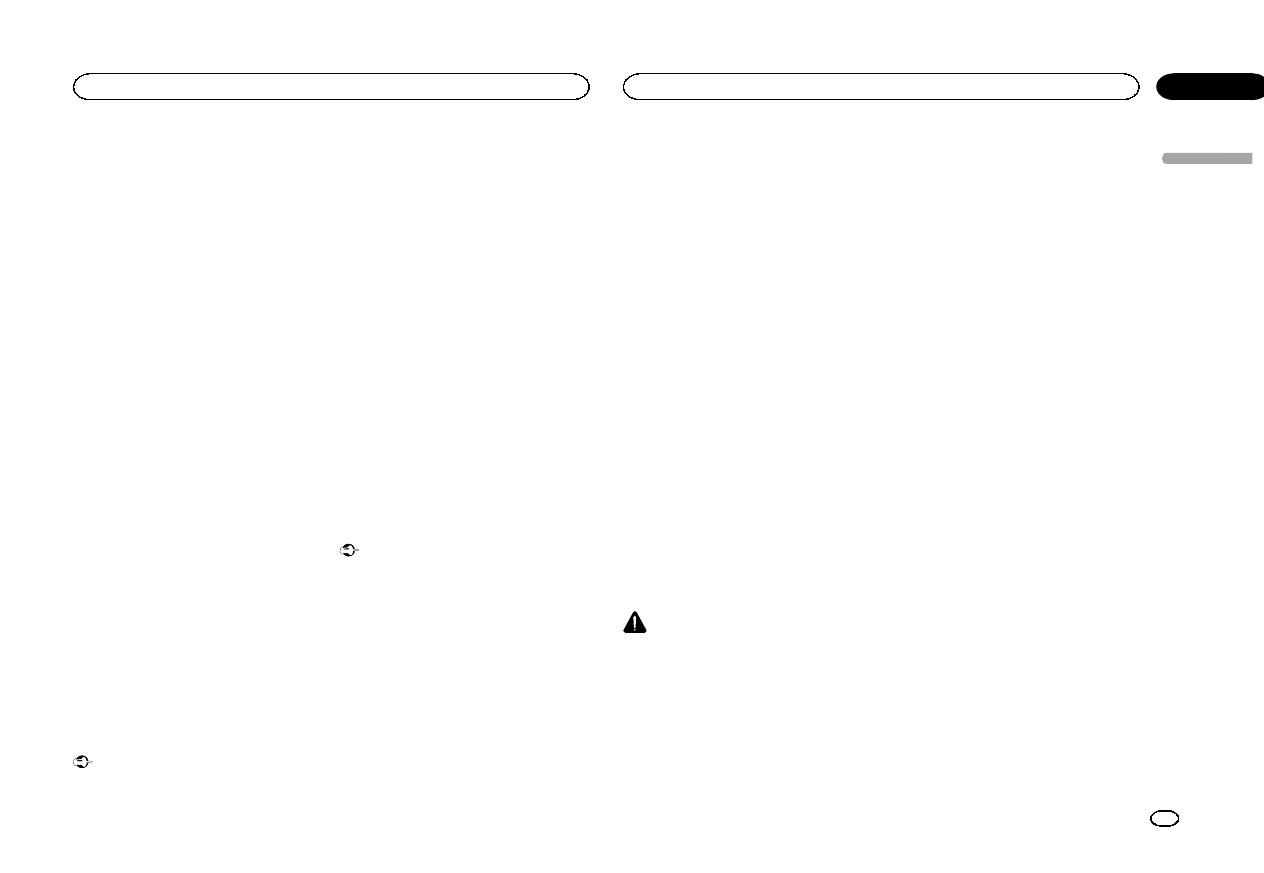
Setting the ever scroll
When ever scroll is set to On, recorded text infor-
mation scrolls continuously in the display. Set to
Off if you prefer the information to scroll just
once.
1 Press the home button to switch to the
home display.
2 Touch the system key to open the system
menu.
3 Touch Ever Scroll on the system menu to
turn ever scroll on or off.
Setting the Pandora connect
mode
Refer to Setting the Pandora connect mode on
page 28.
Setting the Bluetooth audio
(Function of AVH-X5500BHS/AVH-X4500BT/AVH-
X3500BHS/AVH-X2500BT)
You need to activate the Bluetooth Audio
source in order to use a Bluetooth audio player.
1 Press the home button to switch to the
home display.
2 Touch the system key to open the system
menu.
3 Touch Bluetooth Audio on the system
menu to turn Bluetooth audio on or off.
Clearing Bluetooth memory
Important
Never turn the unit off while the Bluetooth mem-
ory is being cleared.
1 Turn the source off.
Refer to Turning the source ON/OFF on page 8.
2 Press the home button to switch to the
home display.
3 Touch the system key to open the system
menu.
4 Touch Bluetooth Memory Clear on the
system menu.
5 Touch Clear.
After selecting a desired item, a confirmation
display appears. Touch OK to delete the memo-
ry.
#If you do not want to clear the memory, touch
Cancel.
Updating Bluetooth
connection software
This function is used to update this unit with the
latest Bluetooth software. For about Bluetooth
software and updating, refer to our website.
Important
Never turn the unit off and never disconnect the
phone while the software is being updated.
1 Turn the source off.
Refer to Turning the source ON/OFF on page 8.
2 Press the home button to switch to the
home display.
3 Touch the system key to open the system
menu.
4 Touch BT Software Update.
5 Touch Start to display the data transfer
mode.
#Follow the on-screen instructions to finish updat-
ing the Bluetooth software.
Displaying the Bluetooth
system version
If this unit fails to operate properly, you may
need to consult your dealer for repair. In such
cases, you may be asked to specify the system
version. Perform the following procedure to
check the version on this unit.
1 Turn the source off.
Refer to Turning the source ON/OFF on page 8.
2 Press the home button to switch to the
home display.
3 Touch the system key to open the system
menu.
4 Touch Bluetooth Version Information to
display to the version of the Bluetooth mod-
ule of this unit.
Setting the rear view
camera (back up camera)
CAUTION
Pioneer recommends the use of a camera
which outputs mirror-reversed images. Oth-
erwise, the screen image will appear re-
versed.
This unit features a function that automatically
switches to the rear view camera video (R.C IN)
when a rear view camera is installed on your car
and the shift lever is moved to the REVERSE
(R) position. (For more details, consult your
dealer.)
You can also switch the rear view image by
pressing the touch key.
For details refer to Using the rear view on page
10.
!After you set up the rear view camera setting,
move the shift lever to REVERSE (R) and
confirm that the rear view camera video is
shown on the display.
!Change this setting if the display switches to
the rear view camera video by error while you
are driving forward.
!To stop watching the rear view camera video
and return to the source display, press and
hold MUTE.
!Touch the RearView source icon to display
the rear view camera image while driving.
Touch the source icon again to turn the rear
view camera off. For details, refer to Selecting
a source on page 8.
1 Press the home button to switch to the
home display.
2 Touch the system key to open the system
menu.
3 Touch Camera Polarity on the system
menu to select the appropriate setting.
!Battery –When the polarity of the connected
lead is positive while the shift lever is in RE-
VERSE (R) position
!Ground –When the polarity of the connected
lead is negative while the shift lever is in RE-
VERSE (R) position
!Off –When a rear view camera is not con-
nected to this unit
!The rear view key setting also turns off on the
home display screen.
English
System settings
39
Section
System settings
En
20
<CRD4703-A/N>39
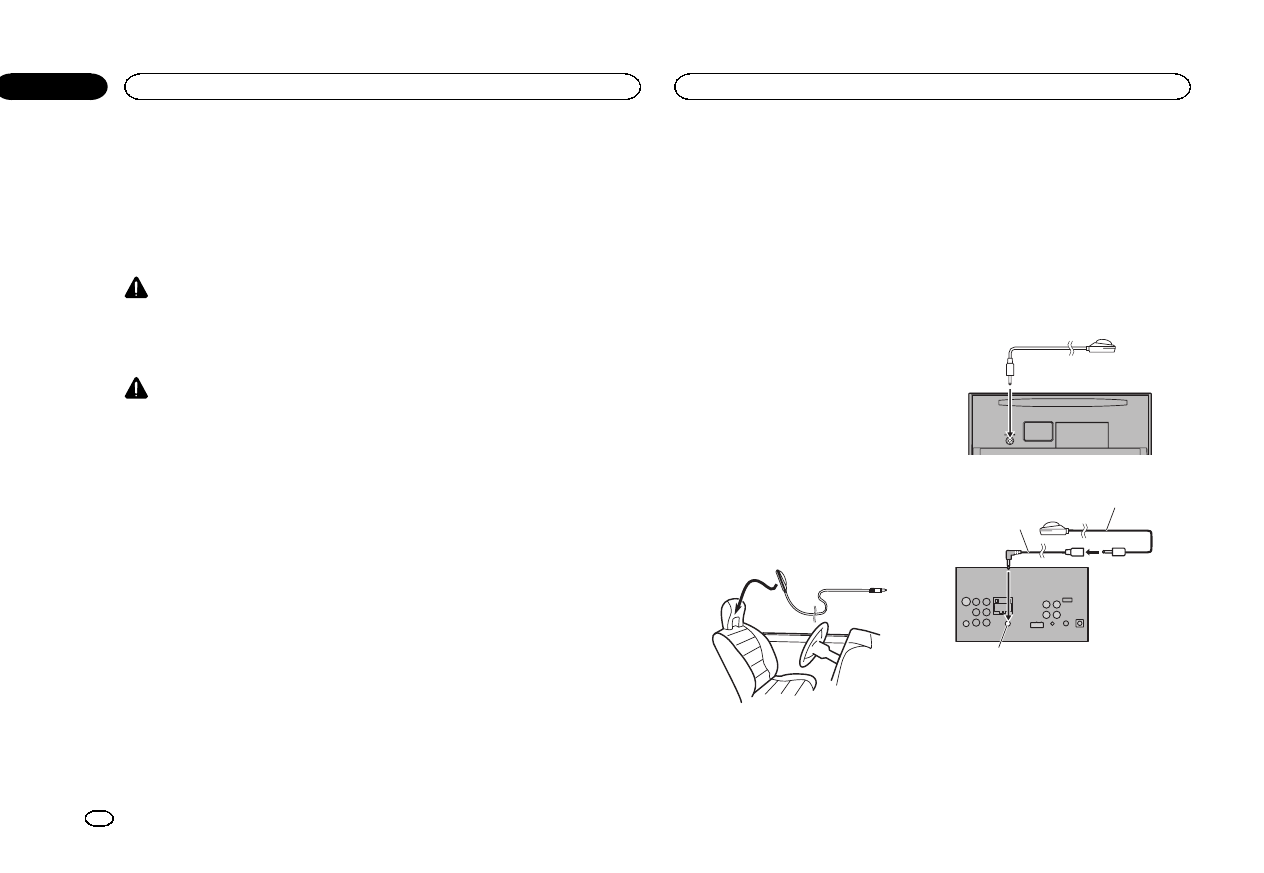
Auto EQ (auto-equalizing)
The auto-equalizer automatically measures the
car’s interior acoustic characteristics, and then
creates an auto-equalizer curve based on that in-
formation.
!To perform this function, dedicated micro-
phone (e.g. CD-MC20) is required.
WARNING
As a loud tone (noise) may be emitted from the
speakers when measuring the car’s interior
acoustic characteristics, never perform auto EQ
while driving.
CAUTION
!Thoroughly check the conditions before per-
forming auto EQ as the speakers may be
damaged if these functions are performed
when:
—The speakers are incorrectly connected. (For
example, when a rear speaker is connected
as a subwoofer output.)
—A speaker is connected to a power amp deliv-
ering output higher than the speaker’s maxi-
mum input power capability.
!If the microphone is placed in an unsuitable
position the measurement tone may become
loud and measurement may take a long
time, resulting in battery drainage. Be sure
to place the microphone in the specified lo-
cation.
Before operating the auto EQ
function
!Carry out auto EQ in as quiet a place as pos-
sible, with the car engine and air condition-
ing switched off. Also cut power to car
phones or portable telephones in the car, or
remove them from the car before carrying
out auto EQ. Sounds other than the measure-
ment tone (surrounding sounds, engine
sound, telephones ringing etc.) may prevent
correct measurement of the car interior
acoustic characteristics.
!Be sure to carry out auto EQ using the op-
tional microphone. Using another micro-
phone may prevent measurement, or result
in incorrect measurement of the car interior
acoustic characteristics.
!In order to perform auto EQ, the front speak-
er must be connected.
!When this unit is connected to a power amp
with input level control, auto EQ may not be
possible if the power amp’s input level is set
below the standard level.
!When this unit is connected to a power amp
with an LPF, turn this LPF off before perform-
ing auto EQ. Also set the cut-off frequency
for the built-in LPF of an active subwoofer to
the highest frequency.
!The distance has been calculated by com-
puter to be the optimum delay to give accu-
rate results for the circumstances, so please
continue to use this value.
—The reflected sound within the car is
strong and delays occur.
—The LPF on active subwoofers or external
amps delay the lower sounds.
!Auto EQ changes the audio settings as fol-
lows:
—The fader/balance settings return to the
center position. (Refer to Using fader/bal-
ance adjustment on page 33.)
—The equalizer curve switches to Flat.
(Refer to Recalling equalizer curves on
page 33.)
—The front, center and rear speakers will
automatically be adjusted to a high pass
filter setting.
!Previous settings for auto EQ will be overwrit-
ten.
!If using an AVH-X3500BHS, AVH-X2500BT, or
AVH-X1500DVD, connect a microphone ex-
tension cable (sold separately) to the AUX
input in advance.
Performing auto EQ
1 Stop the car in a place that is quiet, close
all the doors, windows and sun roof, and
then turn the engine off.
If the engine is left running, engine noise may
prevent correct auto EQ.
2 Fix the optional microphone in the center
of the headrest of the driver’s seat, facing
forward.
The auto EQ may differ depending on where you
place the microphone. If desired, place the mi-
crophone on the front passenger seat to carry
out auto EQ.
3 Turn the ignition switch to ON or ACC.
If the car’s air conditioner or heater is turned on,
turn it off. Noise from the fan in the air condi-
tioner or heater may prevent correct auto EQ.
4 Press the home button to switch to the
home display.
5 Touch the system key to open the system
menu.
6 Touch Auto EQ Measurement to enter
auto EQ measurement mode.
7 Plug the microphone into the micro-
phone input jack on this unit.
AVH-X5500BHS and AVH-X4500BT
AVH-X3500BHS, AVH-X2500BTand AVH-
X1500DVD
AUX input
(AUX)
Extension Cable
(Sold separately)
Microphone
8 Touch Start to start auto EQ.
9 When the 10-second countdown starts,
get out of the car and close the door within
10 seconds.
A measurement tone (noise) is emitted from the
speakers, and auto EQ measurement begins.
System settings
40
Section
System settings
En
20
<CRD4703-A/N>40

When auto EQ is completed, The measurement
has finished. Please disconnect the micro-
phone and then push HOME key. is displayed.
When the car’s interior acoustic characteristics
cannot be measured correctly, an error message
will be displayed. (Refer to Understanding auto
EQ error messages on page 56.)
#It takes about nine minutes for auto EQ measure-
ment to be completed when all the speakers are con-
nected.
#To stop auto EQ, touch Stop.
10 Store the microphone carefully in the
glove compartment or another safe place.
If the microphone is subjected to direct sunlight
for an extended period, high temperatures may
cause distortion, color change or malfunction.
Setting the video signal
When you connect this unit to an AV equipment
to this unit, select the suitable video signal set-
ting.
!As this function is initially set to Auto, the
unit will automatically adjust the video signal
setting.
!You can operate this function only for the
video signal input into the AV input.
1 Press the home button to switch to the
home display.
2 Touch the system key to open the system
menu.
3 Touch Video Signal Setting on the func-
tion menu.
Video Signal Setting items are displayed.
!AV –Adjusts the AV video signal
!AUX –Adjusts the AUX video signal
!Camera –Adjusts the rear view camera video
signal
4 Touch cor dto select the desired video
signal appears.
Auto—PAL—NTSC—PAL-M—PAL-N—SECAM
Using the Favorite menu
1 Display menu columns to register.
Refer to Menu operations on page 32.
#You can customize menus except Video Setup
menu.
2 Touch the star icon in the menu column
for the desired menu to register the menu.
The star icon for the selected menu is filled in.
#To cancel the registration, touch the star icon in
the menu column again.
3 Display the favorite menu and choose a
registered menu.
Refer to Menu operations on page 32.
Note
You can register up to 12 columns.
English
System settings
41
Section
Favorite menu
En
20
21
<CRD4703-A/N>41
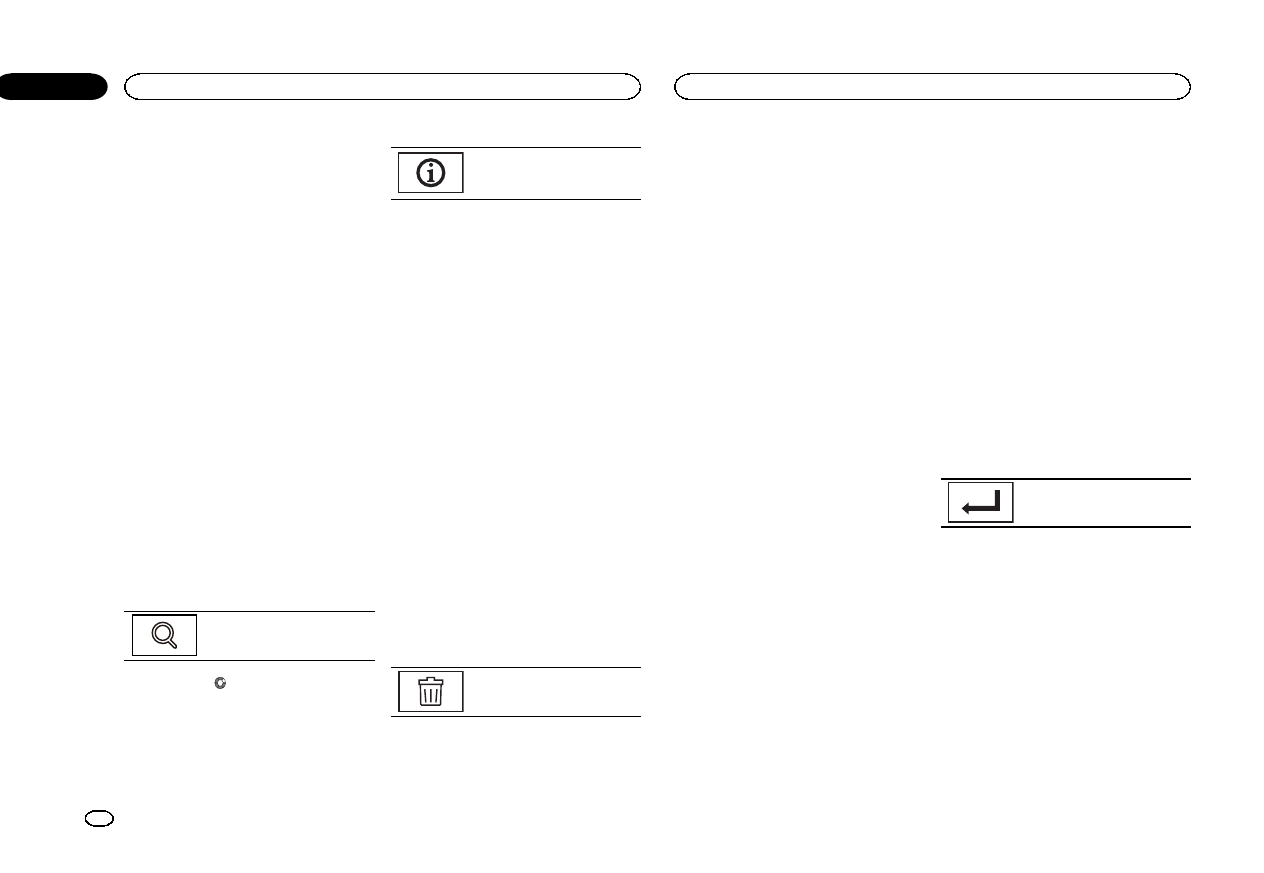
Bluetooth connection menu
operations
(Function of AVH-X5500BHS/AVH-X4500BT/AVH-
X3500BHS/AVH-X2500BT)
Note
If you are using a cellular phone that can be
connected via Bluetooth wireless technology, we
recommend that you use your phone to search
for this unit and establish a connection between
it and your phone. The PIN code is set to 0000
as default. The product name for this unit will
display on your phone as the device name. For
details, refer to Entering PIN code for Bluetooth
wireless connection on this page. For further de-
tails concerning the procedures for establishing
Bluetooth wireless connections, refer to the in-
struction manual for the phone.
Pairing from this unit
1 Press the home button to switch to the
home display.
2 Touch the Bluetooth key to open the
Bluetooth connection menu.
3 Touch Connection to select a device.
4 Start to search.
Starting to search.
While searching, is displayed and when avail-
able devices are found, the device names or
Bluetooth device addresses (if names cannot be
obtained) are displayed.
#If you want to switch between the device names
and Bluetooth device addresses, touch the icon.
Switching between the device
names and Bluetooth device ad-
dresses.
#To cancel searching, touch Stop.
#If three devices are already paired, Memory Full
is displayed and pairing cannot be performed. In
such cases, delete a paired device first. Refer to this
page.
#If no device can be found, Not Found is dis-
played. In such cases, check the status of the
Bluetooth device and search again.
5 Touch a device name to select the device
you want to connect to.
While connecting, Pairing is displayed. If the
connection is established, Paired is displayed.
#If your device support SSP (Secure Simple Pair-
ing), 6-digit number appears on the display of this
unit. Once the connection is established, this num-
ber disappears.
#If the connection fails, Error is displayed. In such
cases, try again from the beginning.
#The PIN code is set to 0000 as the default, but
can be changed. Refer to Entering PIN code for
Bluetooth wireless connection on this page.
#Once the connection is established, the device
name is displayed.
Touch the device name to disconnect.
#If you want to delete a paired Bluetooth tele-
phone, display Delete OK?. Touch Yes to delete the
device.
Deleting a paired device.
#Never turn the unit off while the paired Bluetooth
telephone is being deleted.
Connecting to a Bluetooth
device automatically
If this function is set to on, a connection be-
tween your Bluetooth device and this unit will
take place automatically as soon as the two devi-
ces are less than a few meters apart.
Initially, this function is set to on.
1 Press the home button to switch to the
home display.
2 Touch the Bluetooth key to open the
Bluetooth connection menu.
3 Touch Auto Connect to turn automatic
connection on.
If your Bluetooth device is ready for a Bluetooth
wireless connection, a connection to this unit
will automatically be established.
#To turn automatic connection off, touch
Auto Connect again.
If connection fails, “Auto connection failed.
Retry?”appears. Touch Yes to reconnect.
4 Once you turn your vehicle’s ACC switch
on again, a connection is established auto-
matically.
Switching visible unit
This function sets whether or not to make this
unit visible to the other device.
Initially, this function is set to on.
1 Press the home button to switch to the
home display.
2 Touch the Bluetooth key to open the
Bluetooth connection menu.
3 Touch Visibility to select visibility off.
#To turn visibility on, touch Visibility again.
Entering PIN code for Bluetooth
wireless connection
To connect your Bluetooth device to this unit via
Bluetooth wireless technology, you need to enter
a PIN code on your Bluetooth device to verify the
connection. The default code is 0000, but you
can change it with this function.
1 Press the home button to switch to the
home display.
2 Touch the Bluetooth key to open the
Bluetooth connection menu.
3 Touch PIN Code Input to select
PIN Code Input.
4 Touch 0 to 9 to input pin code.
5 After inputting PIN code (up to 8 digits),
store in this unit.
Storing the PIN code in this unit.
Displaying Bluetooth Device
address
This unit displays its Bluetooth device address.
1 Press the home button to switch to the
home display.
2 Touch the Bluetooth key to open the
Bluetooth connection menu.
3 Touch Device Information to display de-
vice information.
The Bluetooth device address is displayed.
HBluetooth connection menu
42
Section
HBluetooth connection menu
En
22
<CRD4703-A/N>42
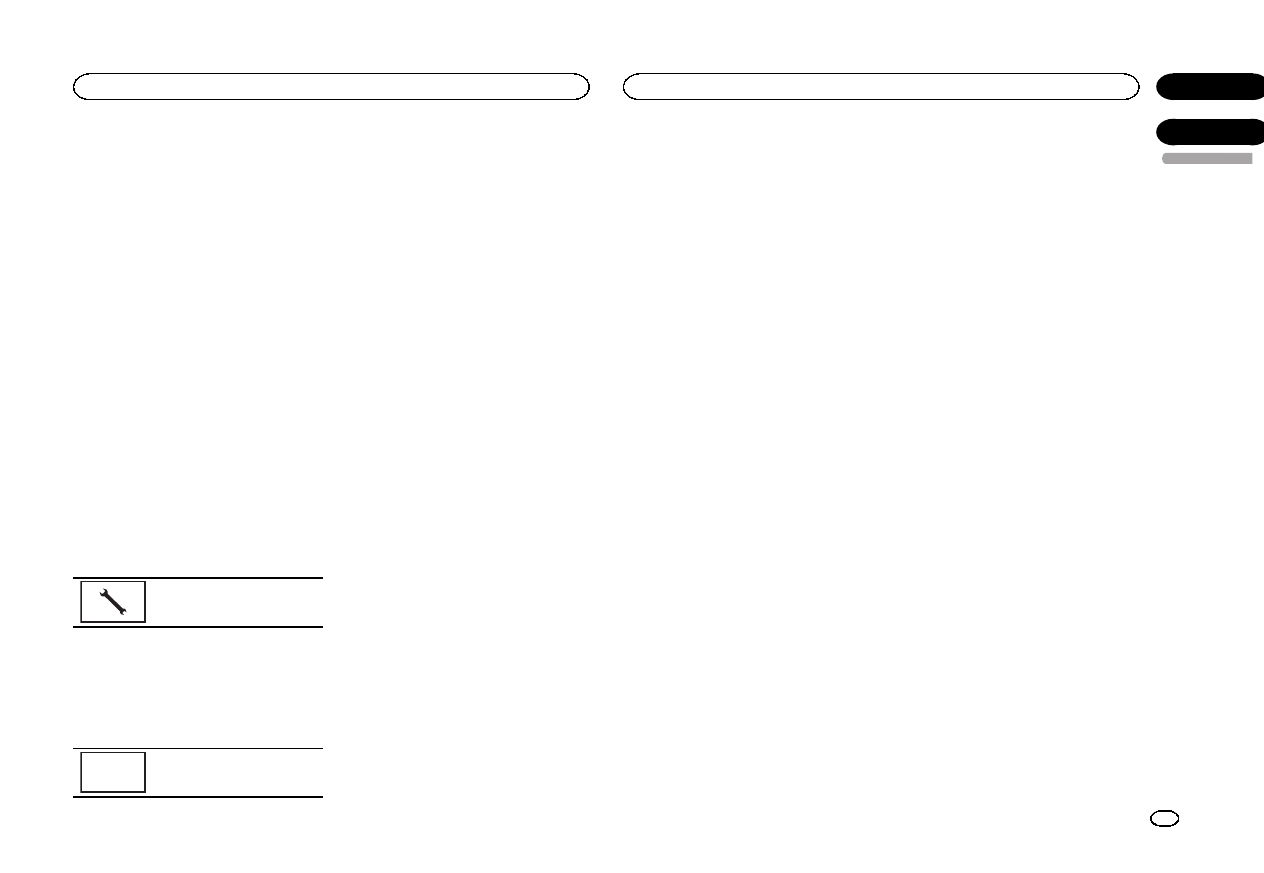
Selecting the illumination color
This unit is equipped with multiple-color illumi-
nation.
Direct selection from preset
illumination colors
You can select an illumination color from the
color list.
1 Press the home button to switch to the
home display.
2 Touch the theme key to open the theme
settings.
3 Touch Illumination and then touch a color
on the list.
Customizing the illumination color
1 Press the home button to switch to the
home display.
2 Touch the theme key to open the theme
settings.
3 Touch Illumination and then touch
Custom.
4 Display the customizing menu.
Displaying the customizing
menu.
5 Touch the color bar to customize the
color.
6 Touch cor dto fine-tune the color.
7 Touch the icon and hold to store the cus-
tomized color in the memory.
Memo
Storing the customized color in
the memory.
The customized color has been stored in the
memory.
The set color will be recalled from the memory
the next time you touch the same icon.
Selecting the OSD (on-screen
display) color
The OSD color can be changed.
1 Press the home button to switch to the
home display.
2 Touch the theme key to open the theme
settings.
3 Touch Screen.
4 Touch one of the colors on the list.
Selecting the background
display
You can switch the background that is displayed
when listening to a source.
1 Press the home button to switch to the
home display.
2 Touch the theme key to open the theme
settings.
3 Touch Background.
4 Touch the desired setting.
#If no JPEG images are stored in this unit, you
cannot select photo. To store a JPEG image to this
unit, refer to Capture an image in JPEG files on page
25.
#If you want to delete the captured JPEG image,
touch and hold the key of the JPEG image.
#You can view the hidden settings by flicking the
display.
Adjusting the response
positions of the touch panels
(Touch Panel Calibration)
If you feel that the touch panel keys on the
screen deviate from the actual positions that re-
spond to your touch, adjust the response posi-
tions of the touch panel. There are two
adjustment methods: 4-point adjustment, in
which you touch four corners of the screen; and
16-point adjustment, in which you make fine-ad-
justments on the entire screen.
!Park your car in a safe place and use this
function. Do not operate it while driving.
!Touch the screen gently for adjustment.
Forcefully pressing the touch panel may
damage the touch panel. Do not use a sharp
pointed tool such as a ballpoint pen or me-
chanical pen. Doing so may damage the
screen.
!If the touch panel cannot be adjusted prop-
erly, consult your local Pioneer dealer.
1 Turn the source off.
Refer to Turning the source ON/OFF on page 8.
2 Press and hold the home button to start
Touch Panel Calibration.
The 4-point touch panel adjustment screen ap-
pears. When 2-point appears at once, touch
both.
3 Touch each of the arrows on the four cor-
ners of the screen.
#To cancel the adjustment, press and hold the
home button.
4 Press the home button to complete 4-
point adjustment.
Data for the adjusted position is saved.
#Do not turn off the engine while the data is being
saved.
5 Press the home button to proceed to 16-
point adjustment.
The 16-point touch panel adjustment screen ap-
pears.
#To cancel the adjustment, press and hold the
home button.
6 Gently touch the center of the + mark dis-
played on the screen.
After you touch all the marks, the data for the
adjusted position is saved.
#Do not turn off the engine while the data is being
saved.
7 Press and hold the home button to com-
plete the adjustment.
Using an AUX source
An auxiliary device or portable device sold sepa-
rately can be connected to this unit.
About AUX connection methods
You can connect auxiliary devices to this unit.
Mini pin plug cable (AUX)
When connecting an auxiliary device using a mini
plug cable
iPods and portable audio/video players can be
connected to this unit via mini plug cable.
!If an iPod with video capabilities is con-
nected to this unit via 3.5mm plug (4 pole)
cable (such as the CD-V150M), you can enjoy
the video contents of the connected iPod.
!A portable audio/video player can be con-
nected by using a 3.5 mm plug (4 pole) with
an RCA cable (sold separately). However, de-
pending on the cable, a reverse connection
between the red (right side audio) cable and
yellow (video) cable may be required in order
for the sound and video image to be repro-
duced correctly.
English
Theme menu
43
Section
Other functions
En
23
24
<CRD4703-A/N>43
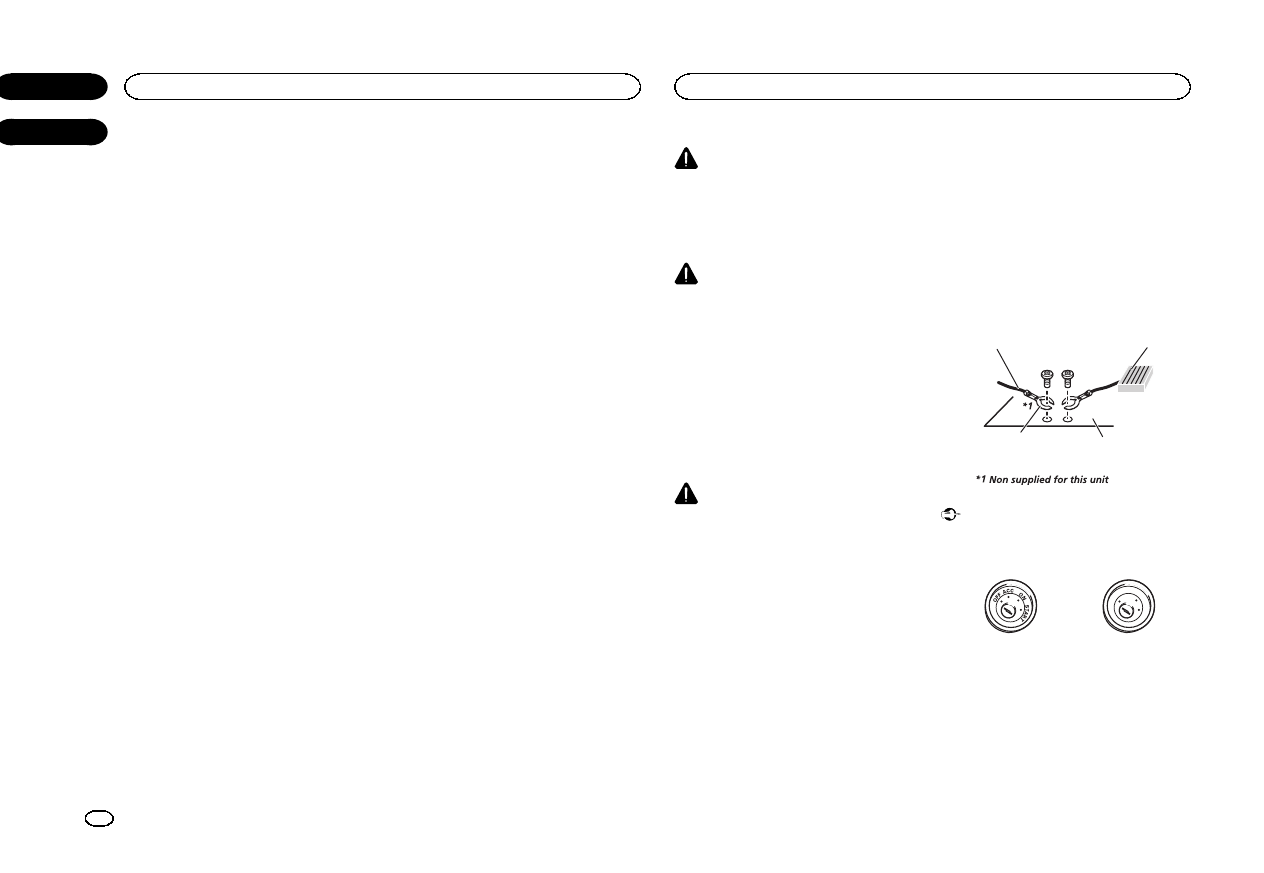
%Insert the stereo mini plug into the AUX
input jack on this unit.
Refer to Connection on page 46.
Resetting the microprocessor
By pressing RESET, you can reset the microproc-
essor to its initial settings without changing the
bookmark information.
The microprocessor must be reset in the follow-
ing situations:
!Before using this unit for the first time after
installation
!If the unit fails to operate properly
!When strange or incorrect messages appear
on the display
1 Turn the ignition switch OFF.
2 Press RESET with a pen tip or other
pointed instrument.
Refer to What’s what on page 7.
Note
Switch your engine ON or set the ignition switch
to ACC ON before pressing RESET in the follow-
ing situations:
!After completing connections
!When erasing all stored settings
!When resetting the unit to its initial (factory) set-
tings
WARNING
!In some countries or states the viewing of images
on a display inside a vehicle even by persons
other than the driver may be illegal. Where such
regulations apply, they must be obeyed and this
unit’s DVD features should not be used.
CAUTION
!Do not drill a hole into the engine compart-
ment to connect the yellow cable of the dis-
play unit to the vehicle battery. Engine
vibration may eventually cause the insulation
to fail at the point where the wire passes
from the passenger compartment into the
engine compartment. Take extra care in se-
curing the wire at this point.
!Make sure that cables will not interfere with
moving parts of the vehicle, such as the shift
lever, parking brake or seat sliding mecha-
nism.
WARNING
!Use speakers over 50 W (output value) and
between 4 Wto 8 W(impedance value). Do
not use 1 Wto 3 Wspeakers for this unit.
!The black cable is ground. When installing
this unit or power amp (sold separately),
make sure to connect the ground wire first.
Make sure that the ground cable is properly
connected to metal parts of the car body
using a spade terminal sold commercially.
The ground wire of the power amp and the
one of this unit or any other device must be
connected to the car separately with different
screws. If the screw for the ground wire loos-
ens or falls out, it could result in fire, genera-
tion of smoke or malfunction.
Ground wire
Metal parts of car’s body
POWER AMP
Other devices
(Another electronic
device in the car)
Important
!This unit cannot be installed in a vehicle
without ACC (accessory) position on the igni-
tion switch.
O
N
S
T
A
R
T
O
F
F
ACC position No ACC position
!Use this unit with a 12-volt battery and nega-
tive grounding only. Failure to do so may re-
sult in a fire or malfunction.
!To prevent a short-circuit, overheating or mal-
function, be sure to follow the directions
below.
—Disconnect the negative terminal of the bat-
tery before installation.
Other functions
44
Section
Connection
En
24
25
<CRD4703-A/N>44

—Secure the wiring with cable clamps or adhe-
sive tape. Wrap adhesive tape around wiring
that comes into contact with metal parts to
protect the wiring.
—Place all cables away from moving parts,
such as the shift lever and seat rails.
—Place all cables away from hot places, such
as near the heater outlet.
—Do not connect the yellow cable to the battery
by passing it through the hole to the engine
compartment.
—Cover any disconnected cable connectors
with insulating tape.
—Do not shorten any cables.
—Never cut the insulation of the power cable of
this unit in order to share the power with
other devices. The current capacity of the
cable is limited.
—Use a fuse of the rating prescribed.
—Never wire the negative speaker cable directly
to ground.
—Never band together negative cables of multi-
ple speakers.
!When this unit is on, control signals are sent
through the blue/white cable. Connect this
cable to the system remote control of an ex-
ternal power amp or the vehicle’s auto-anten-
na relay control terminal (max. 300 mA
12 V DC). If the vehicle is equipped with a
glass antenna, connect it to the antenna
booster power supply terminal.
!Never connect the blue/white cable to the
power terminal of an external power amp.
Also, never connect it to the power terminal
of the auto antenna. Doing so may result in
battery drain or a malfunction.
English
Connection
45
Section
Connection
En
25
<CRD4703-A/N>45
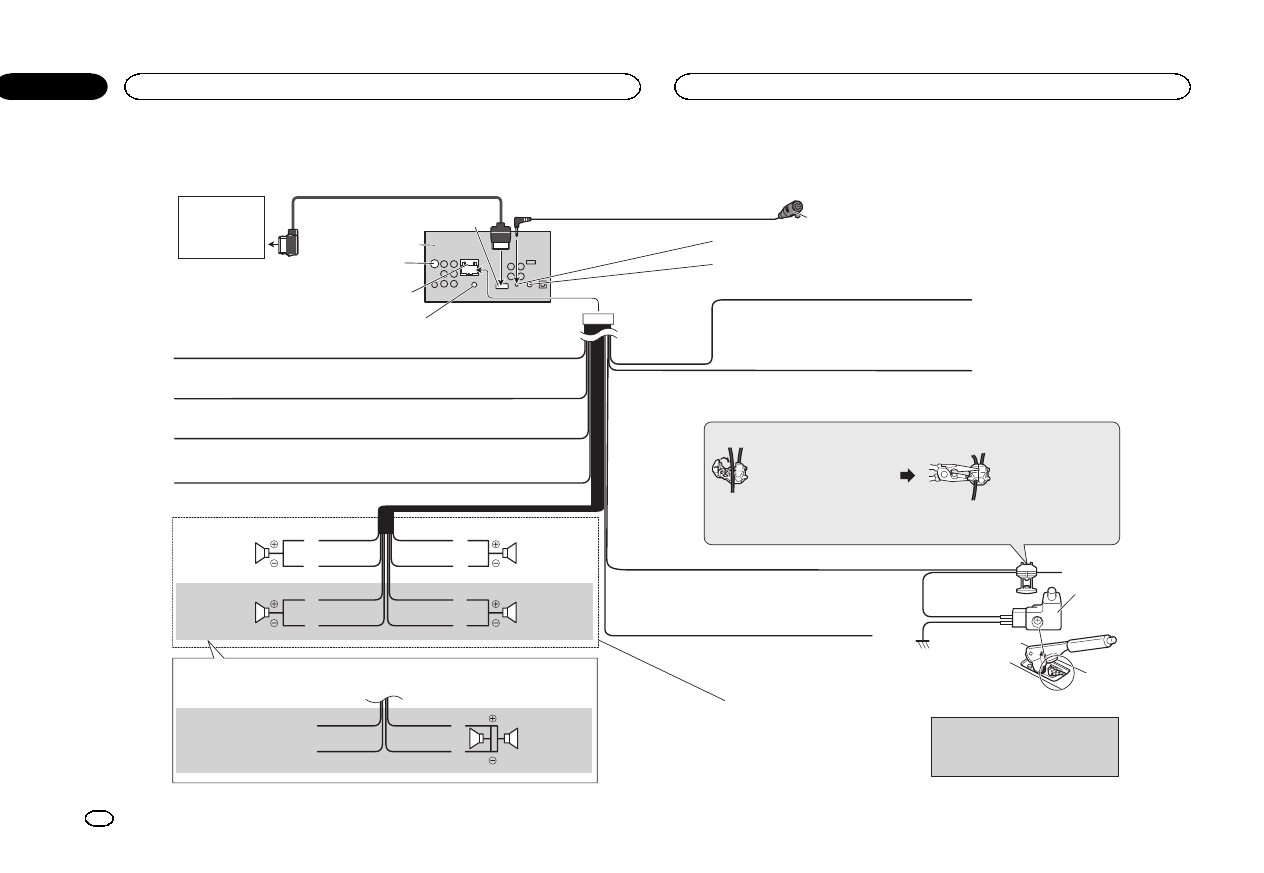
Connecting the power cord
Connection method
1. Clamp the lead. 2. Clamp firmly with
needle-nosed pliers.
Note:
· The position of the parking brake switch depends on the vehicle model. For details,
consult the vehicle Owner’s Manual or dealer.
Yellow/black
If you use an equipment with Mute function, wire this lead to
the Audio Mute lead on that equipment. If not, keep the Audio
Mute lead free of any connections.
Light green
Used to detect the ON/OFF status of the parking
brake. This lead must be connected to the power
supply side of the parking brake switch.
Blue/white
Connect to system control terminal of the power amp or
auto-antenna relay control terminal (max. 300 mA 12 V DC).
Ground side
Power supply side
Parking brake
switch
Yellow
Connect to the constant 12 V supply terminal.
Red
Connect to terminal controlled by ignition switch (12 V DC).
Black (chassis ground)
Connect to a clean, paint-free metal location.
Left Right
Front speaker Front speaker
Rear speaker or
Subwoofer (4 Ω)
White Gray
Gray/blackWhite/black
Green Violet
Green/black Violet/black
With a 2 speaker system, do not connect anything to the speaker leads
that are not connected to speakers.
Note:
· Change the initial setting of this unit. The
subwoofer output of this unit is monaural.
Violet
Violet/black
Not used.
Green
Green/black
When using a subwoofer of 70 W (2 Ω), be sure to connect with Violet and Violet/black leads of this unit.
Do not connect anything to Green and Green/black leads.
Subwoofer (4 Ω)
× 2
Rear speaker or
Subwoofer (4 Ω)
Fuse (10 A)
Violet/white
Of the two lead wires connected to the back lamp, connect the one
in which the voltage changes when the gear shift is in the
REVERSE (R) position. This connection enables the unit to
sense whether the car is moving forwards or backwards.
Orange/white
Connect to lighting switch terminal.
Microphone
(Function of AVH-X5500BHS/AVH-X4500BT/AVH-X3500BHS/AVH-X2500BT)
4 m (13 ft. 1 in.)
Microphone input
(Function of AVH-X5500BHS/AVH-X4500BT/AVH-X3500BHS/AVH-X2500BT)
This product
Antenna input
AUX jack (3.5 ø)
Use a mini plug cable to connect with auxiliary
device.
RGB input
Navigation system
(AVIC-U220(sold
separately))
Please contact your dealer to
inquire about the connectable
navigation unit.
Insert the 26 pin cable in the direction
indicated in the figure.
26 pin cable (Supplied with navigation unit)
Wired remote input
Hard-wired remote control adapter can be connected
(sold separately).
Connection
46
Section
Connection
En
25
<CRD4703-A/N>46
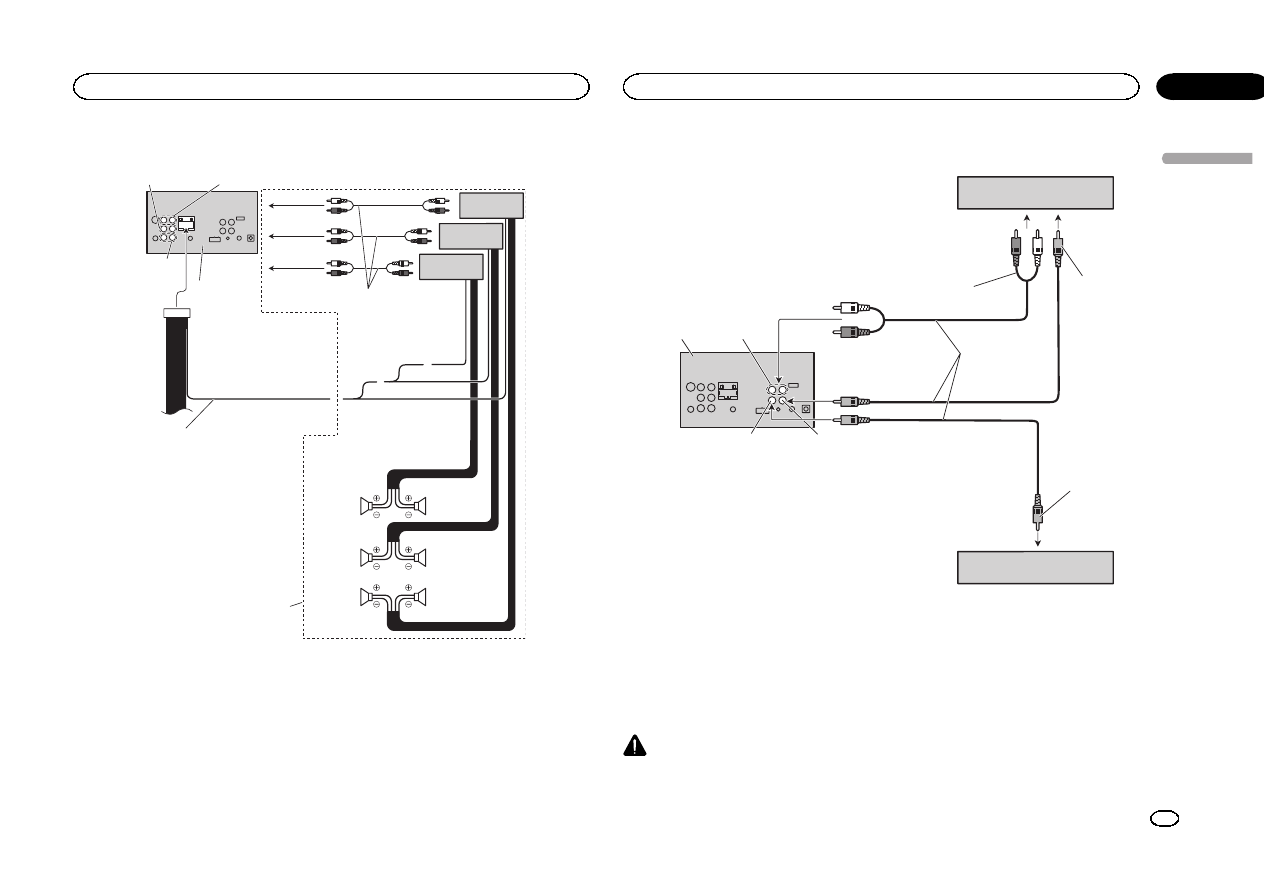
When connecting to separately sold power amp
Connect with RCA cables
(sold separately)
Rear speaker
Perform these connections when
using the optional amplifier.
System remote control
Front speaker Front speaker
Left Right
Rear speaker
Power amp
(sold separately)
Power amp
(sold separately)
Power amp
(sold separately)
Subwoofer Subwoofer
To front output
To rear output
To subwoofer
output
Blue/white
Connect to system control terminal of the
power amp or auto-antenna relay control
terminal (max. 300 mA 12 V DC).
This product
Rear output Front output
Subwoofer
output
When connecting the external video component and the display
External video component
(sold separately)
Audio inputs
(R IN, L IN)
Display with RCA input
jacks (sold separately)
To video
input
To video
output
To audio outputs
T
his product
RCA cables
(sold separately)
Rear monitor output
(V OUT)Video input (V IN)
!It is necessary to change AV Input in the
system menu when connecting the external
video component.
Refer to Setting AV input on page 37.
This product’s rear video output is for connec-
tion of a display to enable passengers in the rear
seats to watch the DVD, etc.
WARNING
!Never install a rear display in a location that is
visible to the driver while the vehicle is in motion.
English
Connection
47
Section
Connection
En
25
<CRD4703-A/N>47
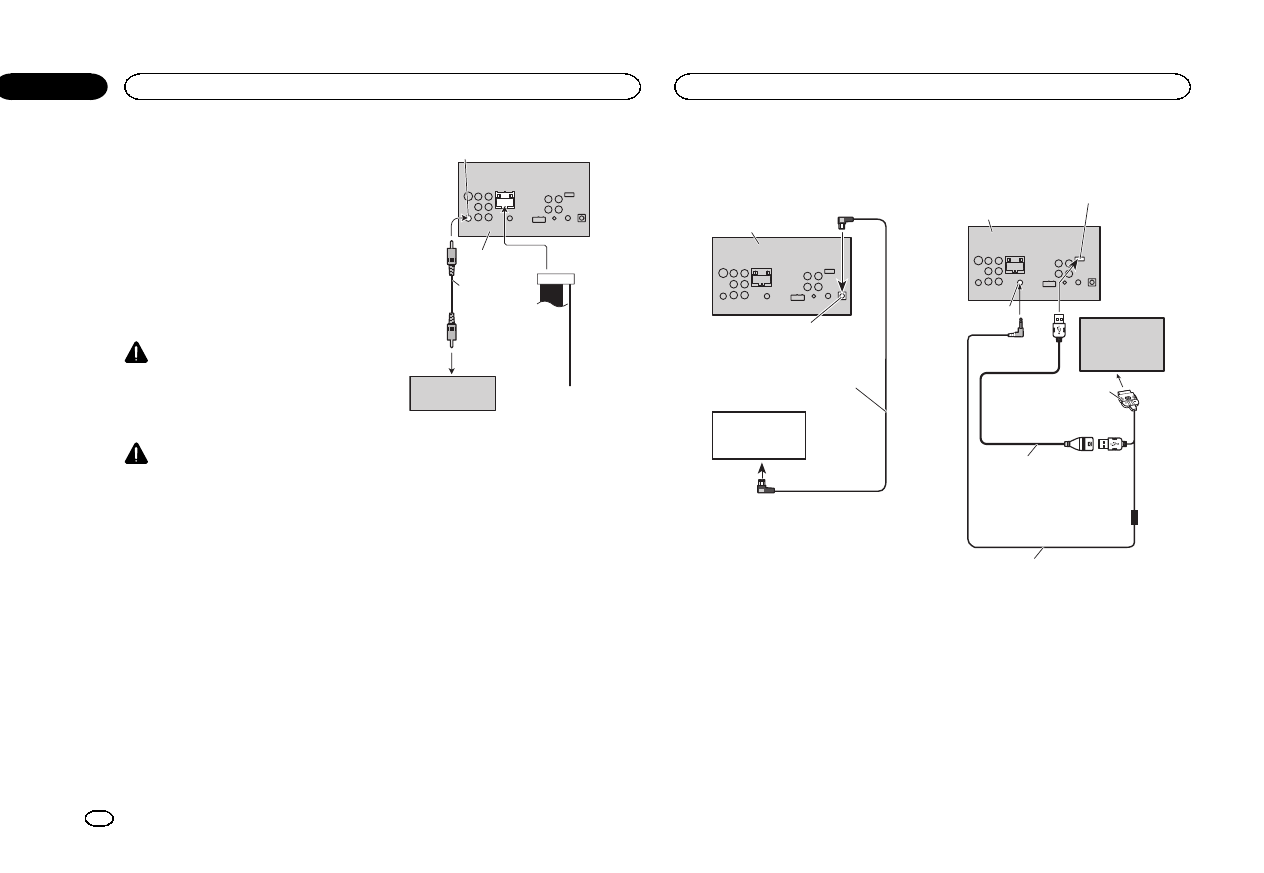
When connecting with a rear
view camera
If you switch the shift lever to REVERSE (R), the
display on this unit will automatically switch to
the rear view image. You need to set the
Camera Polarity properly in the system unit to
use. For details on settings, refer to Setting the
rear view camera (back up camera) on page 39.
You can also switch to the rear view image by
pressing the Touch key. For details, refer to
Using the rear view on page 10.
WARNING
USE INPUT ONLY FOR REVERSE OR MIR-
ROR IMAGE REAR VIEW CAMERA. OTHER
USE MAY RESULT IN INJURY OR DAM-
AGE.
CAUTION
!You must use a camera which outputs
mirror reversed images.
!The screen image may appear reversed.
!The rear view camera function is to be used
as an aid to keep an eye on trailers, or while
backing up. Do not use for entertainment
purposes.
!Objects in the rear view may appear closer or
more distant than they actually are.
To video output
Rear view camera
(sold separately)
Rear view camera input (R.C IN)
Violet/white
Of the two lead wires
connected to the back lamp,
connect the one in which the
voltage changes when the
gear shift is in the REVERSE
(R) position. This connection
enables the unit to
sense whether the car is
moving forwards or
backwards.
This product
RCA cable
(sold separately)
Optional SiriusXM Tuner
connection
(Function of AVH-X5500BHS/AVH-X3500BHS)
SiriusXM tuner
(sold separately)
T
his product
SiriusXM BUS cable
(Supplied with SiriusXM tuner)
SiriusXM BUS input
When connecting with optional
CD-IU201V cable
T
his product
Interface cable
(CD-IU201V) (sold separately)
AUX input
(AUX)
1.5 m (4 ft. 11 in.)
Dock connector
USB cable
(Supplied with this unit)
Connect to separately sold
USB device.
USB/iPod input
iPod with video
capabilities
(sold separately)
Connection
48
Section
Connection
En
25
<CRD4703-A/N>48
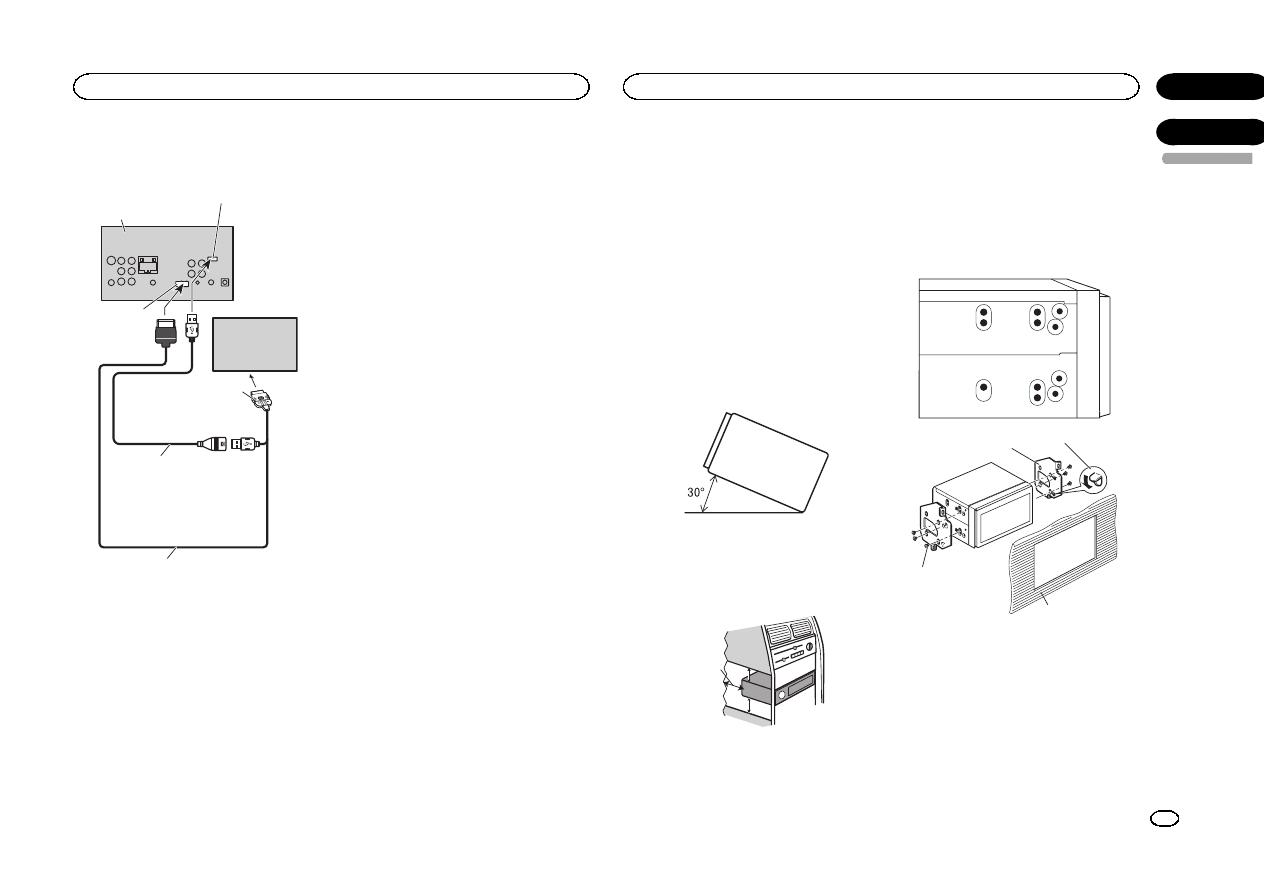
When connecting with optional
CD-IU201S cable
This product
1.5 m (4 ft. 11 in.)
Dock connector
USB cable
(Supplied with this unit)
Connect to separately sold
USB device.
USB/iPod input
iPod with video
capabilities
(sold separately)
RGB input
Interface cable
(CD-IU201S) (sold separately)
Notes
!Check all connections and systems before
final installation.
!Do not use unauthorized parts as this may
cause malfunctions.
!Consult your dealer if installation requires
drilling of holes or other modifications to the
vehicle.
!Do not install this unit where:
—it may interfere with operation of the vehicle.
—it may cause injury to a passenger as a result
of a sudden stop.
!The semiconductor laser will be damaged if
it overheats. Install this unit away from hot
places such as near the heater outlet.
!Optimum performance is obtained when the
unit is installed at an angle of less than 30°.
!When installing, to ensure proper heat dis-
persal when using this unit, make sure you
leave ample space behind the rear panel and
wrap any loose cables so they are not block-
ing the vents.
5cmcm
Leave ample
space 5 cm
5 cm
!To some types of vehicles, this unit cannot be
properly installed. In such case, use the op-
tional installation kit (ADT-VA133).
Installation using the screw
holes on the side of the unit
%Fastening the unit to the factory radio-
mounting bracket.
Position the unit so that its screw holes are
aligned with the screw holes of the bracket, and
tighten the screws at 3 locations on each side.
1
2
3
4
1If the pawl gets in the way, bend it down.
2Factory radio mounting bracket
3Use either truss (5 mm × 8 mm) or flush sur-
face (5 mm × 9 mm) screws, depending on
the bracket screw holes.
4Dashboard or console
English
Connection
49
Section
Installation
En
25
26
<CRD4703-A/N>49
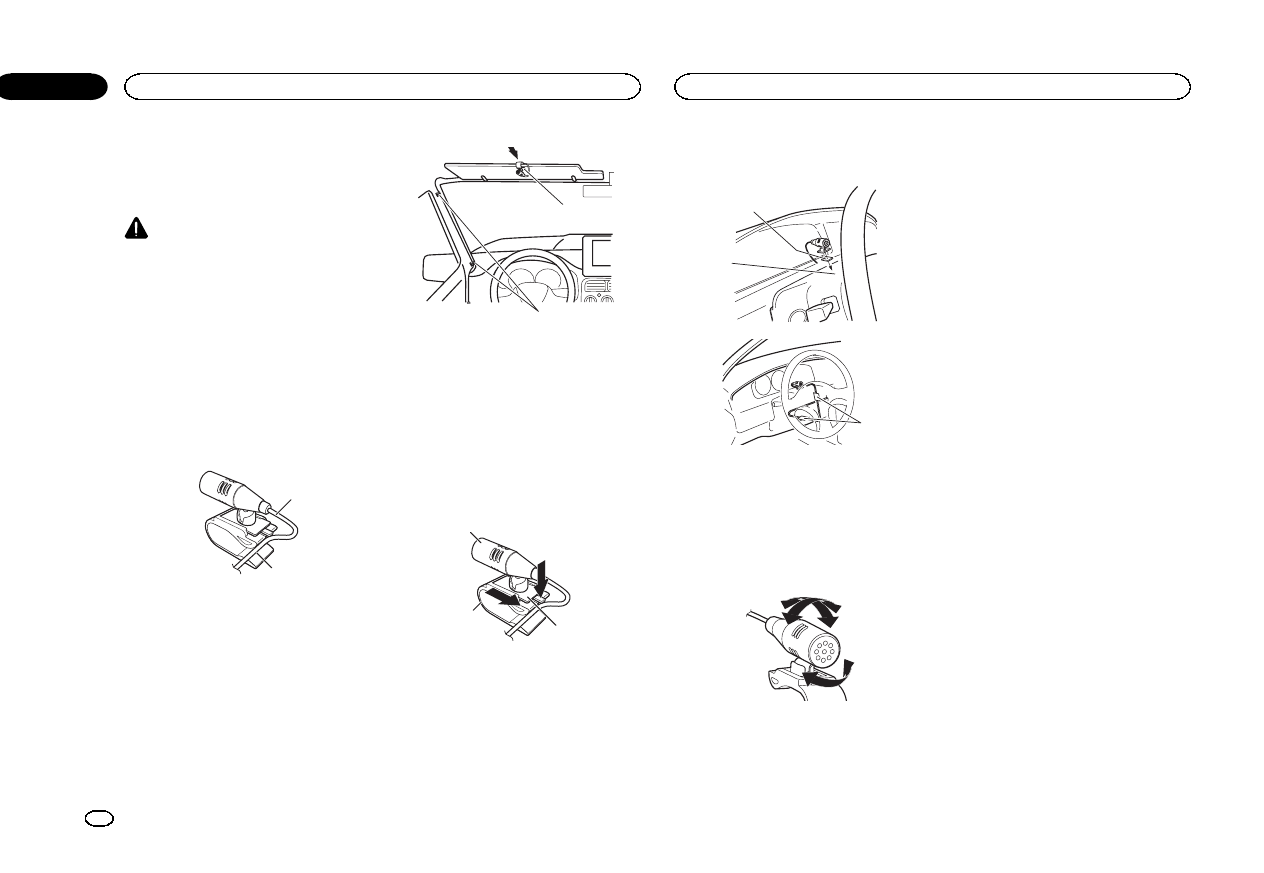
Installing the microphone
(Function of AVH-X5500BHS/AVH-X4500BT/AVH-
X3500BHS/AVH-X2500BT)
CAUTION
It is extremely dangerous to allow the micro-
phone lead to become wound around the steer-
ing column or shift lever. Be sure to install the
unit in such a way that it will not obstruct driv-
ing.
Note
Install the microphone in a position and orienta-
tion that will enable it to pick up the voice of the
person operating the system.
When installing the microphone
on the sun visor
1 Fit the microphone lead into the groove.
1
2
1Microphone lead
2Groove
2 Install the microphone clip on the sun
visor.
With the sun visor up, install the microphone
clip. (Lowering the sun visor reduces the voice
recognition rate.)
1
2
1Microphone clip
2Clamp
Use separately sold clamps to secure the
lead where necessary inside the vehicle.
When installing the microphone
on the steering column
1 Detach the microphone base from the mi-
crophone clip.
To detach the microphone base from the micro-
phone clip, slide the microphone base.
1
2
3
1Microphone
2Microphone clip
3Microphone base
2 Install the microphone on the steering
column.
1
2
3
1Double-sided tape
2Install the microphone on the rear side of the
steering column.
3Clamp
Use separately sold clamps to secure the
lead where necessary inside the vehicle.
Adjusting the microphone angle
The microphone angle can be adjusted.
Installation
50
Section
Installation
En
26
<CRD4703-A/N>50
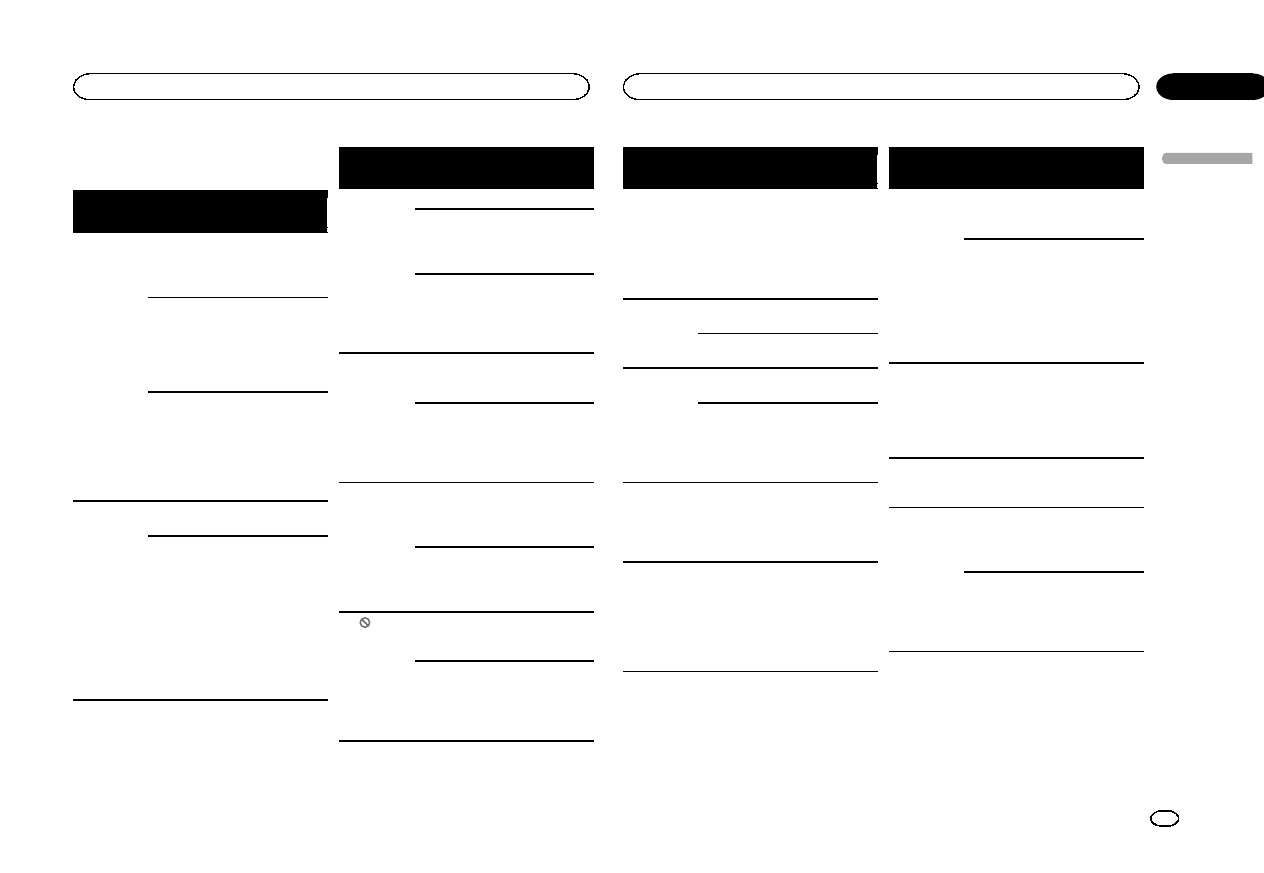
Troubleshooting
Common
Symptom Cause Action (Refer-
ence page)
The power
will not turn
on.
The unit will
not operate.
Leads and con-
nectors are in-
correctly con-
nected.
Confirm once
more that all con-
nections are cor-
rect.
The fuse is
blown.
Rectify the cause
and then replace
the fuse. Be sure
to install a fuse
with the same rat-
ing.
Noise and/or
other factors
are causing the
built-in micro-
processor to op-
erate incor-
rectly.
Press RESET.
(Page 44)
Operation
with the re-
mote control
is not possi-
ble.
The unit does
not operate
correctly even
when the ap-
propriate re-
mote control
buttons are
pressed.
Battery power is
low.
Load a new bat-
tery.
Some opera-
tions are prohib-
ited with certain
discs.
Try operating with
another disc.
Symptom Cause Action (Refer-
ence page)
Playback is
not possible.
The disc is dirty. Clean the disc.
The type of disc
loaded cannot
be played on
this unit.
Check the disc
type.
The disc loaded
is not compati-
ble with this
video system.
Change the disc
to one that is
compatible with
your video sys-
tem.
There is no
sound.
The volume
level will not
rise.
Cables are not
connected cor-
rectly.
Connect the ca-
bles correctly.
The unit is per-
forming still,
slow motion or
frame-by-frame
playback.
There is no sound
during still, slow
motion or frame-
by-frame play-
back.
There is no
image dis-
played.
The parking
brake cable is
not connected.
Connect the park-
ing brake cable,
and apply the
parking brake.
The parking
brake is not ap-
plied.
Connect the park-
ing brake cable,
and apply the
parking brake.
The icon is
displayed,
and operation
is not possi-
ble.
The operation is
prohibited for
the disc.
This operation is
not possible.
The operation is
not compatible
with the config-
uration of the
disc.
This operation is
not possible.
Symptom Cause Action (Refer-
ence page)
The image
displayed
stops
(pauses) and
the unit can-
not be oper-
ated.
The data could
no longer be
read during
playback.
Stop playback
once, and start
playback again.
There is no
sound.
The volume
level is low.
The volume
level is low.
Adjust the volume
level.
The attenuator
is on.
Turn the attenua-
tor off.
The sound
and video
skip.
The unit is not
firmly secured.
Firmly secure the
unit.
File size and
transmission
rate are above
recommended
rates.
Create a DivX file
that is within the
recommended
size and transmis-
sion rate.
The aspect
ratio is incor-
rect and the
image is
stretched.
The aspect ratio
setting is incor-
rect for the dis-
play.
Select the appro-
priate setting for
your display.
(Page 35)
The motor
sounds when
the ignition
switch is
turned ON (or
is turned to
ACC).
The unit is con-
firming whether
or not a disc is
loaded.
This is a normal
operation.
Symptom Cause Action (Refer-
ence page)
Nothing is
displayed.
The touch
panel keys
cannot be
used.
The rear view
camera is not
connected.
Connect a rear
view camera.
Camera Polar-
ity is at incor-
rect setting.
Press the home
button to return
to the source dis-
play and then se-
lect the correct
setting for Cam-
era Polarity.
(Page 39)
No xxxx ap-
pears when a
display is
changed (No
Title, for ex-
ample).
There is no em-
bedded text in-
formation.
Switch the display
or play another
track/file.
Subfolders
cannot be
played back.
Folder repeat
play has been
selected.
Select the repeat
range again.
The repeat
range
changes auto-
matically.
Another folder
was selected
during repeat
play.
Select the repeat
range again.
Track search or
fast forward/re-
verse was per-
formed during
file repeat play.
Select the repeat
range again.
English
Additional information
51
Appendix
Additional information
En
<CRD4703-A/N>51
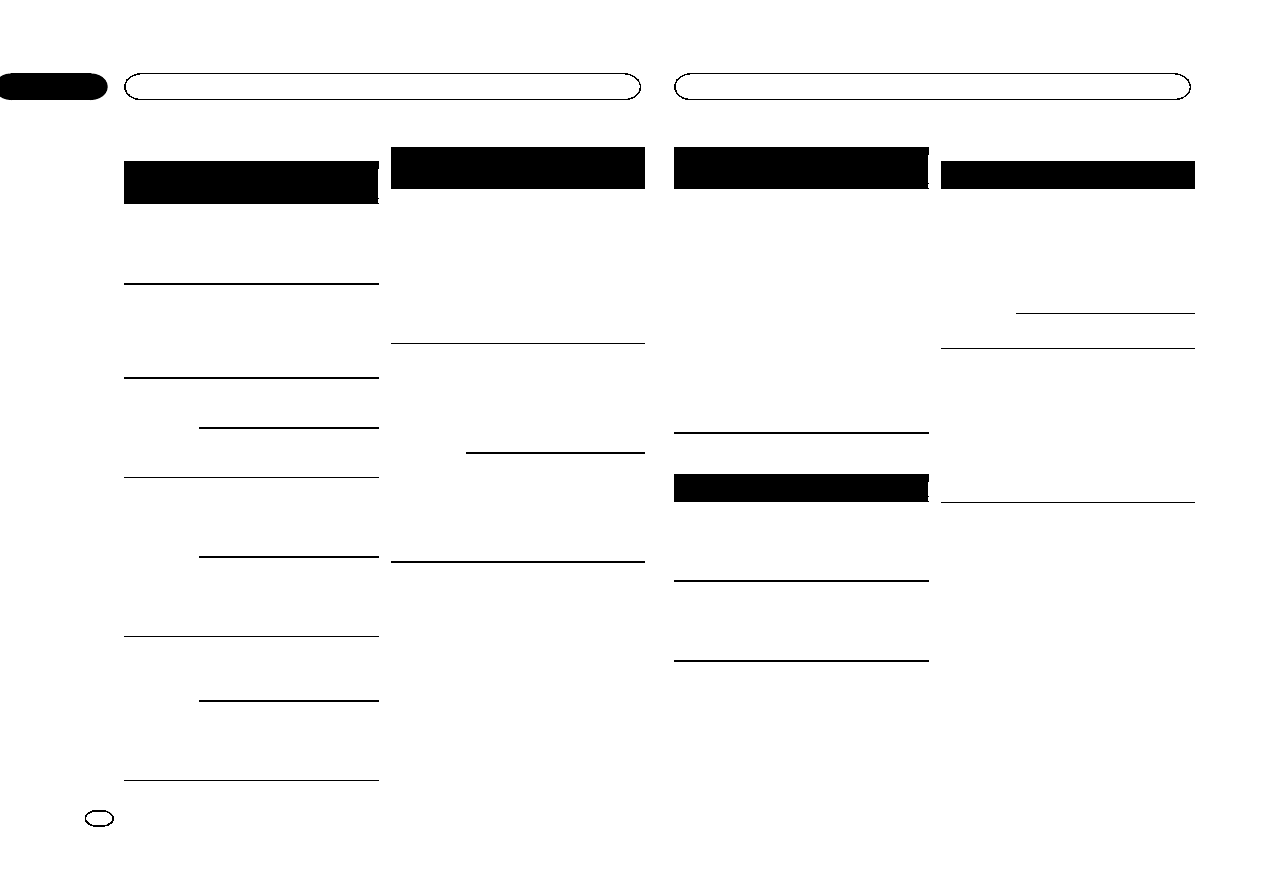
DVD
Symptom Cause Action (Refer-
ence page)
Playback is
not possible.
The loaded disc
has a different
region number
from this unit.
Replace the disc
with one featuring
the same region
number as this
unit.
A parental
lock message
is displayed
and playback
is not possi-
ble.
Parental lock is
activated.
Turn parental lock
off or change the
level. (Page 36)
Parental lock
cannot be
canceled.
The code num-
ber is incorrect.
Enter the correct
code number.
(Page 36)
You have forgot-
ten your code
number.
Press RESET.
(Page 44)
Dialog lan-
guage (and
subtitle lan-
guage) can-
not be
switched.
The DVD being
played does not
feature multiple
language re-
cordings.
The language
cannot be
switched if they
are not recorded
on the disc.
You can only
switch between
items indicated
in the disc
menu.
Switch the lan-
guage using the
disc menu.
No subtitles
are displayed.
The DVD being
played does not
feature subti-
tles.
Subtitles are not
displayed if they
are not recorded
on the disc.
You can only
switch between
items indicated
in the disc
menu.
Switch the lan-
guage using the
disc menu.
Symptom Cause Action (Refer-
ence page)
Playback is
not performed
with the
audio lan-
guage and
subtitle lan-
guage set-
tings selected
in Video
Setup menu.
The DVD being
played does not
feature dialog
or subtitles in
the selected lan-
guage.
The language
cannot be
switched if the se-
lected language
is not recorded on
the disc.
The viewing
angle cannot
be switched.
The DVD being
played does not
feature scenes
shot from multi-
ple angles.
The viewing angle
cannot be
switched if the
DVD does not fea-
ture scenes re-
corded from
multiple angles.
You are trying to
switch to multi-
angle viewing
for a scene that
was not re-
corded from
multiple angles.
Switch between
multiple angles
when watching
scenes recorded
from multiple an-
gles.
Symptom Cause Action (Refer-
ence page)
The image is
extremely un-
clear/dis-
torted and
dark during
playback.
Some discs fea-
ture a signal to
prohibit copy-
ing.
Since this unit is
compatible with
the analog copy
generation man-
agement system,
when playing a
disc that has a
signal prohibiting
copying, horizon-
tal stripes or
other imperfec-
tions may appear
when viewed on
some displays.
This is not a mal-
function.
Video CD
Symptom Cause Action
The PBC
(playback
control) menu
cannot be
called up.
The Video CD
being played
does not feature
PBC.
This operation is
not available for
Video CDs that do
not feature PBC.
Repeat play
and track/
time search
are not possi-
ble.
The Video CD
being played
features PBC.
This operation is
not available for
Video CDs that
feature PBC.
iPod
Symptom Cause Action
The iPod does
not operate
correctly.
The cables are
incorrectly con-
nected.
Disconnect the
cable from the
iPod. Once the
iPod’s main
menu is dis-
played, reconnect
the iPod and reset
it.
The iPod version
is old.
Update the iPod
version.
Sound from
the iPod can-
not be heard.
The audio out-
put direction
may switch au-
tomatically
when the
Bluetooth and
USB connec-
tions are used
at the same
time.
Use the iPod to
change the audio
output direction.
Additional information
52
Appendix
Additional information
En
<CRD4703-A/N>52
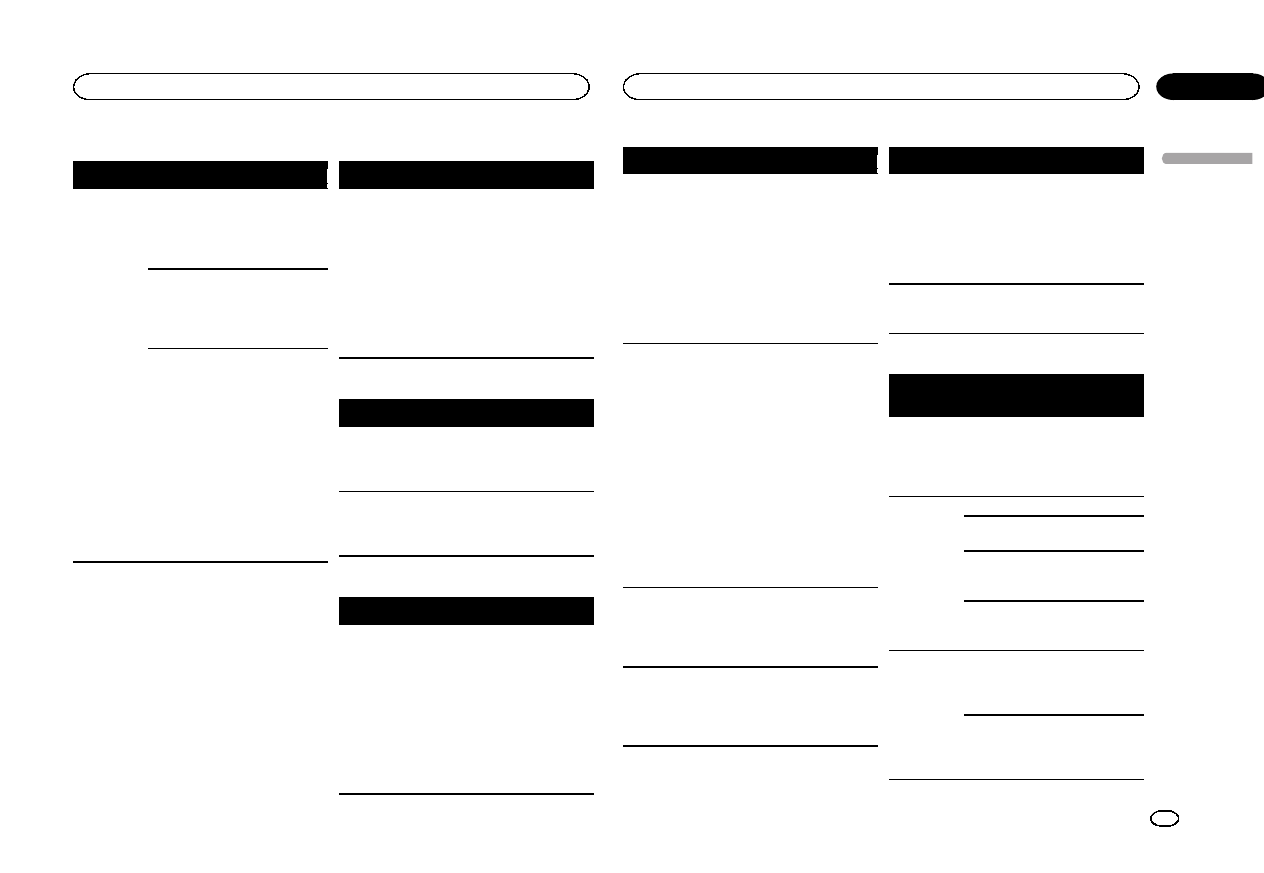
Bluetooth audio/telephone
Symptom Cause Action
The sound
from the
Bluetooth
audio source
is not played
back.
There is a call in
progress on a
Bluetooth con-
nected cellular
phone.
The sound will be
played back when
the call is termi-
nated.
A Bluetooth
connected cel-
lular phone is
currently being
operated.
Do not use the
cellular phone at
this time.
A call was
made with a
Bluetooth con-
nected cellular
phone and then
immediately ter-
minated. As a
result, commu-
nication be-
tween this unit
and the cellular
phone was not
terminated
properly.
Reconnect the
Bluetooth con-
nection between
this unit and the
cellular phone.
Error messages
When you contact your dealer or your nearest
Pioneer Service Center, be sure to note the error
message.
Common
Message Cause Action
AMP Error This unit fails to
operate or the
speaker connec-
tion is incorrect;
the protective
circuit is acti-
vated.
Check the speak-
er connection. If
the message fails
to disappear even
after the engine is
switched off/on,
contact your deal-
er or an author-
ized Pioneer
Service Station
for assistance.
Tuner
Message Cause Action
No Data Pro-
vided
This unit cannot
receive artist
name/song title
information.
Move to the desir-
able location with
good reception.
No Data This unit cannot
receive program
service name in-
formation.
Move to the desir-
able location with
good reception.
SiriusXM Satellite Radio
Message Cause Action
Check An-
tenna
The antenna
connection is
incorrect.
Check the anten-
na connection. If
the message fails
to disappear even
after the engine is
switched off/on,
contact your deal-
er or an author-
ized Pioneer
Service Station
for assistance.
Message Cause Action
Check Tuner The SiriusXM
Connect Vehicle
Tuner connec-
tion is incorrect.
Check the tuner
connection. If the
message fails to
disappear even
after the engine is
switched off/on,
contact your deal-
er or an author-
ized Pioneer
Service Station
for assistance.
No Signal The SiriusXM
Connect Vehicle
Tuner is having
difficulty receiv-
ing the
SiriusXM satel-
lite signal.
!Verify that your
vehicle is out-
doors with a clear
view of the south-
ern sky.
!Verify that the
SiriusXM mag-
netic mount an-
tenna is mounted
on a metal sur-
face on the out-
side the vehicle.
!Move the
SiriusXM antenna
away from any ob-
structions.
Subscription
Updated
This unit has de-
tected a change
in your
SiriusXM sub-
scription status.
Press any keys to
clear the mes-
sage.
Not Avail-
able
The channel
that you have
requested is not
a valid SiriusXM
channel.
Check the
SiriusXM channel
lineup.
Message Cause Action
Not Sub-
scribed
The channel
that you have
requested is not
included in your
SiriusXM sub-
scription pack-
age.
Check the con-
tent of your
SiriusXM sub-
scription pack-
age.
Channel
Locked
Locked by the
radio Parental
Control feature.
Release the chan-
nel lock.
DVD
Message Cause Action (Refer-
ence page)
Different Re-
gion Disc
The disc does
not have the
same region
number as this
unit.
Replace the DVD
with one bearing
the correct region
number. (Refer-
ence page)
Error-02-XX/
FF-FF
The disc is dirty. Clean the disc.
The disc is
scratched.
Replace the disc.
The disc is
loaded upside
down.
Check that the
disc is loaded cor-
rectly.
There is an elec-
trical or me-
chanical error.
Press RESET.
(Page 44)
Unplayable
Disc
This type of disc
cannot be
played on this
unit.
Replace the disc
with one that can
be played on this
unit.
The inserted
disc does not
contain any
playable files.
Replace the disc.
English
Additional information
53
Appendix
Additional information
En
<CRD4703-A/N>53
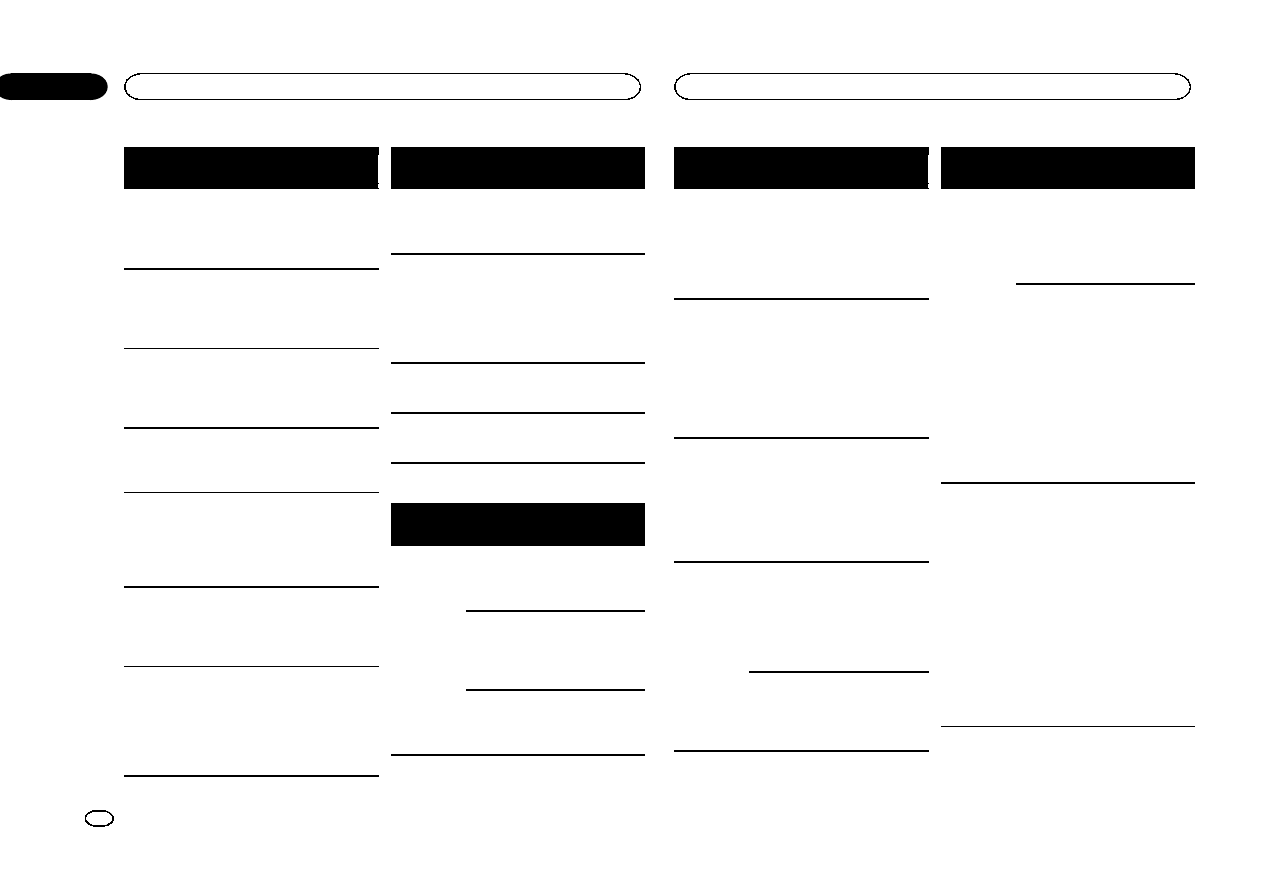
Message Cause Action (Refer-
ence page)
Protect All the files on
the inserted
disc are em-
bedded with
DRM.
Replace the disc.
Skipped The inserted
disc contains
DRM protected
files.
Play an audio file
not embedded
with Windows
MediaäDRM 9/
10.
TEMP The tempera-
ture of the unit
is outside the
normal operat-
ing range.
Wait until the unit
returns to a tem-
perature within
the normal oper-
ating limits.
This DivX
rental has
expired.
The inserted
disc contains
expired DivX
VOD content.
Select a file that
can be played.
Video resolu-
tion not sup-
ported
The inserted
disc contains a
high definition
DivX/MPEG-1/
MPEG-2/
MPEG-4 file.
Select a file that
can be played.
It is not pos-
sible to write
it in the
flash.
This unit’s flash
memory used
as the tempo-
rary storage
area is full.
Select a file that
can be played.
Your device
is not au-
thorized to
play this
DivX pro-
tected video.
This unit’s DivX
registration
code has not
been authorized
by the DivX
VOD contents
provider.
Register this unit
to the DivX VOD
contents provider.
Message Cause Action (Refer-
ence page)
Unplayable
File
This type of file
cannot be
played on this
unit.
Select a file that
can be played.
Format Read Sometimes
there is a delay
between the
start of playback
and when you
start to hear any
sound.
Wait until the
message disap-
pears and you
hear sound.
Video frame
rate not sup-
ported
DivX file’s frame
rate is more
than 30 fps.
Select a file that
can be played.
Audio For-
mat not sup-
ported
This type of file
is not supported
on this unit.
Select a file that
can be played.
External storage device (USB)
Message Cause Action (Refer-
ence page)
Unplayable
File
This type of file
cannot be
played on this
unit.
Select a file that
can be played.
There are no
songs.
Transfer the audio
files to the USB
portable audio
player/USB mem-
ory and connect.
Security for the
connected USB
memory is en-
abled.
Follow the USB
memory instruc-
tions to disable
security.
Message Cause Action (Refer-
ence page)
Format Read Sometimes
there is a delay
between the
start of playback
and when you
start to hear any
sound.
Wait until the
message disap-
pears and you
hear sound.
Skipped The connected
USB portable
audio player/
USB memory
contains WMA
files that are
protected by
Windows Me-
diaäDRM 9/10.
Play an audio file
not embedded
with Windows
MediaäDRM 9/
10.
Protect All the files on
the connected
USB portable
audio player/
USB memory
are protected by
Windows Media
DRM 9/10.
Transfer audio
files not protected
by Windows
Media DRM 9/10
to the USB port-
able audio player/
USB memory and
connect.
Incompatible
USB
The USB device
connected to is
not supported
by this unit.
Connect a USB
portable audio
player or USB
memory that is
USB Mass Stor-
age Class compli-
ant.
The USB device
is not formatted
with FAT12,
FAT16 or FAT32.
The connected
USB device
should be format-
ted with FAT12,
FAT16 or FAT32.
Message Cause Action (Refer-
ence page)
Check USB The USB con-
nector or USB
cable has short-
circuited.
Check that the
USB connector or
USB cable is not
caught in some-
thing or dam-
aged.
The connected
USB storage de-
vice consumes
more than maxi-
mum allowable
current.
Disconnect the
USB portable
audio player/USB
memory and do
not use it. Turn
the ignition
switch to OFF,
then to ACC or
ON and then con-
nect a compliant
USB portable
audio player/USB
memory.
Error-02-9X/-
DX
Communication
failed.
Perform one of
the following op-
erations.
–Turn the ignition
switch OFF and
back ON.
–Disconnect the
USB portable
audio player/USB
memory.
–Change to a dif-
ferent source.
Then, return to
the USB portable
audio player/USB
memory.
Additional information
54
Appendix
Additional information
En
<CRD4703-A/N>54
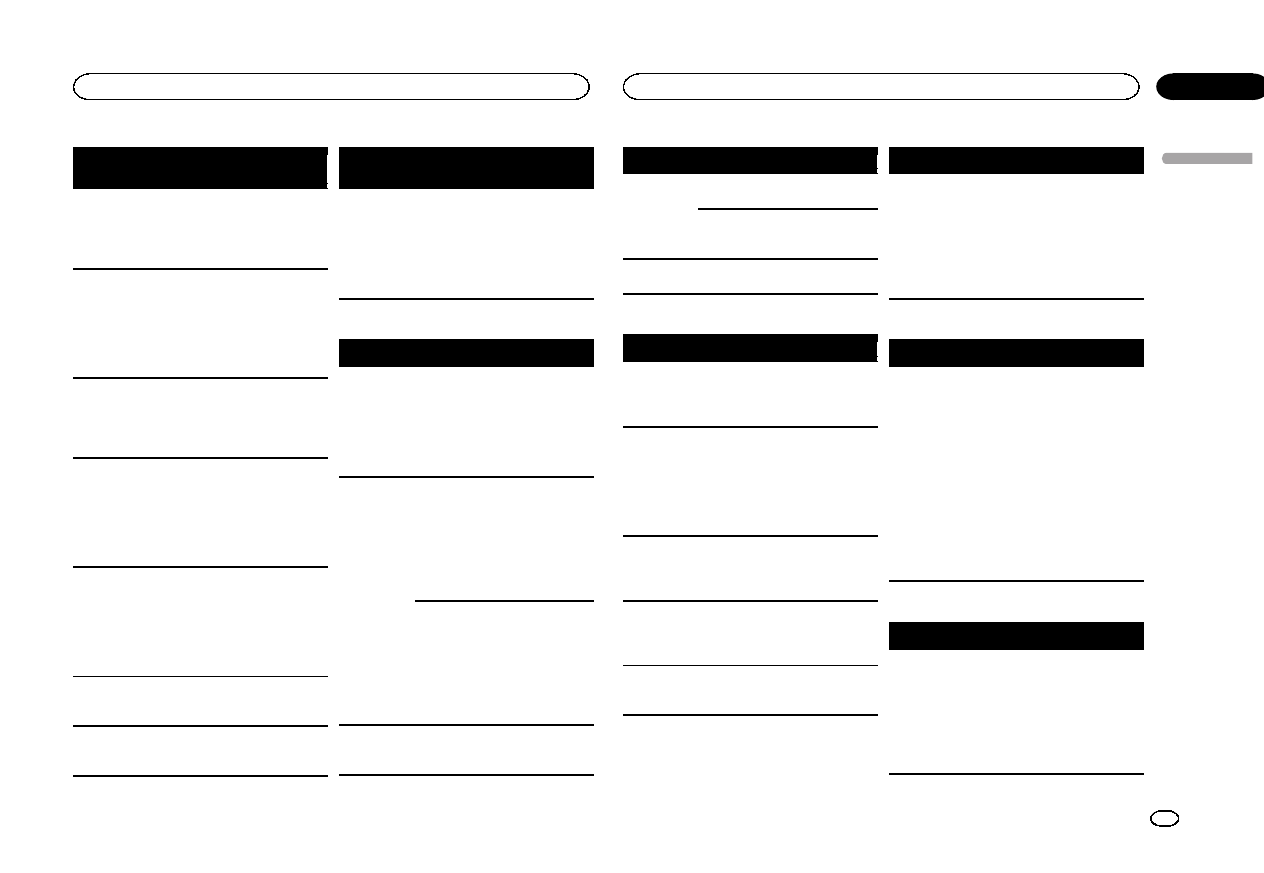
Message Cause Action (Refer-
ence page)
This DivX
rental has
expired.
The inserted ex-
ternal storage
device contains
expired DivX
VOD content.
Select a file that
can be played.
Video resolu-
tion not sup-
ported
The inserted ex-
ternal storage
device contains
a high definition
DivX/MPEG-1/
MPEG-2/
MPEG-4 file.
Select a file that
can be played.
It is not pos-
sible to write
it in the
flash.
This unit’s flash
memory used
as the tempo-
rary storage
area is full.
Select a file that
can be played.
Your device
is not au-
thorized to
play this
DivX pro-
tected video.
This unit’s DivX
registration
code has not
been authorized
by the DivX
VOD contents
provider.
Register this unit
to the DivX VOD
contents provider.
Format Read Sometimes
there is a delay
between the
start of playback
and when you
start to hear any
sound.
Wait until the
message disap-
pears and you
hear sound.
Video frame
rate not sup-
ported
DivX file’s frame
rate is more
than 30 fps.
Select a file that
can be played.
Audio For-
mat not sup-
ported
This type of file
is not supported
on this unit.
Select a file that
can be played.
Message Cause Action (Refer-
ence page)
Creating the
Database
has failed.
The mode was
switched to
video or JPEG
image display
while the data-
base was being
created.
Create the data-
base again. (Page
24)
iPod
Message Cause Action
Format Read Sometimes
there is a delay
between the
start of playback
and when you
start to hear any
sound.
Wait until the
message disap-
pears and you
hear sound.
Error-02-6X/-
9X/-DX
Communication
failed.
Disconnect the
cable from the
iPod. Once the
iPod’s main
menu is dis-
played, reconnect
the iPod and reset
it.
iPod failure. Disconnect the
cable from the
iPod. Once the
iPod’s main
menu is dis-
played, reconnect
the iPod and reset
it.
Error-02-67 The iPod firm-
ware version is
old.
Update the iPod
version.
Message Cause Action
Stop There are no
songs.
Transfer songs to
the iPod.
There are no
songs in the
current list.
Select a list that
contains songs.
Not Found No related
songs.
Transfer songs to
the iPod.
iTunes tagging
Message Cause Action
iPod full.
Tags not
transferred.
Memory used
for tag informa-
tion on the iPod
is full.
Sync the iPod
with iTunes and
clean up the
tagged playlist.
Memory full.
Tags not
stored. Con-
nect iPod.
This unit’s flash
memory used
as the tempo-
rary storage
area is full.
The tag informa-
tion on this unit is
transferred to the
iPod automati-
cally when an
iPod is con-
nected.
Tag transfer
failed. Re-
connect your
iPod.
This unit’s tag
information
cannot transfer
to the iPod.
Check the iPod
and try again.
Tag store
failed.
Tag information
cannot be
stored in this
unit.
Try again.
Error-8D Built-in FLASH
ROM encoun-
tered an error
Turn the ignition
OFF or ON.
Message Cause Action
Already
stored
This tag infor-
mation is al-
ready stored in
memory.
Tag information
can only be saved
once for any
given song. Tag
information can-
not be saved for
the same song
more than once.
Bluetooth
Message Cause Action
Error-10 The power failed
for the
Bluetooth mod-
ule of this unit.
Turn the ignition
switch OFF and
then to ACC or
ON.
If the error mes-
sage is still dis-
played after
performing the
above action,
please contact
your dealer or an
authorized
Pioneer Service
Station.
Pandoraâ
Message Cause Action
Error-19 Communication
failed.
Disconnect the
cable from the
iPod. Once the
iPod’s main
menu is dis-
played, reconnect
the iPod and reset
it.
English
Additional information
55
Appendix
Additional information
En
<CRD4703-A/N>55
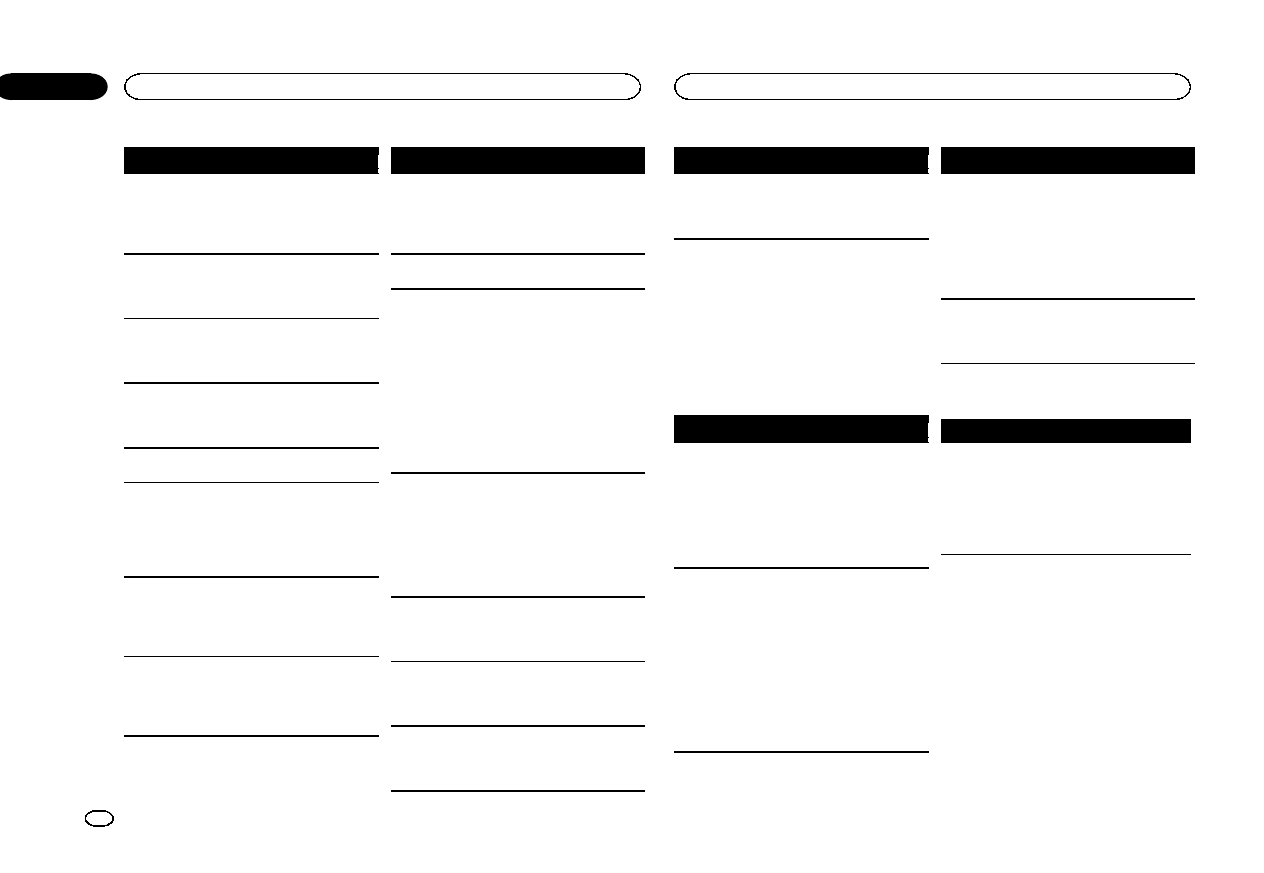
Message Cause Action
Start up the
Pandora Ap-
plication
from your
Device.
The Pandora ap-
plication has
not started run-
ning yet.
Start up the
Pandora applica-
tion from your
iPhone.
Unable to
save thumb
rating. Try
again later.
Unable to save
thumb rating.
Try again later.
Unable to
save Book-
mark. Try
again later.
Unable to save
Bookmark.
Try again later.
Pandora sys-
tem mainte-
nance. Try
again later.
Pandora system
is undergoing
maintenance.
Try again later.
Skip limit
reached.
Skip limit
reached.
Do not exceed the
skip limit.
This version
of the
Pandora Ap-
plication is
not sup-
ported.
This version of
the Pandora ap-
plication is not
supported.
Connect an
iPhone that has a
compatible ver-
sion of the
Pandora applica-
tion installed.
Check Device Device error
message dis-
played in the
Pandora appli-
cation.
Please check your
iPhone.
Pandora is
unable to
play music.
Please see
your Device.
Unable to play
music from
Pandora.
Please check your
iPhone.
Message Cause Action
Create sta-
tion within
the Pandora
Application
on Device.
No station
found.
Create a station
in the Pandora
application on
your iPhone.
No Active
Station
No station se-
lected.
Select a station.
Communica-
tion error oc-
cured. Please
reconnect
your device.
If there is no
ACK after 10 at-
tempted retries
at 750 ms, the
accessory
should assume
that communi-
cation is inter-
rupted and
disconnect
from
PandoraLink.
Please reconnect
your iPhone and
try again.
Device has
not been
registered.
Go to
Bluetooth
Connection
Menu to
register.
No Bluetooth
device found.
Follow the in-
structions that ap-
pear on the
screen.
BT error.
Press BAND
key to retry.
Bluetooth con-
nection failed.
Follow the in-
structions that ap-
pear on the
screen.
Start up
Pandora.
Press BAND
key to retry.
Connection to
the Pandora ap-
plication failed.
Follow the in-
structions that ap-
pear on the
screen.
Check
Pandora.
Press BAND
key to retry.
Connection to
the Pandora ap-
plication failed.
Follow the in-
structions that ap-
pear on the
screen.
Message Cause Action
Disconnect-
ed.Press
BAND key to
retry.
Bluetooth con-
nection lost.
Follow the in-
structions that ap-
pear on the
screen.
Understanding auto EQ error
messages
When correct measurement of the car’s interior
acoustic characteristics is not possible using
auto EQ, an error message may appear on the
display. In such cases, refer to the table below to
see what the problem is and how it may be cor-
rected. After checking, try again.
Message Cause Action
Please con-
nect the mi-
crophone for
measure-
ment. When
finished,
please push
HOME key.
The microphone
is not con-
nected.
Plug the optional
microphone se-
curely into the
jack.
Error. Please
check xxxx
speaker.
The microphone
cannot pick up
the measuring
tone of a speak-
er.
!Confirm that
the speakers are
connected cor-
rectly.
!Correct the
input level setting
of the power amp
connected to the
speakers.
!Plug the micro-
phone securely
into the jack.
Message Cause Action
Error. Please
check noise.
The surround-
ing noise level
is too high.
!Stop your car in
a place that is
quiet, and switch
off the engine, air
conditioner and
heater.
!Set the micro-
phone correctly.
Error. Please
check bat-
tery.
Power is not
being supplied
from the battery
to this unit.
!Connect the
battery correctly.
!Check the bat-
tery voltage.
Understanding messages
Messages Translation
Screen image may
appear reversed.
Pioneer recommends
the use of a camera
which outputs mirror-
reversed images. Oth-
erwise, the screen
image will appear re-
versed.
Additional information
56
Appendix
Additional information
En
<CRD4703-A/N>56
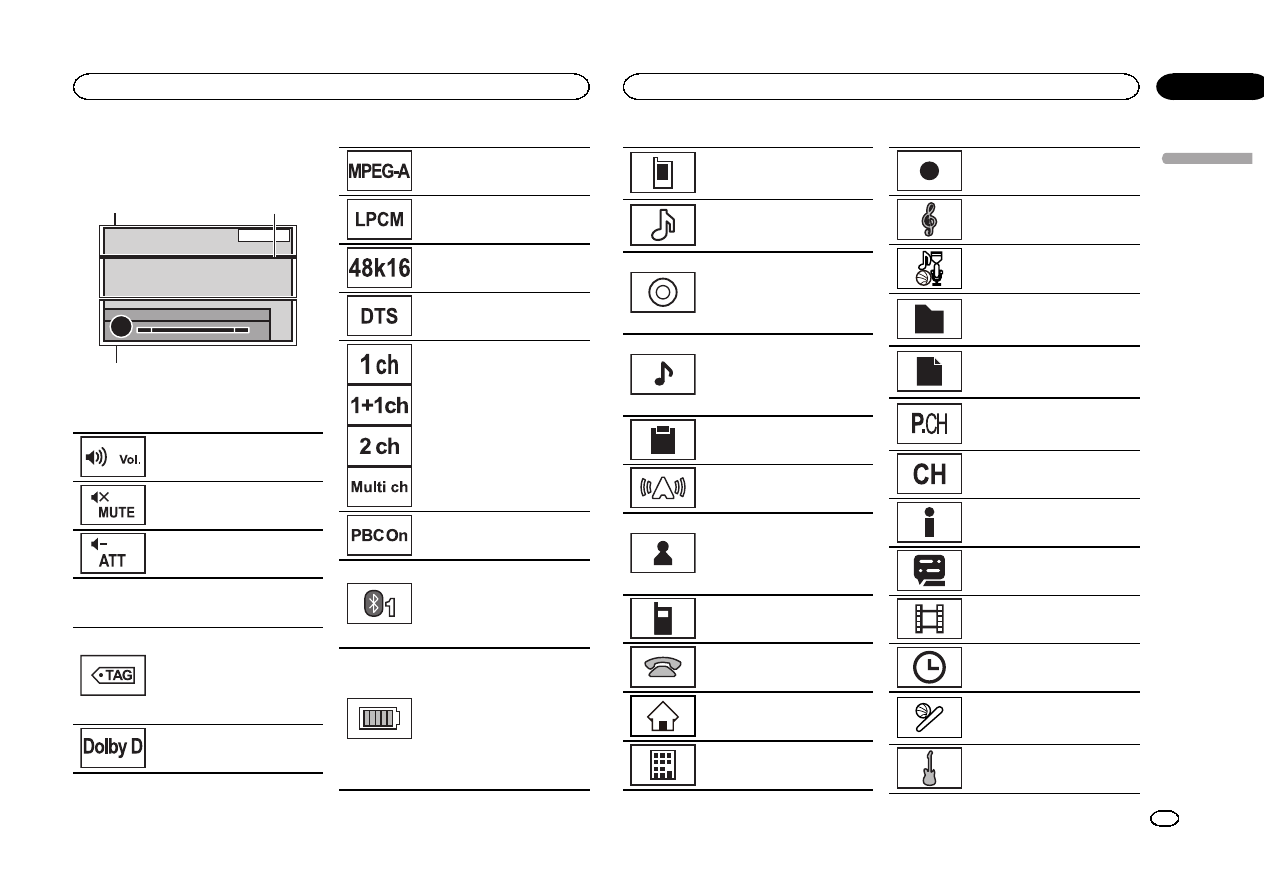
Indicator list
Area 1 Area 2
Area 3
Area 1
Indicates that the volume is ad-
justed.
Indicates that the mute function
is on.
Indicates that the sound is atte-
nuated.
Area 2
Shows when downloadable song
information (tag) from a radio sta-
tion is received.
Disabled while song information
(tag) from an HD Radio station is
being saved to this unit.
Indicates that the digital format is
Dolby Digital.
Indicates that the digital format is
MPEG Audio.
Indicates that the digital format is
Linear PCM.
Indicates the sampling fre-
quency.
Indicates that the digital format is
DTS.
Indicates the audio channel.
Indicates that a disc with PBC On
is being played.
!Indicates that a cellular
phone is connected.
!Indicates that an incoming
call has been received and
has not been checked yet.
Indicates the battery strength of
the cellular phone.
!The level shown on the indica-
tor may differ from the actual
battery strength.
!If the battery strength is not
available, nothing is displayed
in the battery strength indica-
tor area.
Indicates that the connected
Bluetooth device only supports
Bluetooth telephone.
Indicates that the connected
Bluetooth device only supports
Bluetooth audio.
Show the album title when receiv-
ing the tag information.
Shows the album title of the song
currently being played for MP3/
WMA/AAC/WAV files.
Shows the song title when receiv-
ing the tag information.
Shows the song title of the song
currently being played for MP3/
WMA/AAC/WAV files.
Shows the comment currently
being played.
Shows the station name currently
tuned in to.
Shows the artist name when re-
ceiving the tag information.
Shows the artist name of the ar-
tist currently being played for
MP3/WMA/AAC/WAV files.
Shows cellular phone informa-
tion.
Shows general phone informa-
tion.
Shows home phone information.
Shows office phone information.
Shows other phone information.
Shows the composer name.
Shows the category name.
Shows the folder name of the
folder containing the MP3/WMA/
AAC file currently being played.
Shows the file name of the MP3/
WMA/AAC file currently being
played.
Shows the preset number of the
station currently being tuned in
to.
Shows the channel currently
being tuned in to.
Shows SiriusXM information.
Shows the title number currently
being played.
Shows the chapter number cur-
rently being played.
Shows the replay time currently
being played.
Shows when the game alert func-
tion is on while receiving
SiriusXM stations.
Shows the genre of the track/
song currently being played.
English
Additional information
57
Appendix
Additional information
En
<CRD4703-A/N>57
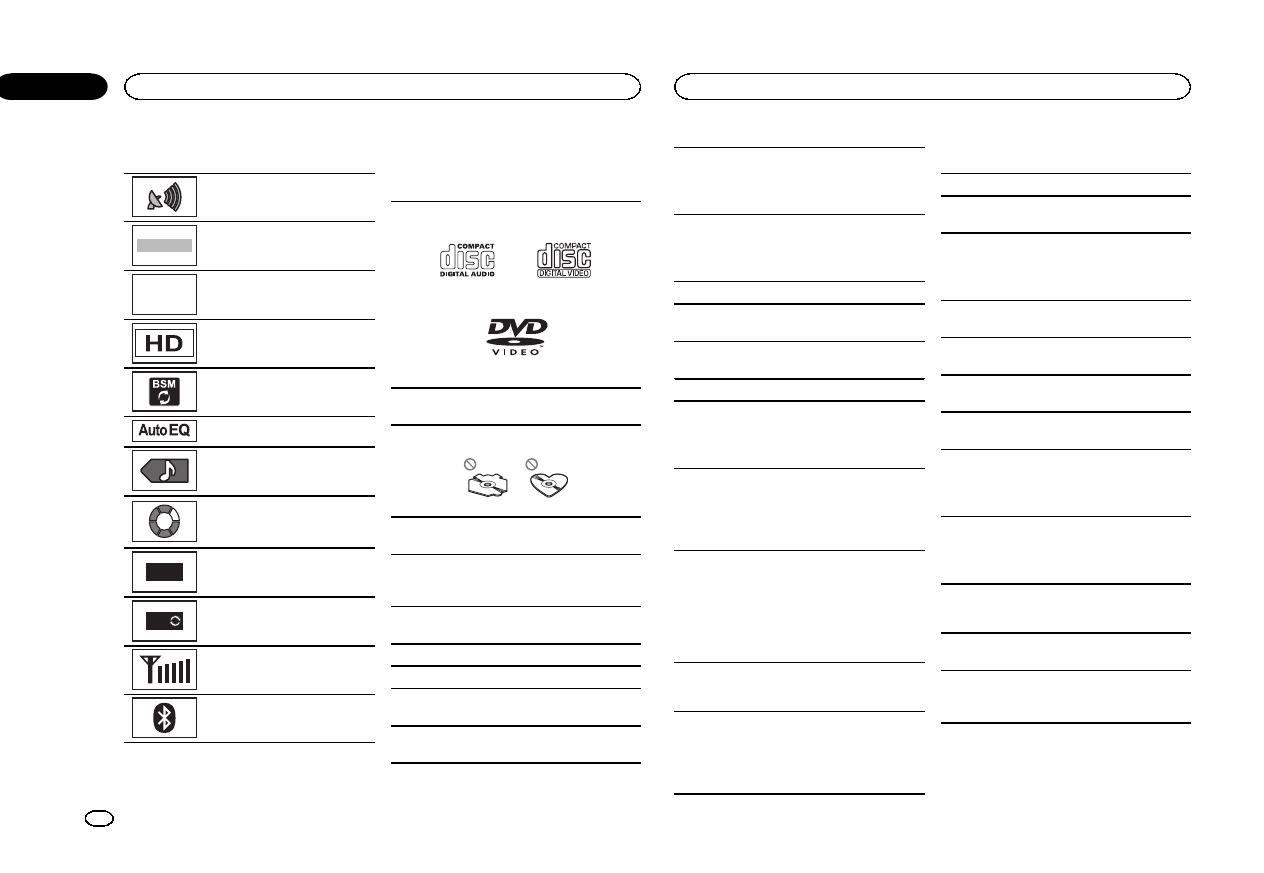
Area 3
Shows when radio signal is re-
ceived.
ANALOG
Shows when analog audio of HD
Radio signal is received.
DIGITAL Shows when digital audio of HD
Radio signal is received.
Shows when HD Radio station in-
formation is received.
Touch to turn BSM on.
Indicates that Auto EQ is on.
Shows when this unit has the
song information (tag).
Indicates that the unit is currently
processing an operation such as
search.
DB Shows when creating the data-
base in Music browse mode.
DB Shows when saving the database
in Music browse mode.
Indicates the signal strength of
the cellular phone.
Indicates that a Bluetooth tele-
phone is connected.
Handling guidelines
Discs and player
Use discs featuring any of the following logos.
Use 12-cm discs. Do not use 8-cm discs or an
adapter for 8-cm discs.
Use only conventional, fully circular discs. Do not
use shaped discs.
Do not insert anything other than a DVD-R/RW or
CD-R/RW into the disc loading slot.
Do not use cracked, chipped, warped, or other-
wise damaged discs as they may damage the play-
er.
Unfinalized CD-R/RW discs cannot be played
back.
Do not touch the recorded surface of the discs.
Store discs in their cases when not in use.
Do not attach labels, write on or apply chemicals
to the surface of the discs.
To clean a disc, wipe the disc with a soft cloth out-
ward from the center.
Condensation may temporarily impair the player’s
performance. Let it rest for about one hour to ad-
just to a warmer temperature. Also, wipe any
damp discs off with a soft cloth.
Playback of discs may not be possible because of
disc characteristics, disc format, recorded applica-
tion, playback environment, storage conditions,
and so on.
Road shocks may interrupt disc playback.
Certain functions may not be available for some
DVD video discs.
It may not be possible to play back some DVD
video discs.
It is not possible to play back DVD-RAM discs.
This unit is not compatible with discs recorded in
AVCHD (Advanced Video Codec High Definition)
format. Do not insert AVCHD discs as you may not
be able to eject the disc.
When using discs that can be printed on label sur-
faces, check the instructions and the warnings of
the discs. Depending on the discs, inserting and
ejecting may not be possible. Using such discs
may result in damage to this equipment.
Do not attach commercially available labels or
other materials to the discs.
!The discs may warp making the disc unplay-
able.
!The labels may come off during playback and
prevent ejection of the discs, which may result
in damage to the equipment.
External storage device (USB)
Depending on the external storage device (USB),
the following problems may occur.
!Operations may vary.
!The storage device may not be recognized.
!Files may not be played back properly.
USB storage device
Connections via USB hub are not supported.
Do not connect anything other than a USB stor-
age device.
Firmly secure the USB storage device when driv-
ing. Do not let the USB storage device fall onto the
floor, where it may become jammed under the
brake or accelerator pedal.
Depending on the USB storage device, the device
may cause noise to occur in the radio.
Copyright protected files that are stored in the
USB devices cannot be played back.
You cannot connect a USB portable audio player/
USB memory to this unit via USB hub.
Partitioned USB memory is not compatible with
this unit.
Depending on the kind of USB portable audio
player/USB memory you use, the device may not
be recognized or audio files may not be played
back properly.
Do not leave the USB portable audio player/USB
memory in direct sunlight for extended amounts
of time. Doing so may cause the device to mal-
function from the extreme rise in temperature.
iPod
To ensure proper operation, connect the dock con-
nector cable from the iPod directly to this unit.
Firmly secure the iPod when driving. Do not let the
iPod fall onto the floor, where it may become
jammed under the brake or accelerator pedal.
Additional information
58
Appendix
Additional information
En
<CRD4703-A/N>58

About iPod settings
!When an iPod is connected, this unit changes
the EQ (equalizer) setting of the iPod to off in
order to optimize the acoustics. When you dis-
connect the iPod, the EQ returns to the original
setting.
!You cannot set Repeat to off on the iPod when
using this unit. Repeat is automatically
changed to All when the iPod is connected to
this unit.
Incompatible text saved on the iPod will not be dis-
played by the unit.
DVD-R/RW discs
Unfinalized DVD-R/RW discs which have been re-
corded in the Video format (video mode) cannot
be played back.
Playback of DVD-R/RW discs may not be possible,
due to disc characteristics, scratches or dirt on
the disc, or dirt, condensation, etc. on the lens of
this unit.
Depending on the application settings and the en-
vironment, playback of discs recorded on a per-
sonal computer may not be possible. (For details,
contact the manufacturer of the application.)
CD-R/RW discs
When CD-R/RW discs are used, playback is possi-
ble only for discs which have been finalized.
Playback of CD-R/RW discs recorded on a music
CD recorder or a personal computer may not be
possible due to disc characteristics, scratches or
dirt on the disc, or dirt, condensation, etc., on the
lens of this unit.
Depending on the application settings and the en-
vironment, playback of discs recorded on a per-
sonal computer may not be possible. (For details,
contact the manufacturer of the application.)
Playback of CD-R/RW discs may become impossi-
ble in case of direct exposure to sunlight, high
temperatures, or the storage conditions in the ve-
hicle.
Titles and other text information recorded on a
CD-R/RW disc may not be displayed by this unit
(in the case of audio data (CD-DA)).
DualDiscs
DualDiscs are two-sided discs that have a record-
able CD for audio on one side and a recordable
DVD for video on the other.
Playback of the DVD side is possible with this unit.
However, since the CD side of DualDiscs is not
physically compatible with the general CD stand-
ard, it may not be possible to play the CD side with
this unit.
Frequent loading and ejecting of a DualDisc may
result in scratches on the disc. Serious scratches
can lead to playback problems on this unit. In
some cases, a DualDisc may become stuck in the
disc loading slot and will not eject. To prevent this,
we recommend you refrain from using DualDisc
with this unit.
Please refer to the information from the disc man-
ufacturer for more detailed information about
DualDiscs.
JPEG picture files
JPEG is short for Joint Photographic Experts
Group and refers to a still image compression
technology standard.
Files are compatible with Baseline JPEG and EXIF
2.1 still images up to a resolution of 8 192 × 7 680.
(EXIF format is used most commonly with digital
still cameras.)
Playback of EXIF format files that were processed
by a personal computer may not be possible.
There is no progressive JPEG compatibility.
DivX video files
Depending on the composition of the file informa-
tion, such as the number of audio streams or file
size, there may be a slight delay when playing
back discs.
Some special operations may be prohibited due to
the composition of the DivX files.
Only DivX files downloaded from a DivX partner
site are guarantee for proper operation. Unauthor-
ized DivX files may not operate properly.
DRM rental files cannot be operated until play-
back is started.
Recommended file size: 2 GB or less with a trans-
mission rate of 2 Mbps or less.
The ID code of this unit must be registered to a
DivX VOD provider in order to playback DivX VOD
files. For information on ID codes, refer to Display-
ing the DivXâVOD registration code on page 36.
For more details about DivX, visit the following
site:
http://www.divx.com/
MPEG-1/MPEG-2/MPEG-4 video files
Elapsed playback time may not be displayed cor-
rectly.
Important
!When naming a JPEG image file, add the
corresponding file name extension (.jpg,
.jpeg or .jpe).
!This unit plays back files with these file name
extensions (.jpg, .jpeg or .jpe) as a JPEG
image file. To prevent malfunctions, do not
use these extensions for files other than
JPEG image files.
Compressed audio
compatibility (USB)
WAV
File extension: .wav
Quantization bits: 8 and 16 (LPCM), 4 (MS
ADPCM)
Sampling frequency: 16 kHz to 48 kHz (LPCM),
22.05 kHz and 44.1 kHz (MS ADPCM)
Compressed audio
compatibility (disc, USB)
WMA
File extension: .wma
Bit rate: 48 kbps to 320 kbps (CBR), VBR
Sampling frequency: 32 kHz to 48 kHz
Windows MediaäAudio Professional, Lossless,
Voice/DRM Stream/Stream with video: Not com-
patible
MP3
File extension: .mp3
Bit rate: 8 kbps to 320 kbps (CBR), VBR
Sampling frequency: 8kHz to 48 kHz (32 kHz,
44.1 kHz, 48 kHz for emphasis)
Compatible ID3 tag version: 1.0, 1.1, 2.2, 2.3, 2.4
(ID3 tag Version 2.x is given priority over Version
1.x.)
M3u playlist: Not compatible
MP3i (MP3 interactive), mp3 PRO: Not compatible
English
Additional information
59
Appendix
Additional information
En
<CRD4703-A/N>59
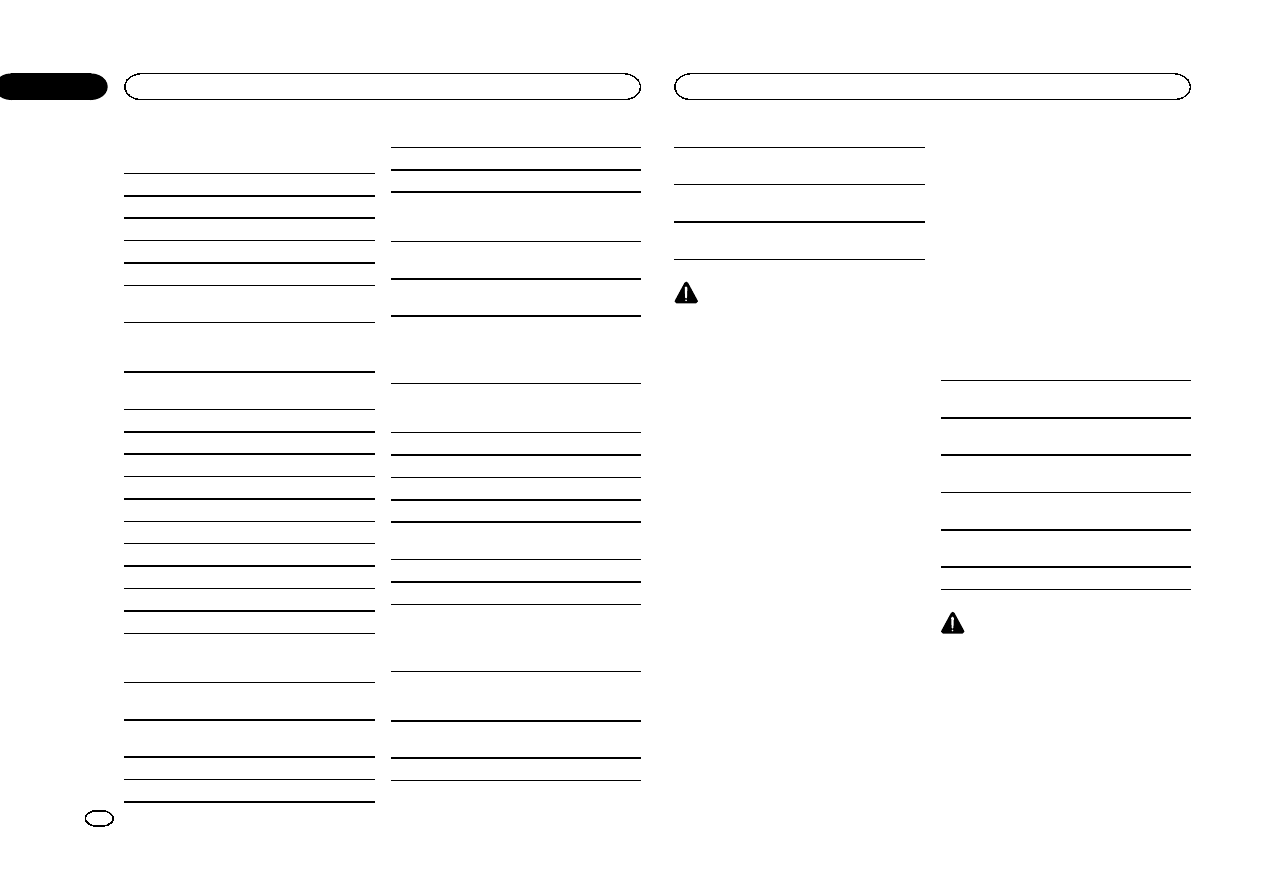
AAC
Compatible format: AAC encoded by iTunes
File extension: .m4a
Sampling frequency: 11.025 kHz to 48 kHz
Bit rate: 16 kbps to 320 kbps
Apple Lossless: Not compatible
AAC file bought from the iTunes Store (.m4p file
extension): Not compatible
DivX compatibility
Compatible format: DivX video format imple-
mented in relation to DivX standards
File extensions: .avi or .divx
DivX Ultra format: Not compatible
DivX HD format: Not compatible
DivX files without video data: Not compatible
DivX plus: Not compatible
Compatible audio codec: MP2, MP3, Dolby Digital
LPCM: Compatible
Bit rate: 8 kbps to 320 kbps (CBR), VBR
Sampling frequency: 8 kHz to 48 kHz
Compatible external subtitle file extension: .srt
MPEG-1/MPEG-2/MPEG-4 video
File extensions: .mpg or .mpeg (MPEG-1/MPEG-2),
.avi (MPEG-4)
Compatible audio codec: MP2 (MPEG-1/MPEG-2),
MP2, MP3, Dolby Digital (MPEG-4)
H.264 (MPEG-4AVC): Compatible
LPCM: Not compatible
Bit rate: 8 kbps to 320 kbps (CBR), VBR
Sampling frequency: 8 kHz to 48 kHz
Supplemental information
Some characters in a file name (including the file
extension) or a folder name may not be displayed.
This unit may not work properly depending on the
application used to encode WMA files.
There may be a slight delay at the start of playback
of audio files embedded with image data or audio
files stored on a USB storage device that has nu-
merous folder hierarchies.
Disc (CD/DVD)
Playable folders: up to 99 for CD-R/RW
Playable folders: up to 700 for DVD-R/RW
Playable files: up to 999 for CD-R/RW
Playable files: up to 3 500 for DVD-R/RW
File system: ISO 9660 Level 1 and 2, Romeo, Joliet,
UDF 1.02 (DVD-R/RW)
Multi-session playback: Compatible
Packet write data transfer: Not compatible
Regardless of the length of blank sections be-
tween the songs from the original recording, com-
pressed audio discs play with a short pause
between songs.
External storage device (USB)
Playable folders: up to 1 500 (up to 700 for DivX/
MPEG-1/MPEG-2/MPEG-4)
Playable files: up to 15 000
Playback of copyright-protected files: Not compati-
ble
Partitioned external storage device (USB): Only the
first playable partition can be played.
There is no compatibility for Multi Media Cards
(MMC).
CAUTION
!Pioneer accepts no responsibility for data
lost on the USB memory/USB portable audio
player even if that data is lost while using
this unit.
!Pioneer cannot guarantee compatibility with
all USB mass storage devices and assumes
no responsibility for any loss of data on
media players, smart phones, or other devi-
ces while using this product.
!Do not leave the discs/external storage de-
vice (USB) or iPod in places with high tem-
peratures.
iPod compatibility
This unit supports only the following iPod mod-
els. Supported iPod software versions are shown
below. Older versions may not be supported.
Made for
!iPod touch 4th generation (software version
5.1.1)
!iPod touch 3rd generation (software version
5.1.1)
!iPod touch 2nd generation (software version
4.2.1)
!iPod touch 1st generation (software version
3.1.3)
!iPod classic 160GB (software version 2.0.4)
!iPod classic 120GB (software version 2.0.1)
!iPod classic (software version 1.1.2)
!iPod with video (software version 1.3)
!iPod nano 6th generation (software version
1.2)
!iPod nano 5th generation (software version
1.0.2)
!iPod nano 4th generation (software version
1.0.4)
!iPod nano 3rd generation (software version
1.1.3)
!iPod nano 2nd generation (software version
1.1.3)
!iPod nano 1st generation (software version
1.3.1)
!iPhone 4S (software version 5.1.1)
!iPhone 4 (software version 5.1.1)
!iPhone 3GS (software version 5.1.1)
!iPhone 3G (software version 4.2.1)
!iPhone (software version 3.1.3)
Depending on the generation or version of the
iPod, some functions may not be available.
Operations may vary depending on the software
version of iPod.
When using an iPod, an iPod Dock Connector to
USB Cable is required.
When you use Pioneer CD-IU51V/CD-IU201V inter-
face cable, consult your dealer for details.
About the file/format compatibility, refer to the
iPod manuals.
Audiobook, Podcast: Compatible
CAUTION
Pioneer accepts no responsibility for data lost
on the iPod, even if that data is lost while this
unit is used.
About iTunes tagging
This function can be performed with the following
iPod models.
—iPod touch 4th generation
—iPod touch 3rd generation
—iPod touch 2nd generation
Additional information
60
Appendix
Additional information
En
<CRD4703-A/N>60
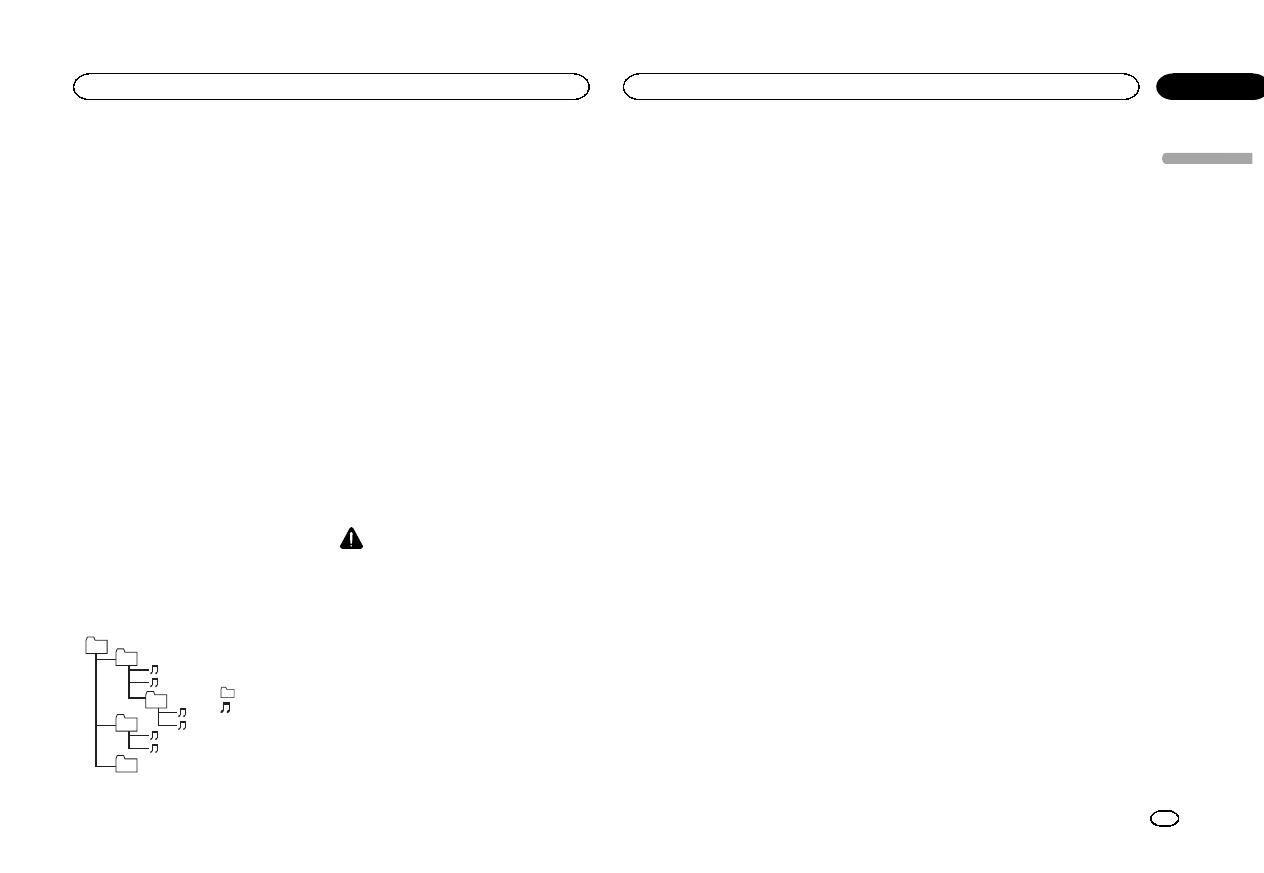
—iPod touch 1st generation
—iPod classic 160GB
—iPod classic 120GB
—iPod classic
—iPod with video
—iPod nano 6th generation
—iPod nano 5th generation
—iPod nano 4th generation
—iPod nano 3rd generation
—iPhone 4S
—iPhone 4
—iPhone 3GS
—iPhone 3G
—iPhone
The song information (tag) can be saved from
the broadcasting station to your iPod. The songs
will show up in a playlist called “Tagged playlist”
in iTunes the next time you sync your iPod. Then
you can directly buy the songs you want from
the iTunes Store.
The tagged songs and the song that you can buy
from the iTunes Store may be different. Make
sure to confirm the song before you make the
purchase.
If you cannot use this function normally, update
your iPod firmware.
Sequence of audio files
The user cannot assign folder numbers and
specify playback sequences with this unit.
Example of a hierarchy
Level 1 Level 2 Level 3 Level 4
01
02
03
04
05
: Folder
: Compressed
audio file
01 to 05: Folder
number
1to 6: Playback
sequence
Disc
Folder selection sequence or other operation
may differ depending on the encoding or writing
software.
External storage device (USB)
The playback sequence is the same as the re-
corded sequence in the external storage device
(USB).
To specify the playback sequence, the following
method is recommended.
1Create a file name that includes numbers
that specify the playback sequence (e.g.,
001xxx.mp3 and 099yyy.mp3).
2Put those files into a folder.
3Save the folder that contains the files to the
external storage device (USB).
However, depending on the system environment,
you may not be able to specify the playback se-
quence.
For USB portable audio players, the sequence is
different and depends on the player.
Using the display correctly
CAUTION
!If liquid or foreign matter should get inside
this unit, turn off the power immediately and
consult your dealer or the nearest authorized
PIONEER Service Station. Do not use the
unit in this condition because doing so may
result in fire, electric shock, or other failure.
!If you notice smoke, a strange noise or smell,
or any other abnormal signs from the display,
turn off the power immediately and consult
your dealer or the nearest authorized
PIONEER Service Station. Using this unit in
this condition may result in permanent dam-
age to the system.
!Do not disassemble or modify this unit, as
there are high-voltage components inside
which may cause electric shock. Be sure to
consult your dealer or the nearest authorized
PIONEER Service Station for internal inspec-
tion, adjustments, or repairs.
Handling the display
!Never touch the screen with anything be-
sides your finger when operating the touch
panel function. The screen can scratch
easily.
!When the display is subjected to direct sun-
light for a long period of time, it will become
very hot resulting in possible damage to the
LCD screen. You should avoid exposing the
display unit to direct sunlight as much as
possible.
!The display should be used within the tem-
perature range of 14 °F to 140 °F.
At temperatures higher or lower than this op-
erating temperature range, the display may
not operate normally.
!The LCD screen is exposed in order to in-
crease its visibility within the vehicle. Do not
press it strongly on it as this may damage it.
!Do not push the LCD screen forcefully as
this may scratch it.
Liquid crystal display (LCD) screen
!Heat from the heater may damage the LCD
screen, and cool air from the cooler may
cause moisture to form inside the display re-
sulting in possible damage.
!Small black dots or white dots (bright dots)
may appear on the LCD screen. These are
due to the characteristics of the LCD screen
and do not indicate a malfunction.
!When using a cellular phone, keep the an-
tenna away from the display to prevent dis-
ruption of the video image by the
appearance of spots, colored stripes, etc.
LED (light-emitting diode) backlight
!At low temperatures, using the LED backlight
may increase image lag and degrade the
image quality due to the characteristics of
the LCD screen. Image quality will improve
with an increase in temperature.
!To protect the LED backlight, the display will
darken in the following environments:
—In the direct sunlight
—Near the heater vent
!The product lifetime of the LED backlight is
more than 10 000 hours. However, it may de-
crease if used in high temperatures.
!If the LED backlight reaches the end of its
product lifetime, the screen will become dark
and the image will no longer be projected. In
such cases, please consult your dealer or the
nearest authorized PIONEER Service Station.
Keeping the display in good
condition
!When removing dust from the screen or
cleaning the display, first turn the system
power off, then wipe with a soft dry cloth.
!When wiping the screen, take care not to
scratch the surface. Do not use harsh or
abrasive chemical cleaners.
Bluetooth profiles
In order to use Bluetooth wireless technology,
devices must be able to interpret certain pro-
files. This unit is compatible with the following
profiles.
!GAP (Generic Access Profile)
!SDP (Service Discovery Protocol)
!OPP (Object Push Profile)
!HFP (Hands Free Profile)
!HSP (Head Set Profile)
!PBAP (Phone Book Access Profile)
!A2DP (Advanced Audio Distribution Profile)
English
Additional information
61
Appendix
Additional information
En
<CRD4703-A/N>61
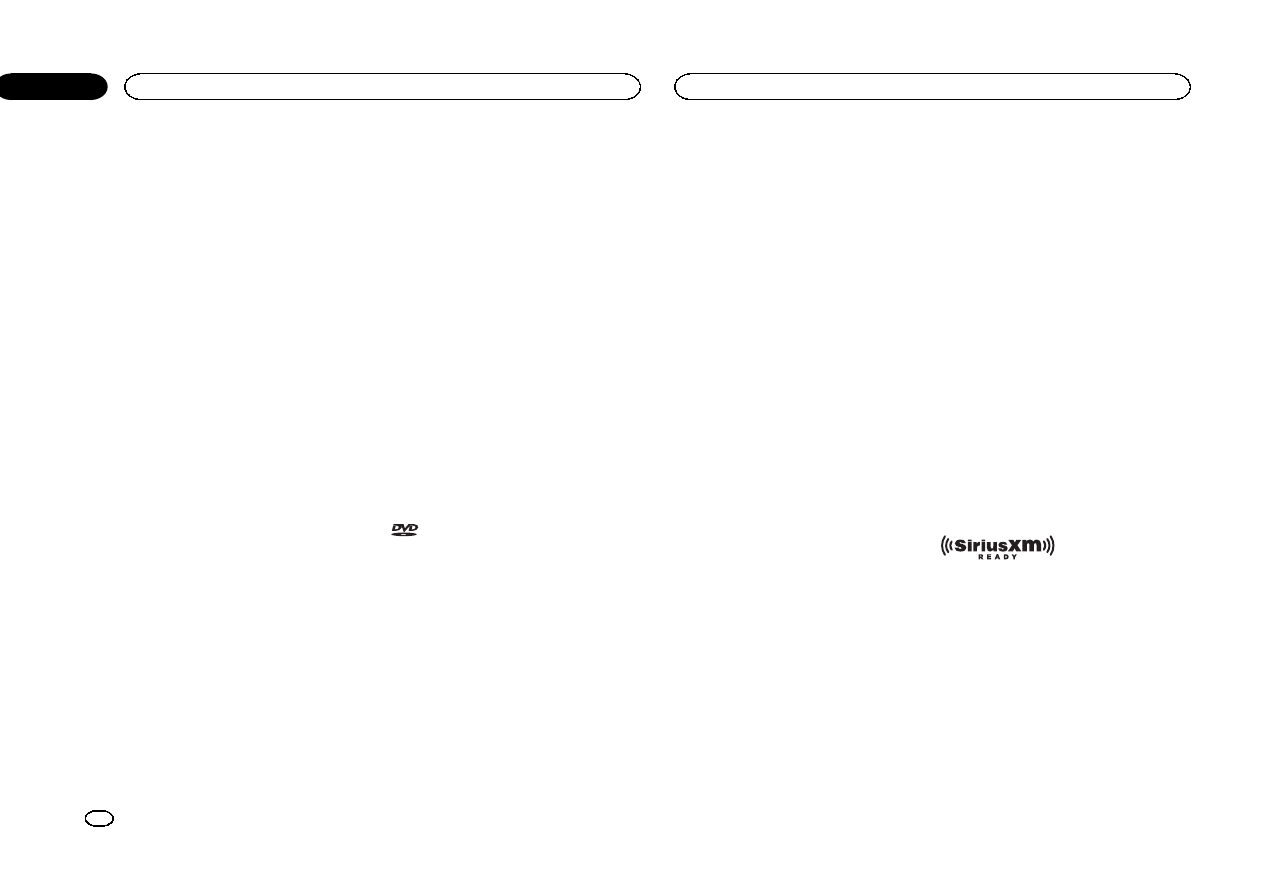
!AVRCP (Audio/Video Remote Control Profile)
1.3
!SPP (Serial Port Profile) 1.1
License, Warranty Disclaimer
& Limitation of Liability
This item incorporates copy protection technol-
ogy that is protected by U.S. patents and other
intellectual property rights of Rovi Corporation.
Reverse engineering and disassembly are pro-
hibited.
SAFETY PROVISIONS
Disclaimer
THE WARRANTIES SET FORTH IN PIONEER’S
LIMITED WARRANTY ARE THE ONLY WARRAN-
TIES MADE BY PIONEER OR ANY OF ITS LICEN-
SORS, AS APPLICABLE. PIONEER AND ITS
LICENSORS EXPRESSLY DISCLAIM ALL OTHER
WARRANTIES, EXPRESS OR IMPLIED, INCLUD-
ING, WITHOUT LIMITATION, WARRANTIES OF
MERCHANTABILITY AND FITNESS FOR A PAR-
TICULAR PURPOSE.
Limitation of Liability
TO THE MAXIMUM EXTENT PERMISSIBLE
UNDER APPLICABLE LAW, NEITHER PIONEER
NOR ITS LICENSORS WILL BE LIABLE TO YOU
OR TO ANY OTHER PARTY FOR ANY INDIRECT,
CONSEQUENTIAL, INCIDENTAL, PUNITIVE, OR
SPECIAL DAMAGES, REGARDLESS OF THE
FORM OF ACTION, WHETHER IN CONTRACT
OR IN TORT, INCLUDING NEGLIGENCE, EVEN IF
SUCH PARTIES HAVE BEEN ADVISED OF THE
POSSIBILITY OF SUCH DAMAGES.
TO THE MAXIMUM EXTENT PERMISSIBLE
UNDER APPLICABLE LAW, PIONEER’S, OR ITS
LICENSORS’, TOTAL LIABILITY OF ANY KIND
ARISING OUT OF OR RELATED TO YOUR USE
OF THE PRODUCTS, INCLUDING, BUT NOT LIM-
ITED TO, ANY WARRANTY CLAIMS, OR ANY
CLAIMS FOR PROPERTY DAMAGE, DEATH OR
DISABILITY, REGARDLESS OF THE FORUM
AND REGARDLESS OF WHETHER ANY ACTION
OR CLAIM IS BASED ON CONTRACT, TORT, (IN-
CLUDING NEGLIGENCE), STRICT PRODUCT LI-
ABILITY, OR ANY OTHER LEGAL THEORY, WILL
NOT EXCEED ONE THOUSAND DOLLARS (USD
$1 000).
SOME JURISDICTIONS DO NOT ALLOW THE
EXCLUSION OF DAMAGES OR LIMITATION OF
LIABILITY, SO THE ABOVE EXCLUSIONS OR
LIMITATIONS, TO THE EXTENT PROHIBITED BY
APPLICABLE LAW, MAY NOT APPLY TO YOU.
YOUR SPECIFIC RIGHTS MAY VARY FROM JU-
RISDICTION TO JURISDICTION.
Bluetooth
The Bluetoothâword mark and logos are regis-
tered trademarks owned by Bluetooth SIG, Inc.
and any use of such marks by PIONEER
CORPORATION is under license. Other trade-
marks and trade names are those of their re-
spective owners.
DVD video
is a trademark of DVD Format/Logo
Licensing Corporation.
iTunes
Apple and iTunes are trademarks of Apple Inc.,
registered in the U.S. and other countries.
MP3
Supply of this product only conveys a license for
private, non-commercial use and does not con-
vey a license nor imply any right to use this prod-
uct in any commercial (i.e. revenue-generating)
real time broadcasting (terrestrial, satellite,
cable and/or any other media), broadcasting/
streaming via internet, intranets and/or other
networks or in other electronic content distribu-
tion systems, such as pay-audio or audio-on-de-
mand applications. An independent license for
such use is required. For details, please visit
http://www.mp3licensing.com.
WMA
Windows Media is either a registered trademark
or trademark of Microsoft Corporation in the
United States and/or other countries.
This product includes technology owned by
Microsoft Corporation and cannot be used or
distributed without a license from Microsoft
Licensing, Inc.
iPod & iPhone
iPhone, iPod, iPod classic, iPod nano, and iPod
touch are trademarks of Apple Inc., registered in
the U.S. and other countries.
“Made for iPod”and “Made for iPhone”mean
that an electronic accessory has been designed
to connect specifically to iPod or iPhone, respec-
tively, and has been certified by the developer to
meet Apple performance standards. Apple is
not responsible for the operation of this device
or its compliance with safety and regulatory
standards. Please note that the use of this ac-
cessory with iPod or iPhone may affect wireless
performance.
Androidä
Android is a trademark of Google Inc.
BlackBerryâ
The Trademark BlackBerryâis owned by Re-
search In Motion Limited and is registered in the
United States and may be pending or registered
in other countries. PIONEER CORPORATION is
not endorsed, sponsored, affiliated with or other-
wise authorized by Research In Motion Limited.
Dolby Digital
Manufactured under license from Dolby
Laboratories. Dolby and the double-D symbol
are trademarks of Dolby Laboratories.
DivX
DivXâ, DivX Certifiedâand associated logos are
trademarks of Rovi Corporation or its subsidia-
ries and are used under license.
ABOUT DIVX VIDEO: DivXâis a digital video
format created by DivX, LLC, a subsidiary of Rovi
Corporation. This is an official DivX Certifiedâ
device that plays DivX video. Visit divx.com for
more information and software tools to convert
your files into DivX videos.
ABOUT DIVX VIDEO-ON-DEMAND: This
DivX Certifiedâdevice must be registered in
order to play purchased DivX Video-on-Demand
(VOD) movies. To obtain your registration code,
locate the DivX VOD section in Displaying the
DivXâVOD registration code. Go to vod.divx.com
for more information on how to complete your
registration.
SiriusXM Satellite Radio
SiriusXM and all related marks and logos are
trademarks of Sirius XM Radio, Inc. All rights re-
served.
Pandoraâinternet radio
PANDORA, the PANDORA logo, and the
Pandora trade dress are trademarks or regis-
tered trademarks of Pandora Media, Inc. Used
with permission.
MIXTRAX
MIXTRAX is a trademark of the PIONEER
CORPORATION.
Additional information
62
Appendix
Additional information
En
<CRD4703-A/N>62

libpng
Please be aware in advance that Pioneer will not
respond to questions concerning the contents
of the source code.
This licence was originally written in English
and translated here only to help the reader
understand its content. Therefore, please note
that translated licence is NOT legally identified
with the original English text.
This copy of the libpng notices is provided for
your convenience. In case of any discrepancy
between this copy and the notices in the file
png.h that is included in the libpng distribution,
the latter shall prevail.
COPYRIGHT NOTICE, DISCLAIMER, and LI-
CENSE:
If you modify libpng you may insert additional
notices immediately following this sentence.
This code is released under the libpng license.
libpng versions 1.2.6, August 15, 2004, through
1.5.0, January 6, 2011, are Copyright (c) 2004,
2006-2010 Glenn Randers-Pehrson, and are dis-
tributed according to the same disclaimer and li-
cense as libpng-1.2.5 with the following
individual added to the list of Contributing Au-
thors
Cosmin Truta
libpng versions 1.0.7, July 1, 2000, through 1.2.5
- October 3, 2002, are Copyright (c) 2000-2002
Glenn Randers-Pehrson, and are distributed ac-
cording to the same disclaimer and license as
libpng-1.0.6 with the following individuals added
to the list of Contributing Authors
Simon-Pierre Cadieux
Eric S. Raymond
Gilles Vollant
and with the following additions to the disclaim-
er:
There is no warranty against interference with
your enjoyment of the library or against infringe-
ment. There is no warranty that our efforts or
the library will fulfill any of your particular pur-
poses or needs. This library is provided with all
faults, and the entire risk of satisfactory quality,
performance, accuracy, and effort is with the
user.
libpng versions 0.97, January 1998, through
1.0.6, March 20, 2000, are Copyright (c) 1998,
1999 Glenn Randers-Pehrson, and are distrib-
uted according to the same disclaimer and li-
cense as libpng-0.96, with the following
individuals added to the list of Contributing Au-
thors:
Tom Lane
Glenn Randers-Pehrson
Willem van Schaik
libpng versions 0.89, June 1996, through 0.96,
May 1997, are Copyright (c) 1996, 1997 Andreas
Dilger Distributed according to the same dis-
claimer and license as libpng-0.88, with the fol-
lowing individuals added to the list of
Contributing Authors:
John Bowler
Kevin Bracey
Sam Bushell
Magnus Holmgren
Greg Roelofs
Tom Tanner
libpng versions 0.5, May 1995, through 0.88, Jan-
uary 1996, are Copyright (c) 1995, 1996 Guy Eric
Schalnat, Group 42, Inc.
For the purposes of this copyright and license,
"Contributing Authors" is defined as the follow-
ing set of individuals:
Andreas Dilger
Dave Martindale
Guy Eric Schalnat
Paul Schmidt
Tim Wegner
The PNG Reference Library is supplied "AS IS".
The Contributing Authors and Group 42, Inc. dis-
claim all warranties, expressed or implied, in-
cluding, without limitation, the warranties of
merchantability and of fitness for any purpose.
The Contributing Authors and Group 42, Inc. as-
sume no liability for direct, indirect, incidental,
special, exemplary, or consequential damages,
which may result from the use of the PNG Refer-
ence Library, even if advised of the possibility of
such damage.
Permission is hereby granted to use, copy, modi-
fy, and distribute this source code, or portions
hereof, for any purpose, without fee, subject to
the following restrictions:
1. The origin of this source code must not be
misrepresented.
2. Altered versions must be plainly marked as
such and must not be misrepresented as being
the original source.
3. This Copyright notice may not be removed or
altered from any source or altered source distri-
bution.
The Contributing Authors and Group 42, Inc.
specifically permit, without fee, and encourage
the use of this source code as a component to
supporting the PNG file format in commercial
products. If you use this source code in a prod-
uct, acknowledgment is not required but would
be appreciated.
A "png_get_copyright" function is available, for
convenient use in "about" boxes and the like:
printf("%s",png_get_copyright(NULL));
Also, the PNG logo (in PNG format, of course) is
supplied in the files "pngbar.png" and
"pngbar.jpg (88x31) and "pngnow.png" (98x31).
Libpng is OSI Certified Open Source Software.
OSI Certified Open Source is a certification
mark of the Open Source Initiative.
Glenn Randers-Pehrson
glennrp at users.sourceforge.net
January 6, 2011
English
Additional information
63
Appendix
Additional information
En
<CRD4703-A/N>63
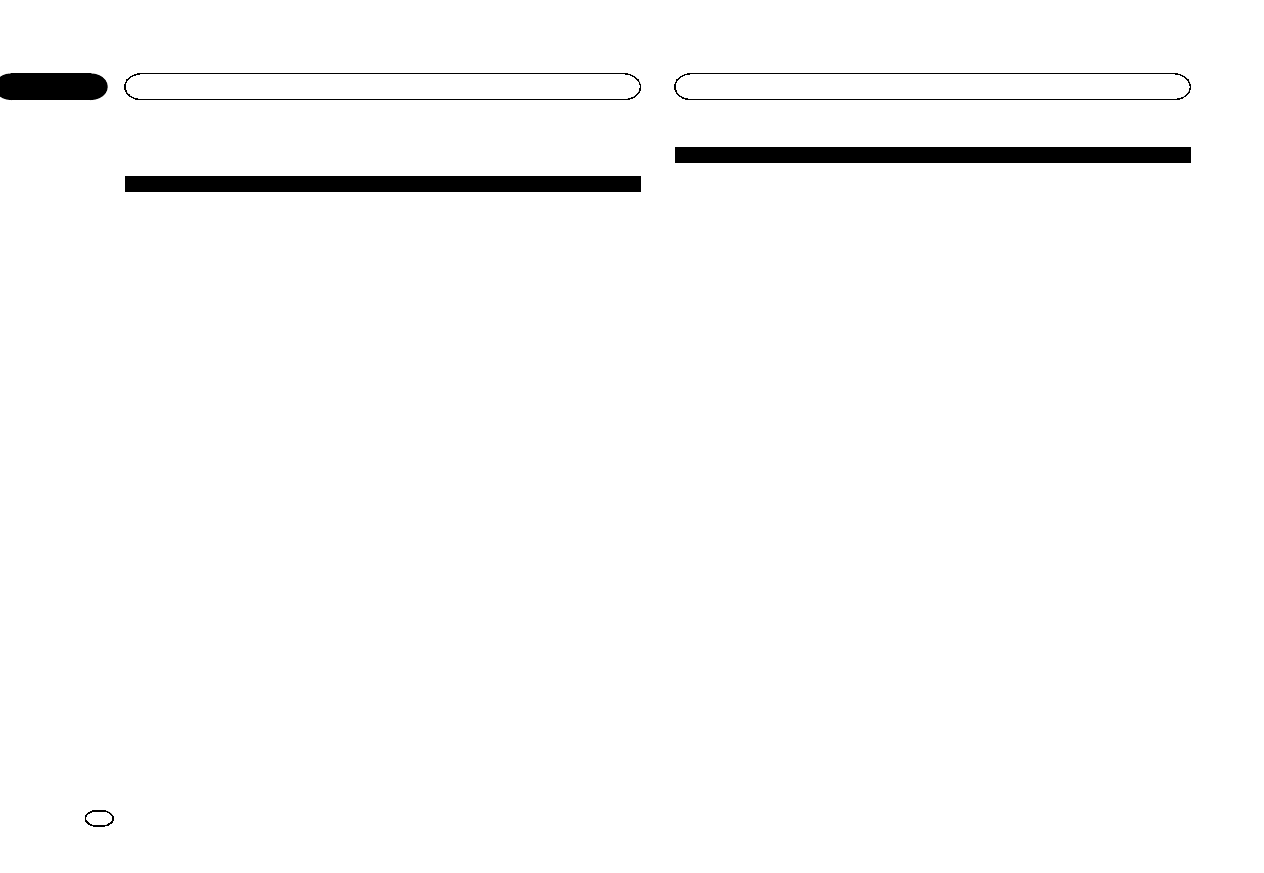
Language code chart for DVD
Language (code), input code
Japanese (ja), 1001 Dzongkha (dz), 0426 Kurdish (ku), 1121 Kinyarwanda (rw), 1823
English (en), 0514 Ewe (ee), 0505 Komi (kv), 1122 Sanskrit (sa), 1901
French (fr), 0618 Esperanto (eo), 0515 Cornish (kw), 1123 Sardinian (sc), 1903
Spanish (es), 0519 Estonian (et), 0520 Kirghiz, Kyrgyz (ky),
1125 Sindhi (sd), 1904
German (de), 0405 Basque (eu), 0521 Latin (la), 1201 Northern Sami (se),
1905
Italian (it), 0920 Persian (fa), 0601 Luxembourgish (lb),
1202 Sangho (sg), 1907
Chinese (zh), 2608 Fulah (ff), 0606 Ganda (lg), 1207 Sinhala (si), 1909
Dutch, Flemish (nl),
1412 Finnish (fi), 0609 Limburgan (li), 1209 Slovak (sk), 1911
Portuguese (pt), 1620 Fijian (fj), 0610 Lingala (ln), 1214 Slovenian (sl), 1912
Swedish (sv), 1922 Faroese (fo), 0615 Lao (lo), 1215 Samoan (sm), 1913
Russian (ru), 1821 Western Frisian (fy),
0625 Lithuanian (lt), 1220 Shona (sn), 1914
Korean (ko), 1115 Irish (ga), 0701 Luba-Katanga (lu), 1221 Somali (so), 1915
Greek (el), 0512 Gaelic (gd), 0704 Latvian (lv), 1222 Albanian (sq), 1917
Afar (aa), 0101 Galician (gl), 0712 Malagasy (mg), 1307 Serbian (sr), 1918
Abkhazian (ab), 0102 Guarani (gn), 0714 Marshallese (mh), 1308 Swati (ss), 1919
Avestan (ae), 0105 Gujarati (gu), 0721 Maori (mi), 1309 Sotho, Southern (st),
1920
Afrikaans (af), 0106 Manx (gv), 0722 Macedonian (mk), 1311 Sundanese (su), 1921
Akan (ak), 0111 Hausa (ha), 0801 Malayalam (ml), 1312 Swahili (sw), 1923
Amharic (am), 0113 Hebrew (he), 0805 Mongolian (mn), 1314 Tamil (ta), 2001
Aragonese (an), 0114 Hindi (hi), 0809 Marathi (mr), 1318 Telugu (te), 2005
Arabic (ar), 0118 Hiri Motu (ho), 0815 Malay (ms), 1319 Tajik (tg), 2007
Assamese (as), 0119 Croatian (hr), 0818 Maltese (mt), 1320 Thai (th), 2008
Avaric (av), 0122 Haitian (ht), 0820 Burmese (my), 1325 Tigrinya (ti), 2009
Aymara (ay), 0125 Hungarian (hu), 0821 Nauru (na), 1401 Turkmen (tk), 2011
Azerbaijani (az), 0126 Armenian (hy), 0825 Bokmal (nb), 1402 Tagalog (tl), 2012
Bashkir (ba), 0201 Herero (hz), 0826 Ndebele, North (nd),
1404 Tswana (tn), 2014
Belarusian (be), 0205 Interlingua (ia), 0901 Nepali (ne), 1405 Tonga (to), 2015
Bulgarian (bg), 0207 Indonesian (id), 0904 Ndonga (ng), 1407 Turkish (tr), 2018
Bihari (bh), 0208 Interlingue (ie), 0905 Nynorsk (nn), 1414 Tsonga (ts), 2019
Bislama (bi), 0209 Igbo (ig), 0907 Norwegian (no), 1415 Tatar (tt), 2020
Bambara (bm), 0213 Sichuan Yi (ii), 0909 Ndebele, South (nr),
1418 Twi (tw), 2023
Language (code), input code
Bengali (bn), 0214 Inupiaq (ik), 0911 Navajo, Navaho (nv),
1422 Tahitian (ty), 2025
Tibetan (bo), 0215 Ido (io), 0915 Chichewa (ny), 1425 Uighur, Uyghur (ug),
2107
Breton (br), 0218 Icelandic (is), 0919 Occitan (oc), 1503 Ukrainian (uk), 2111
Bosnian (bs), 0219 Inuktitut (iu), 0921 Ojibwa (oj), 1510 Urdu (ur), 2118
Catalan (ca), 0301 Javanese (jv), 1022 Oromo (om), 1513 Uzbek (uz), 2126
Chechen (ce), 0305 Georgian (ka), 1101 Oriya (or), 1518 Venda (ve), 2205
Chamorro (ch), 0308 Kongo (kg), 1107 Ossetian (os), 1519 Vietnamese (vi), 2209
Corsican (co), 0315 Kikuyu, Gikuyu (ki), 1109 Panjabi, Punjabi (pa),
1601 Volapük (vo), 2215
Cree (cr), 0318 Kuanyama (kj), 1110 Pali (pi), 1609 Walloon (wa), 2301
Czech (cs), 0319 Kazakh (kk), 1111 Polish (pl), 1612 Wolof (wo), 2315
Church Slavic (cu), 0321 Kalaallisut (kl), 1112 Pashto, Pushto (ps),
1619 Xhosa (xh), 2408
Chuvash (cv), 0322 Central Khmer (km),
1113 Quechua (qu), 1721 Yiddish (yi), 2509
Welsh (cy), 0325 Kannada (kn), 1114 Romansh (rm), 1813 Yoruba (yo), 2515
Danish (da), 0401 Kanuri (kr), 1118 Rundi (rn), 1814 Zhuang, Chuang (za),
2601
Divehi (dv), 0422 Kashmiri (ks), 1119 Romanian (ro), 1815 Zulu (zu), 2621
Additional information
64
Appendix
Additional information
En
<CRD4703-A/N>64

Specifications
General
Power source ................... 14.4 V DC (10.8 V to 15.1 V al-
lowable)
Grounding system ............ Negative type
Maximum current consumption
................................... 10.0 A
Dimensions (W × H × D):
D
Chassis .............. 178 mm × 100mm ×
165 mm
(7 in. × 3-7/8 in. × 6-1/2 in.)
Nose .................. 171mm × 97mm ×
18 mm
(6-3/4 in. × 3-7/8 in. × 3/4 in.)
(AVH-X5500BHS/AVH-X4500BT)
Nose .................. 171 mm×97mm×9mm
(6-3/4 in. × 3-7/8 in. × 3/8 in.)
(AVH-X3500BHS/AVH-X2500BT/AVH-
X1500DVD)
Weight ............................. 2.0kg (4.4 lbs)
(AVH-X5500BHS/AVH-X4500BT)
Weight ............................. 1.7 kg (3.7 lbs)
(AVH-X3500BHS/AVH-X2500BT/AVH-X1500DVD)
Display
Screen size/aspect ratio ... 6.95 inch wide/16:9
(effective display area:
156.6 mm × 81.6 mm)
(AVH-X5500BHS/AVH-X4500BT)
Screen size/aspect ratio ... 6.1 inch wide/16:9
(effective display area:
136.2 mm × 72.0 mm)
(AVH-X3500BHS/AVH-X2500BT/AVH-X1500DVD)
Pixels ............................... 1 152000 (2400 × 480)
Display method ................ TFTactive matrix, driving type
Color system .................... NTSC/PAL/PAL-M/PAL-N/
SECAM compatible
Durable temperature range (power off)
................................... –4 °F to +176 °F
Audio
Maximum power output ... 50 W × 4
70 W × 1/2 W(for subwoofer)
Continuous power output
................................... 22W × 4 (50Hz to 15000 Hz,
5 % THD, 4 Wload, both chan-
nels driven)
Load impedance .............. 4 W(4 Wto 8 W(2 Wfor 1 ch)
allowable)
Preout maximum output level
................................... 4.0 V
(AVH-X5500BHS/AVH-X4500BT)
Preout maximum output level
................................... 2.0 V
(AVH-X3500BHS/AVH-X2500BT/AVH-X1500DVD)
Equalizer (8-Band Graphic Equalizer):
Frequency ................. 40 Hz/80 Hz/200 Hz/400 Hz/
1 kHz/2.5 kHz/8 kHz/10 kHz
Gain ......................... ±12 dB
HPF:
Frequency ................. 50 Hz/63 Hz/80 Hz/100 Hz/
125 Hz
Slope ........................ –12 dB/oct
Subwoofer (mono):
Frequency ................. 50 Hz/63 Hz/80 Hz/100 Hz/
125 Hz
Slope ........................ –18 dB/oct
Gain ......................... +6dB to –24 dB
Phase ....................... Normal/Reverse
Bass boost:
Gain ......................... +12 dB to 0 dB
DVD Player
System ............................ DVD video, Video CD, CD,
WMA, MP3, AAC, DivX, JPEG,
MPEG player
Usable discs .................... DVD video, Video CD, CD, CD-
R/RW, DVD-R/RW/R DL
Region number ................ 1
Frequency response ......... 5 Hz to 44 000 Hz (with DVD,
at sampling frequency 96 kHz)
Signal-to-noise ratio ......... 96dB (1kHz) (IHF-A network)
(RCA level)
(AVH-X5500BHS/AVH-X4500BT)
Signal-to-noise ratio ......... 91 dB (1 kHz) (IHF-A network)
(RCA level)
(AVH-X3500BHS/AVH-X2500BT/AVH-X1500DVD)
Output level:
Video ........................ 1.0 Vp-p/75 W(±0.2 V)
Number of channels ........ 2 (stereo)
MP3 decoding format ...... MPEG-1 & 2 Audio Layer 3
WMA decoding format ..... Ver. 7, 7.1, 8, 9, 10, 11, 12 (2 ch
audio)
(Windows Media Player)
AAC decoding format ....... MPEG-4 AAC (iTunes encoded
only) (.m4a)
(Ver. 10.6 and earlier)
JPEG:
JPEG decoding format
............................ .jpeg, .jpg, .jpe
Pixel Sampling .......... 4:2:2, 4:2:0
Decode Size .............. MAX:8192(H) x 7 680(W),
MIN:32(H) x 32(W)
DivX decoding format ....... Home Theater Ver. 3, 4, 5.2, 6
(Except ultra and HD) (.avi,
.divx)
MPEG video decoding format
................................... MPEG1, MPEG2, MPEG4
USB
USB standard specification
................................... USB 1.1, USB 2.0 full speed
(For video files)
USB 2.0 high speed (For
audio files)
Maximum current supply
................................... 1.0 A
USB Class ....................... MSC (Mass Storage Class)
File system ....................... FAT16, FAT32
MP3 decoding format ...... MPEG-1 & 2 Audio Layer 3
WMA decoding format ..... Ver. 7, 7.1, 8, 9, 10, 11, 12 (2 ch
audio)
(Windows Media Player)
AAC decoding format ....... MPEG-4 AAC (iTunes encoded
only)
(Ver. 10.6 and earlier)
WAV:
WAV signal format .... Linear PCM, MS ADPCM
(.wav)
Sampling Frequency
............................ Linear PCM:16 kHz,
22.05 kHz, 24 kHz, 32 kHz,
44.1 kHz, 48 kHz
MS ADPCM:22.05 kHz,
44.1 kHz
JPEG:
JPEG decoding format
............................ .jpeg, .jpg, .jpe
Pixel Sampling .......... 4:2:2, 4:2:0
Decode Size .............. MAX:8192(H) x 7 680(W),
MIN:32(H) x 32(W)
DivX decoding format ....... Home Theater Ver. 3, 4, 5.2, 6
(Except ultra and HD) (.avi,
.divx)
MPEG video decoding format
................................... MPEG1, MPEG2, MPEG4
FM tuner
Frequency range .............. 87.9 MHz to 107.9 MHz
Usable sensitivity ............. 9dBf (0.8 µV/75 W, mono, S/N:
30 dB)
Signal-to-noise ratio ......... 80 dB (digital broadcasting)
(IHF-A network)
(AVH-X5500BHS/AVH-X3500BHS)
Signal-to-noise ratio ......... 72 dB (analog broadcasting)
(IHF-A network)
AM tuner
Frequency range .............. 530 kHz to 1 710kHz (10 kHz)
Usable sensitivity ............. 25µV (S/N: 20 dB)
Signal-to-noise ratio ......... 80 dB (digital broadcasting)
(IHF-A network)
(AVH-X5500BHS/AVH-X3500BHS)
Signal-to-noise ratio ......... 62 dB (analog broadcasting)
(IHF-A network)
Bluetooth
(AVH-X5500BHS/AVH-X4500BT/AVH-X3500BHS/AVH-
X2500BT)
Version ............................ Bluetooth 3.0 certified
Output power ................... +4dBm Maximum
(Power class 2)
CEA2006 Specifications
Power output ................... 14 W RMS × 4 Channels (4 W
and ≦1 % THD+N)
S/N ratio .......................... 91dBA (reference: 1 W into
4W)
Note
Specifications and the design are subject to
modifications without notice.
English
Additional information
65
Appendix
Additional information
En
<CRD4703-A/N>65
